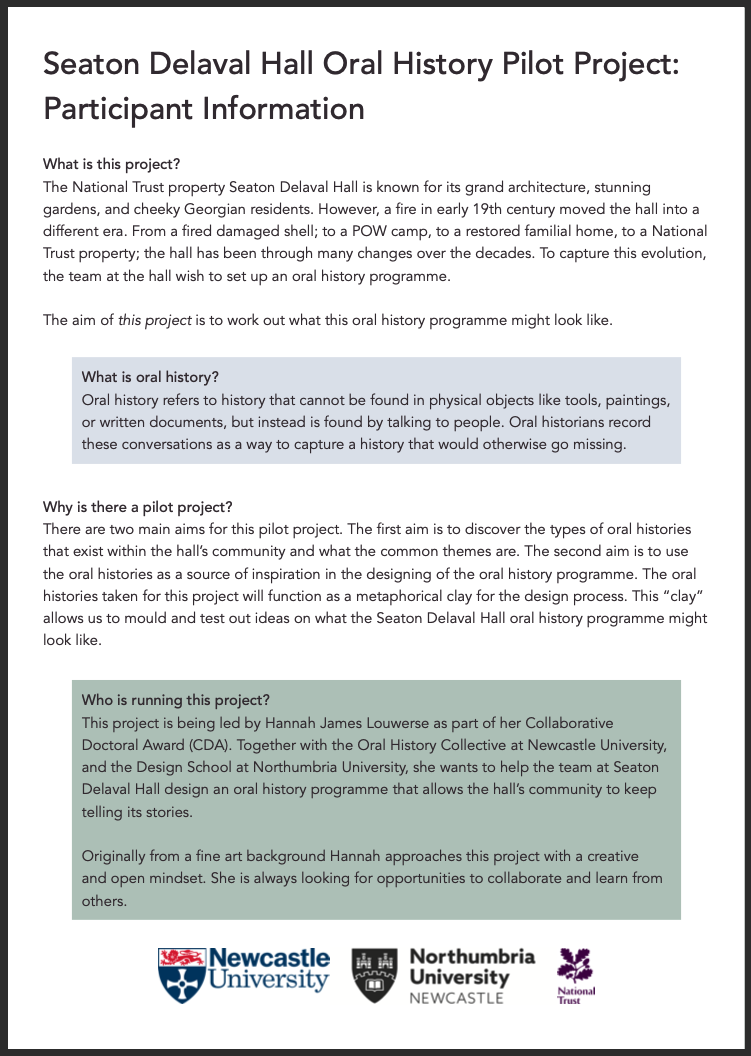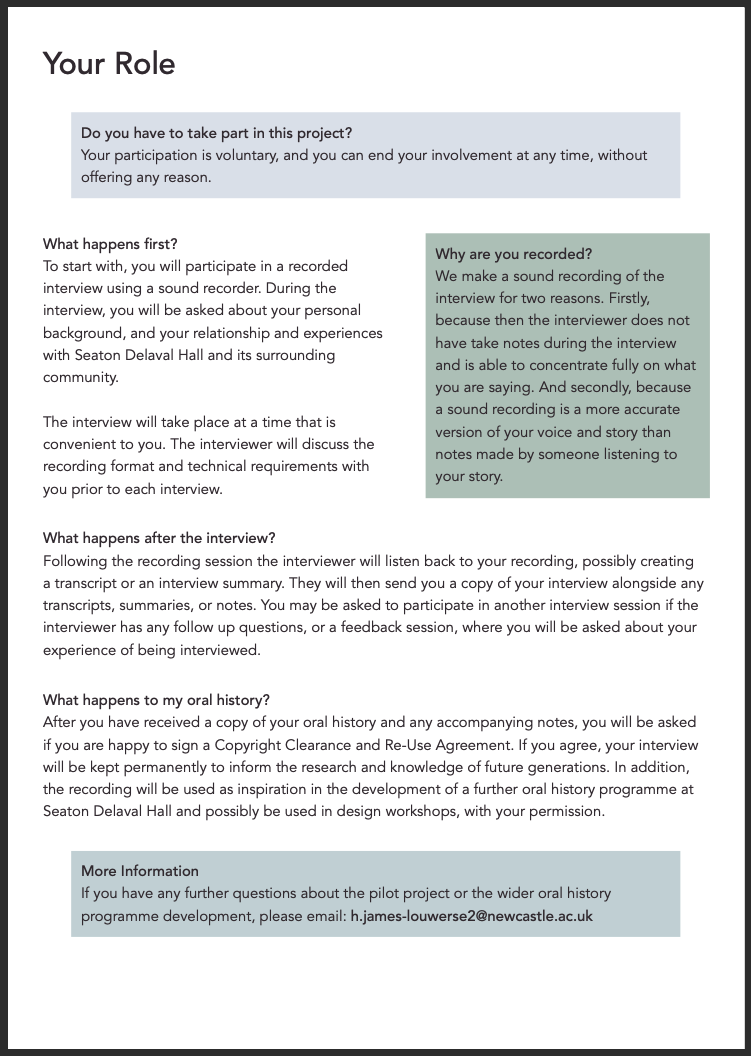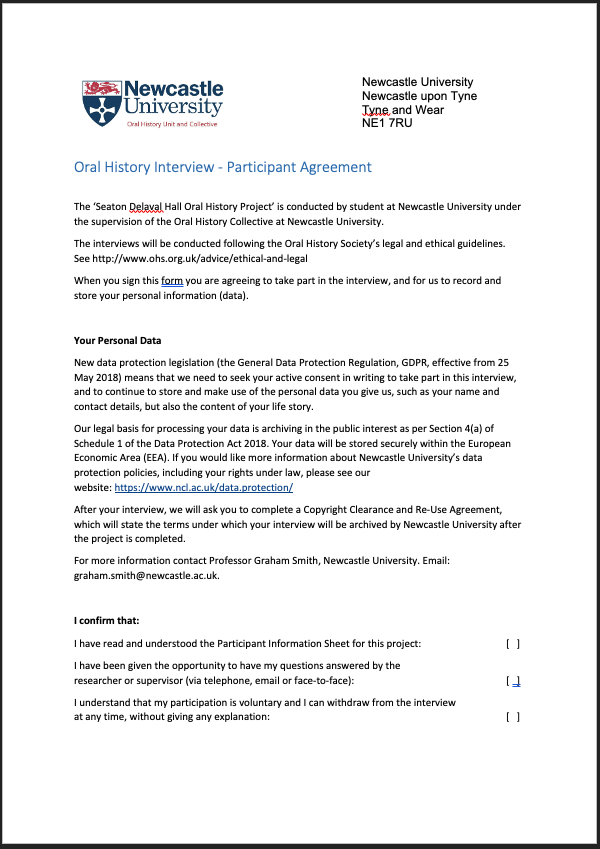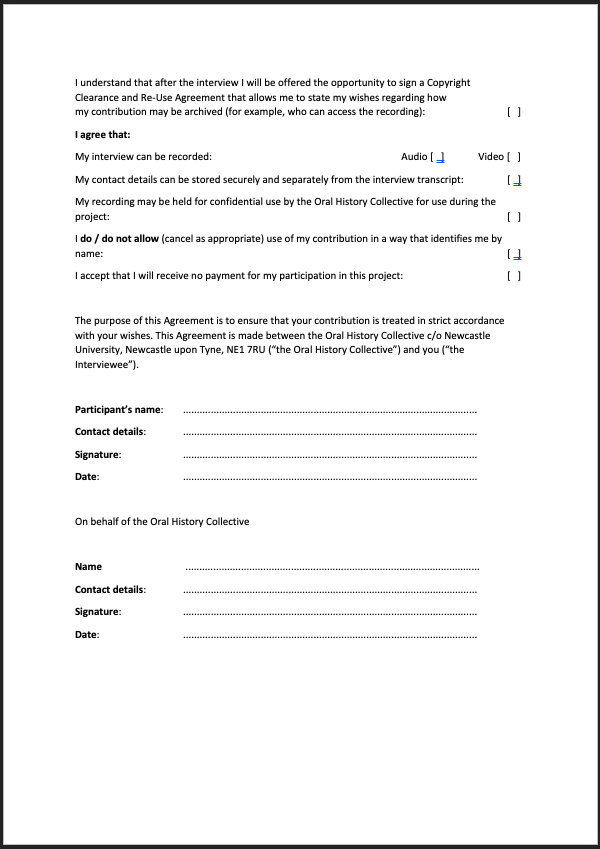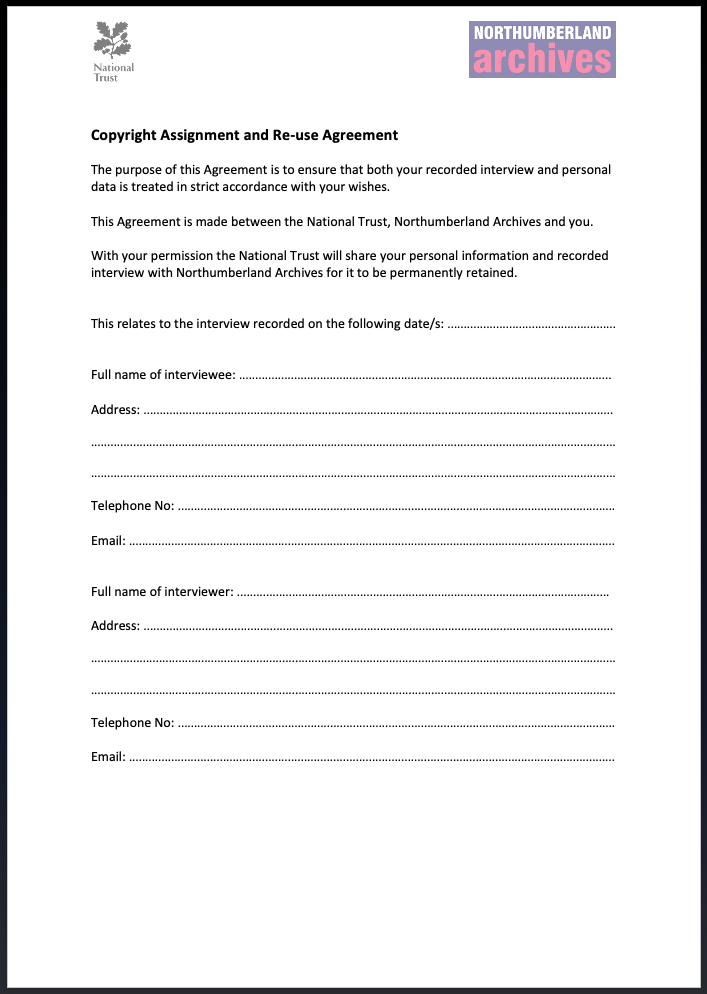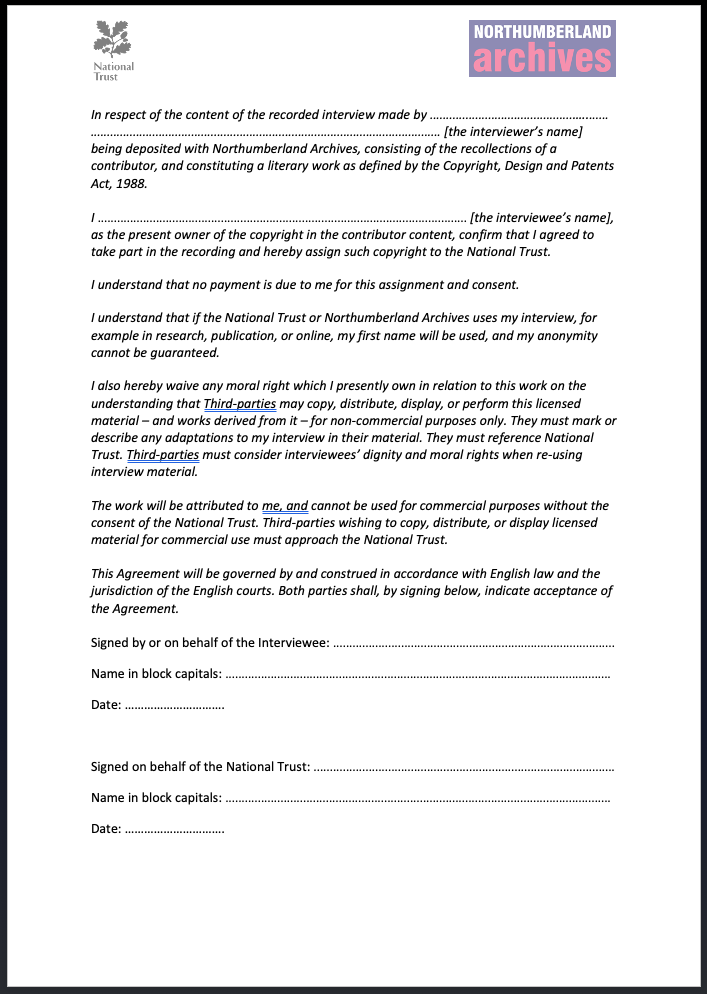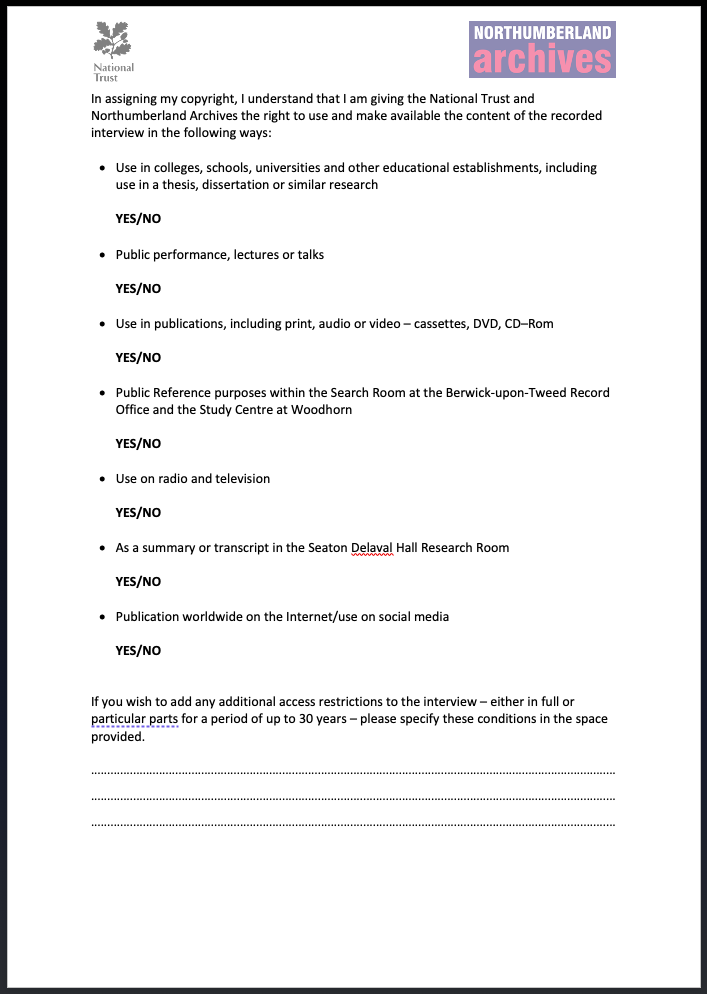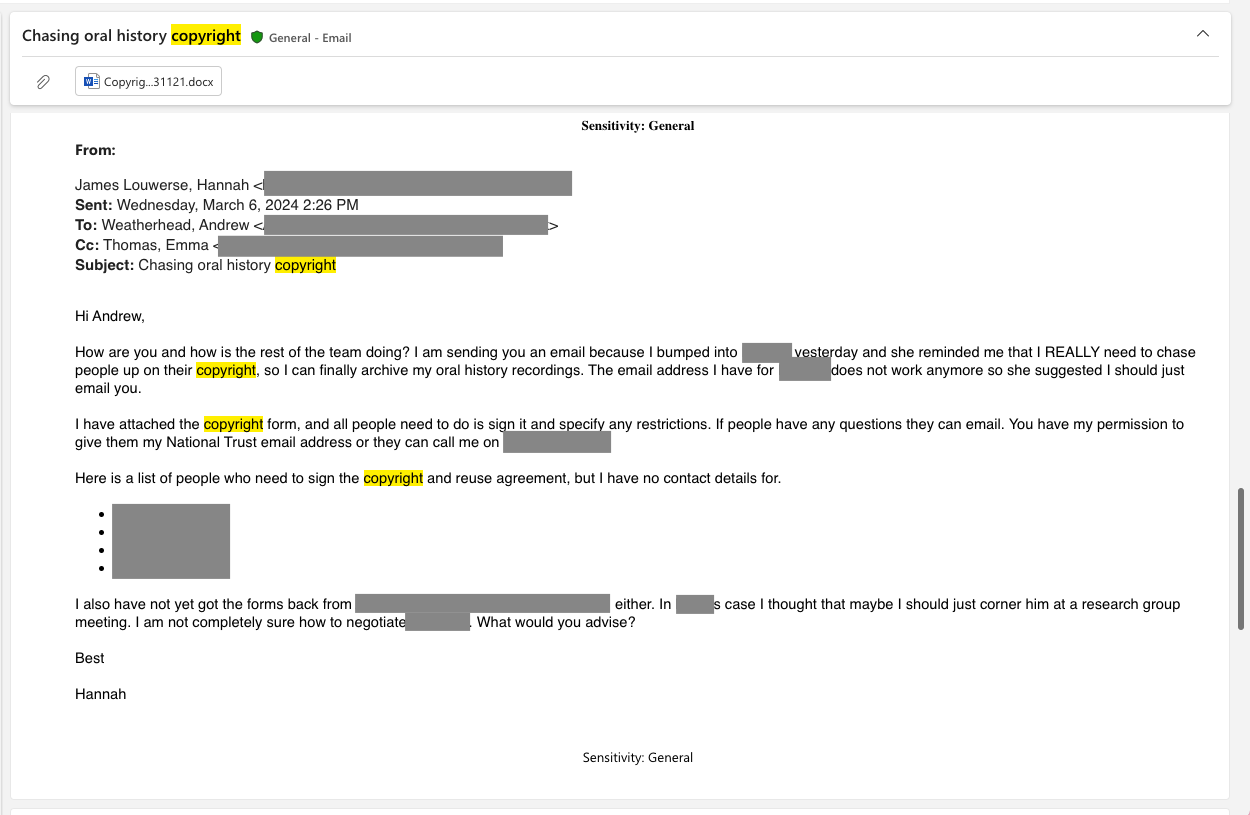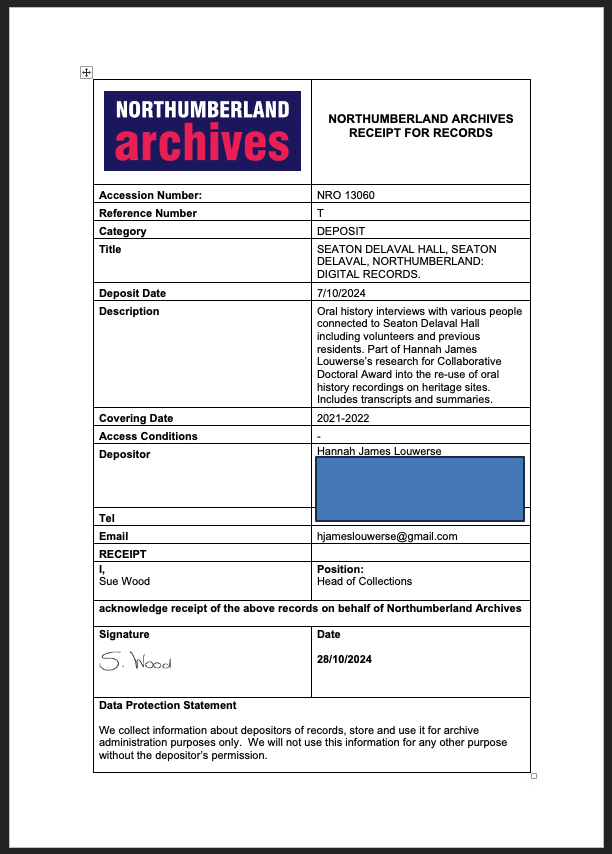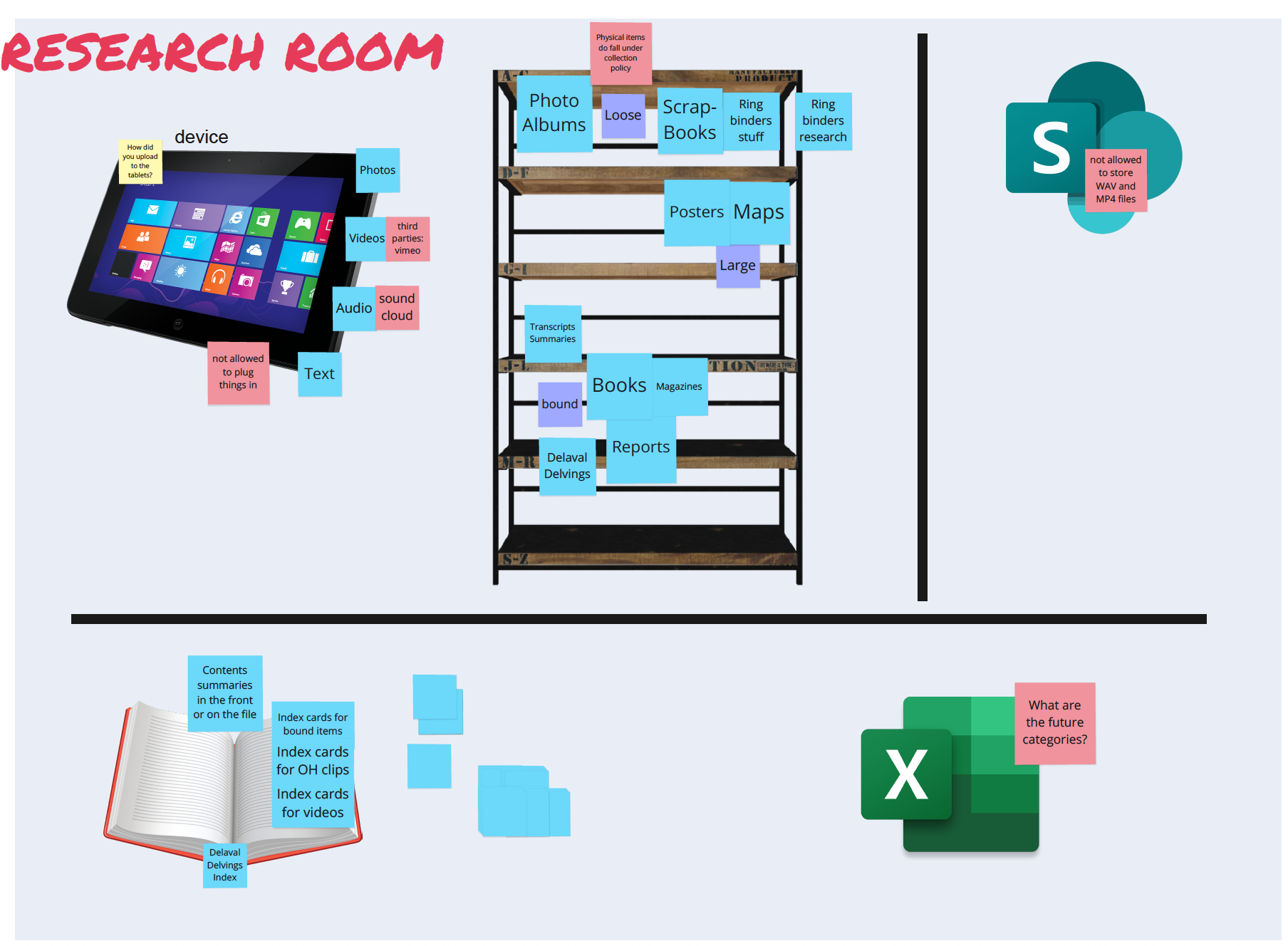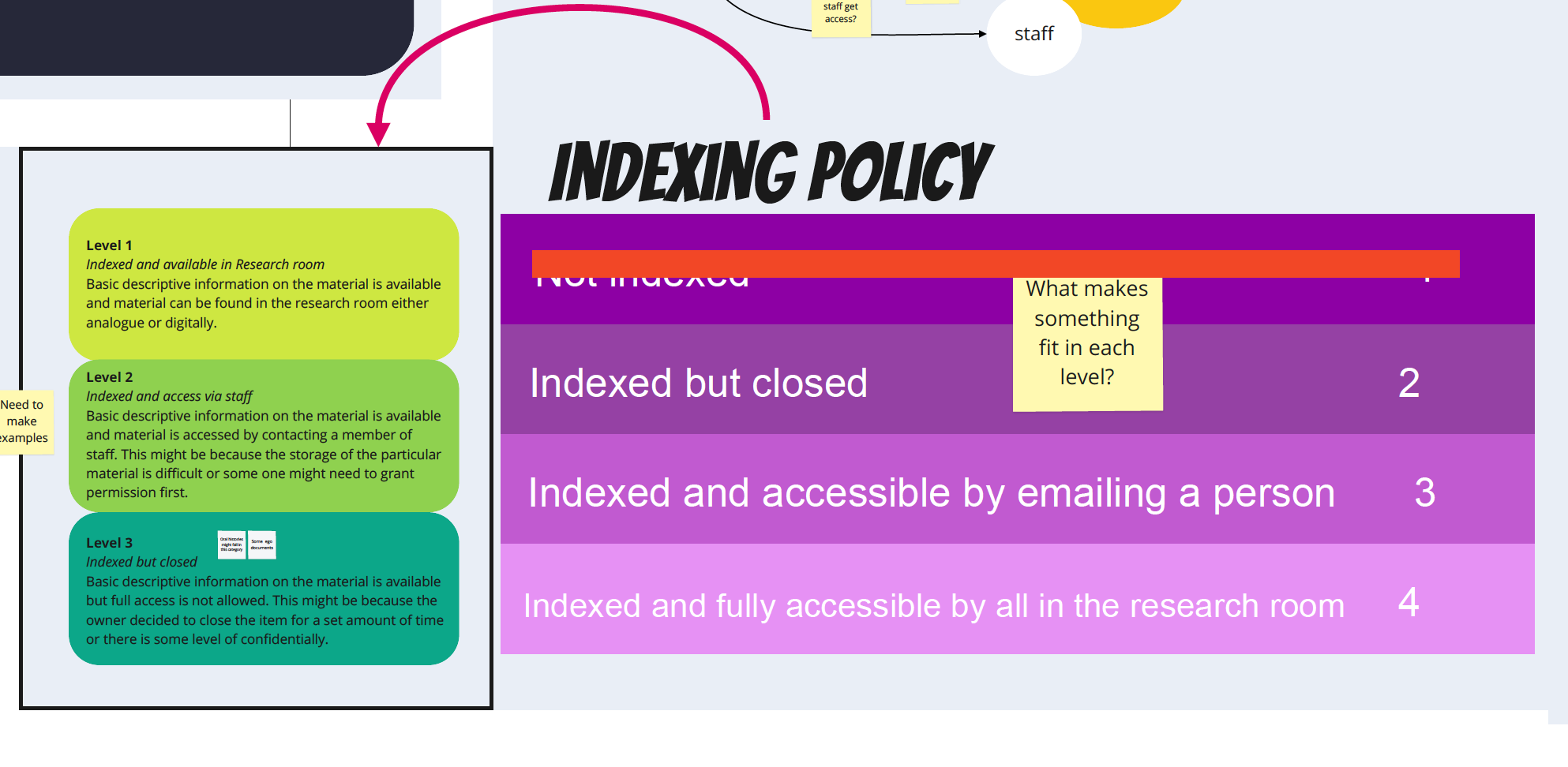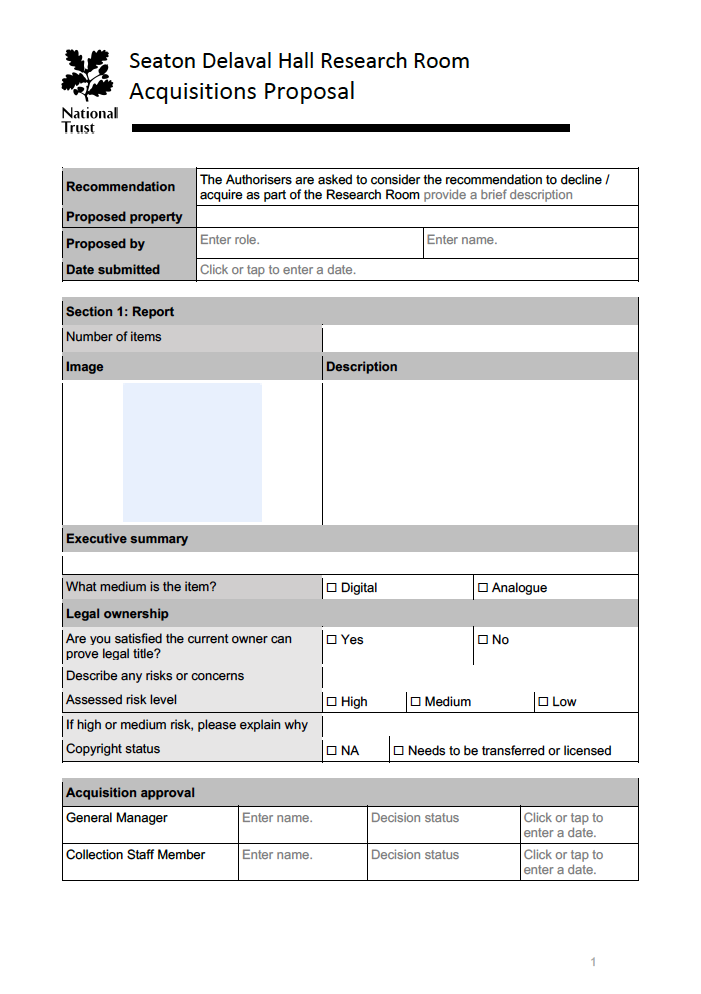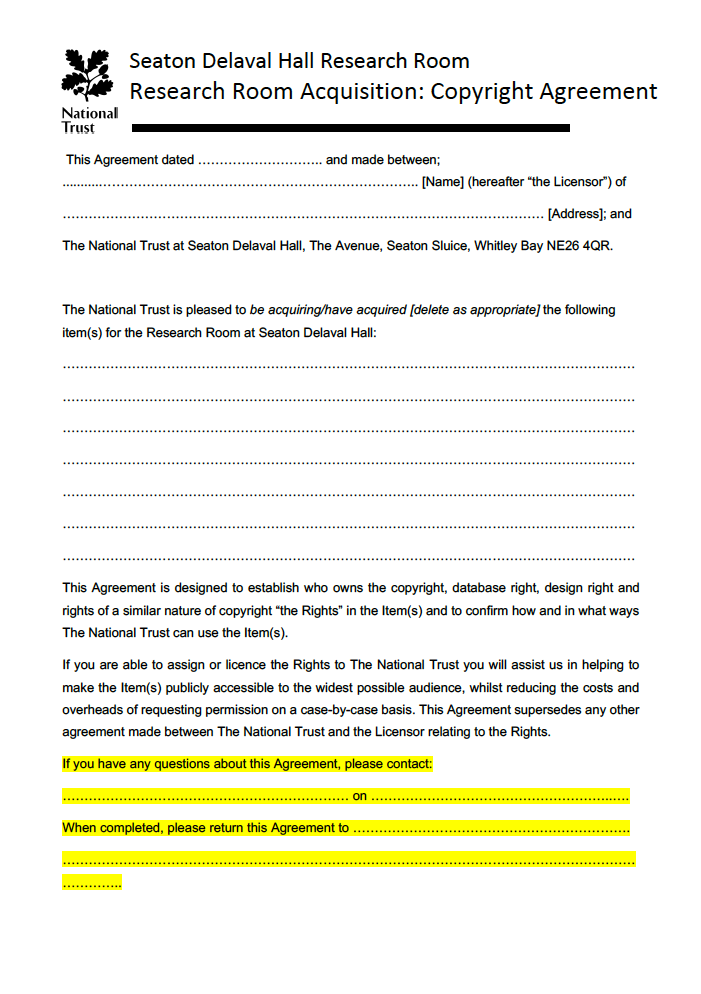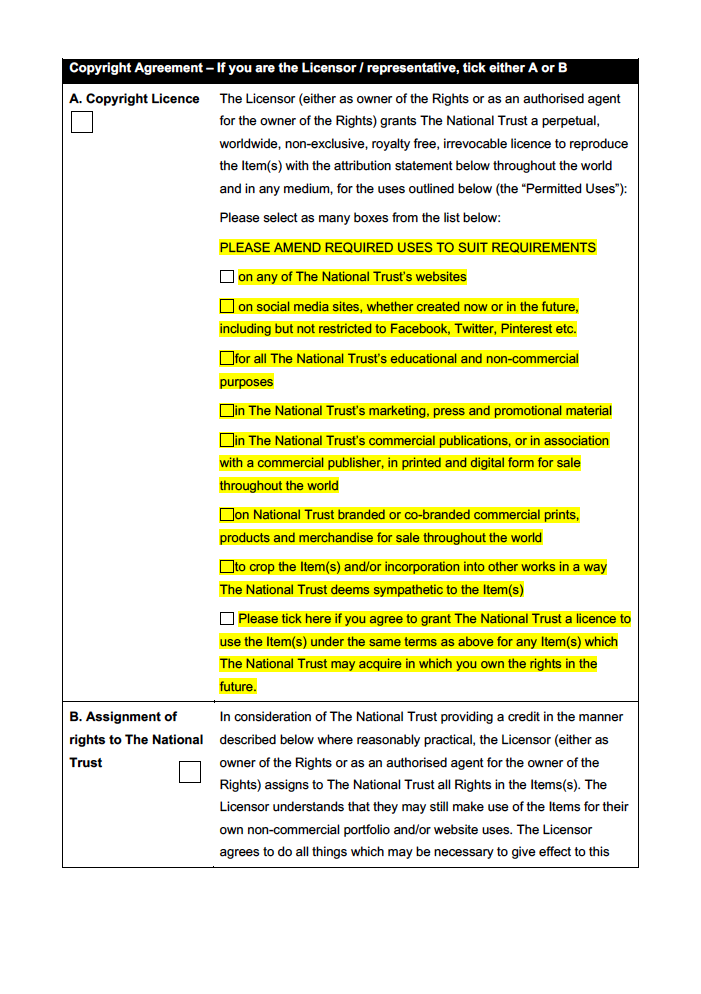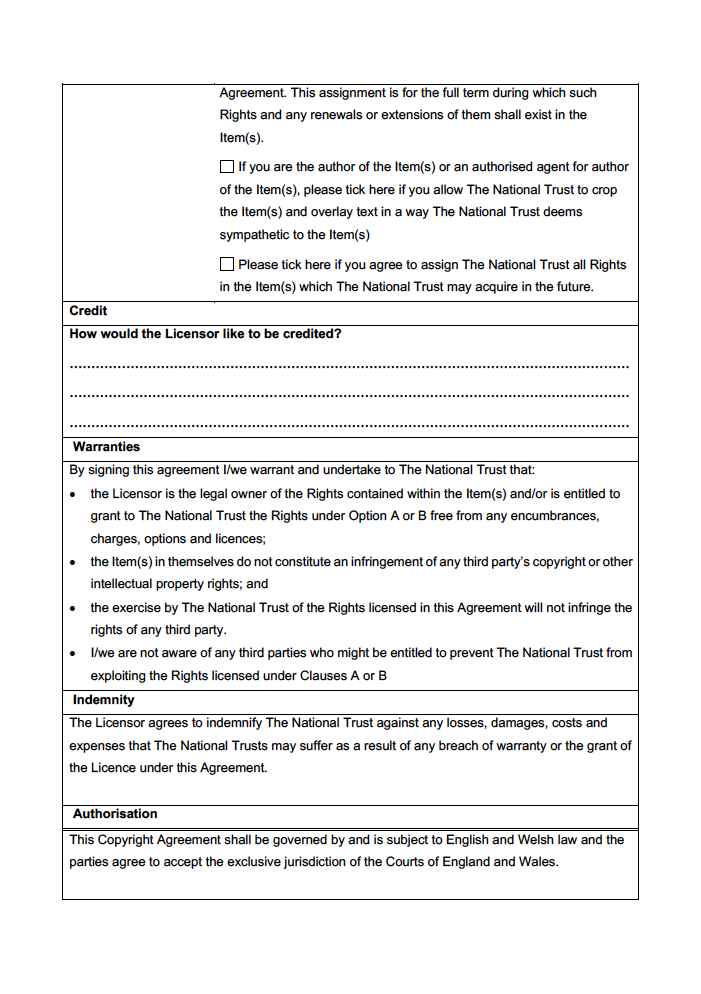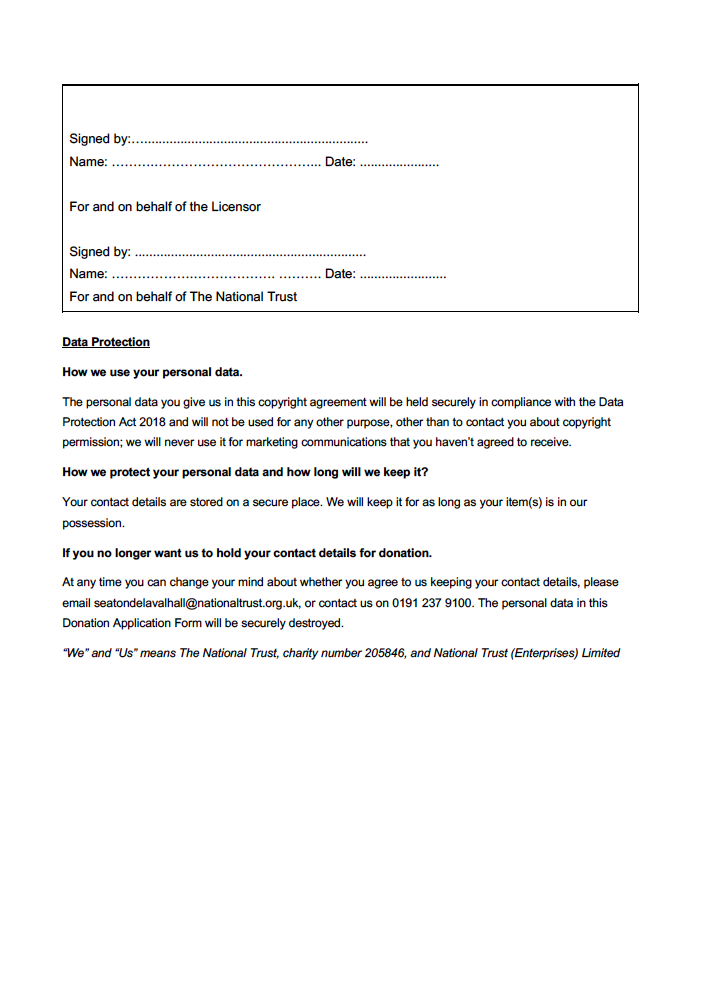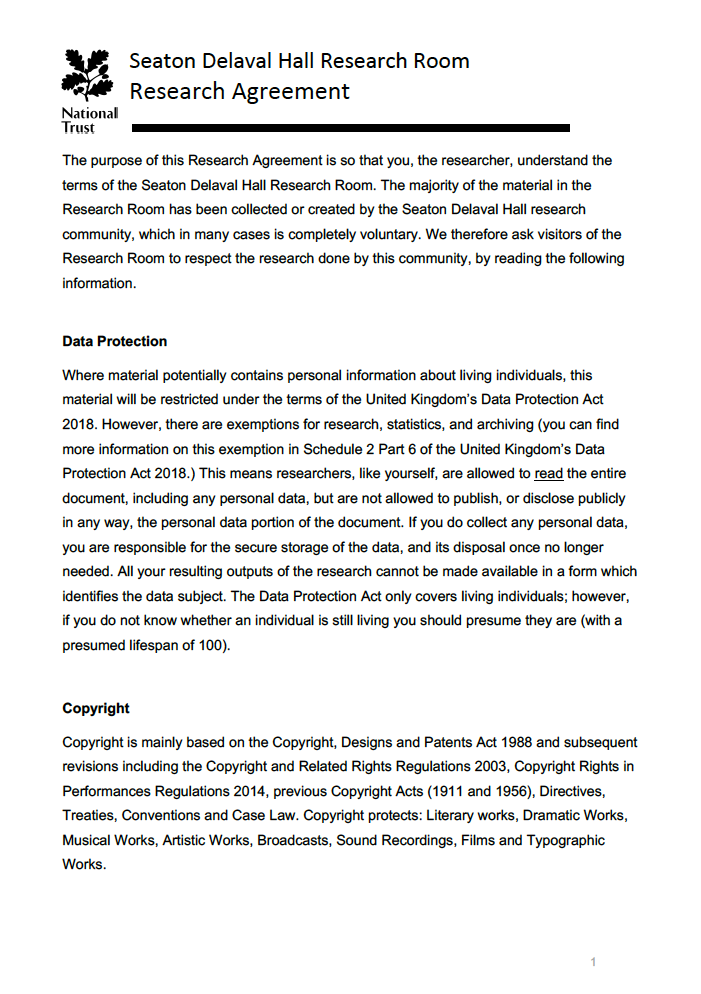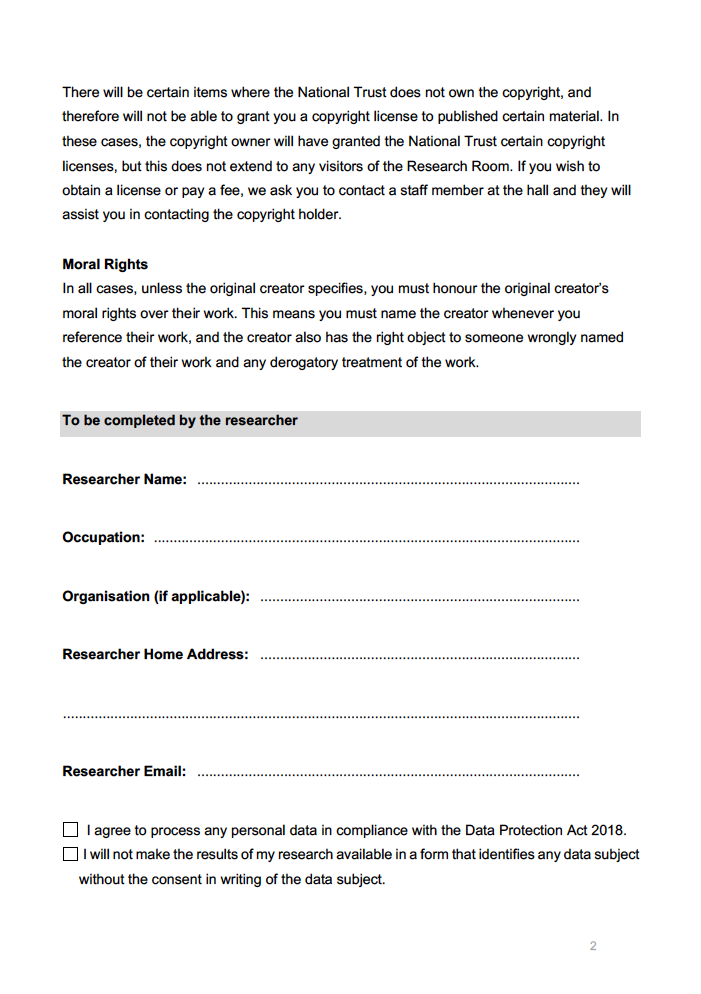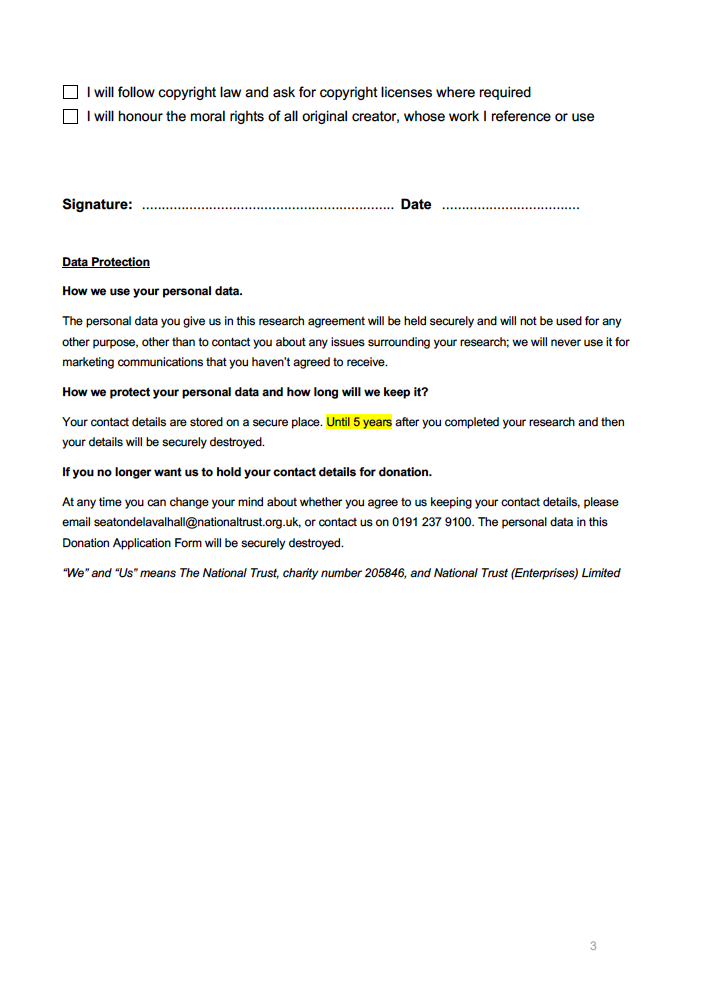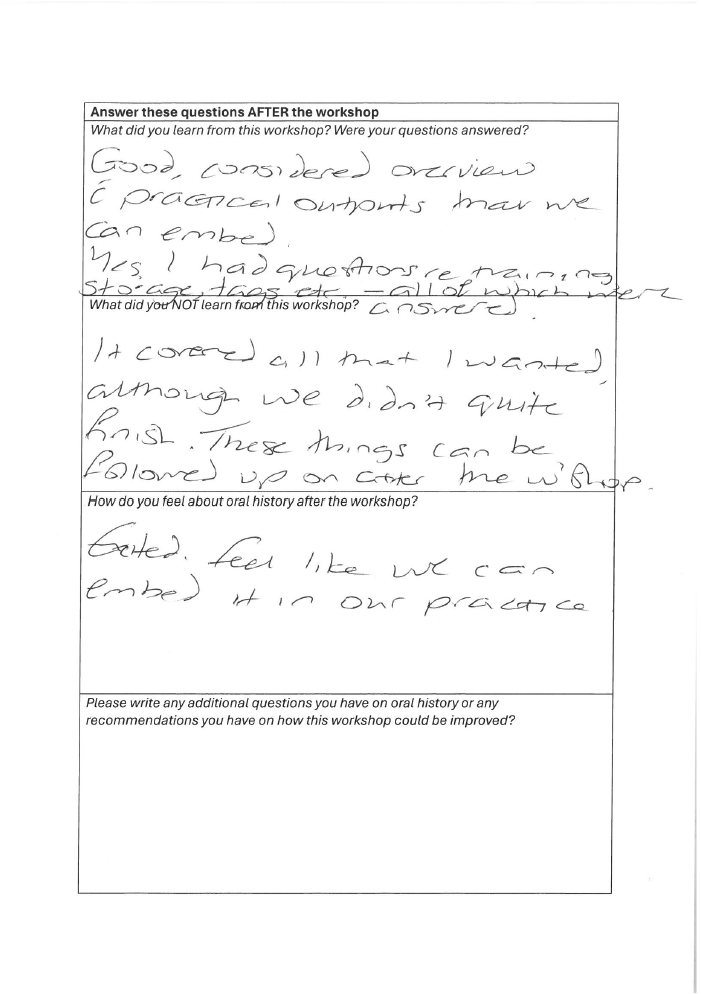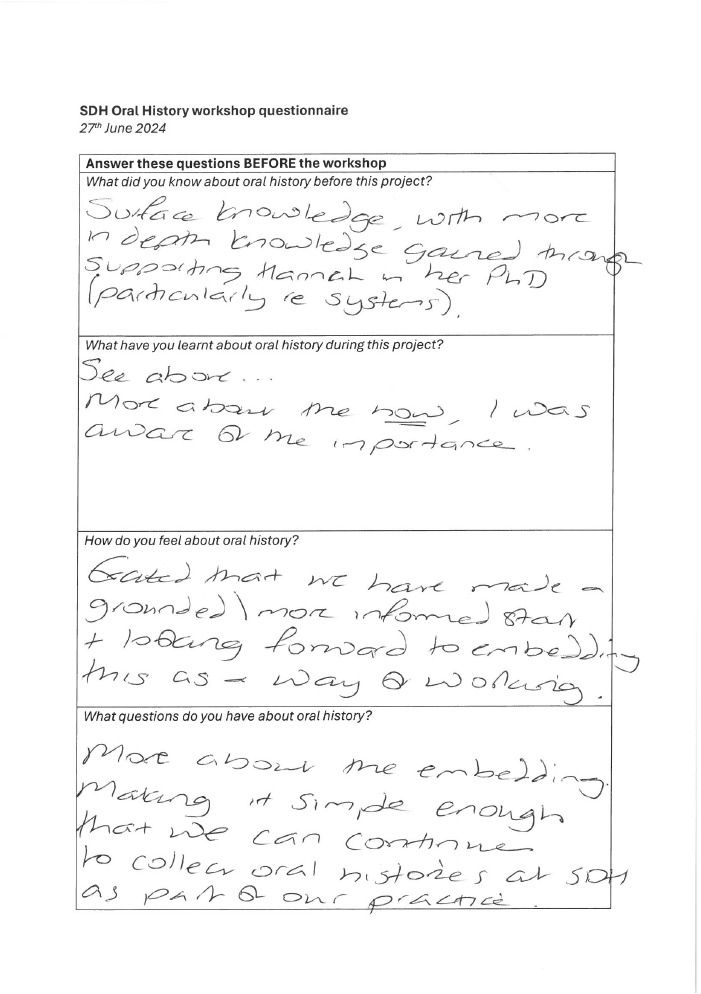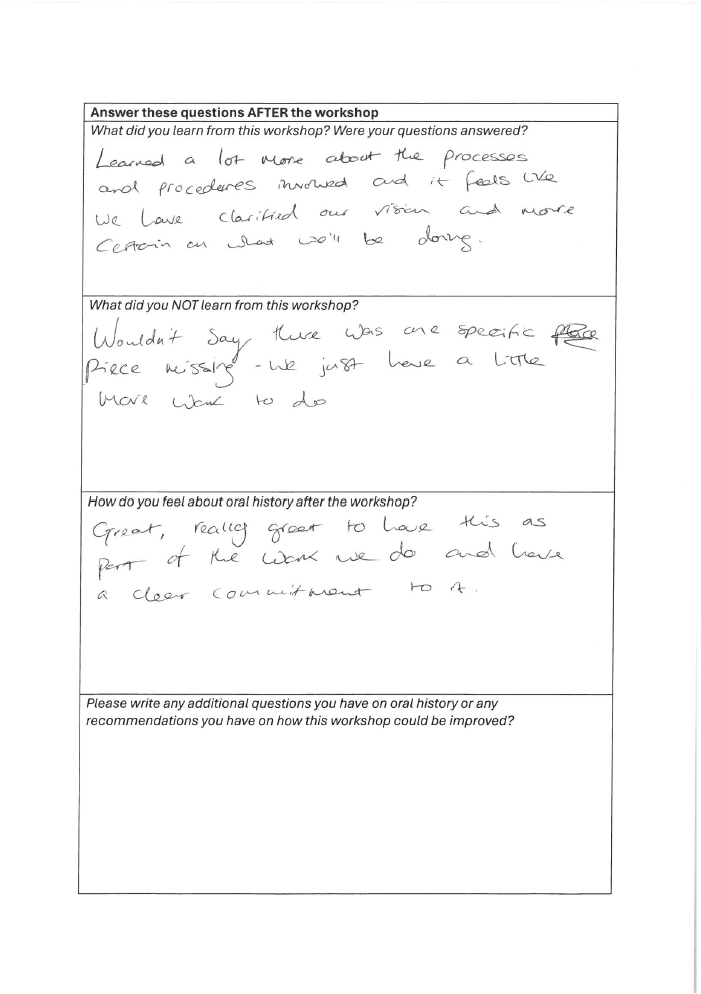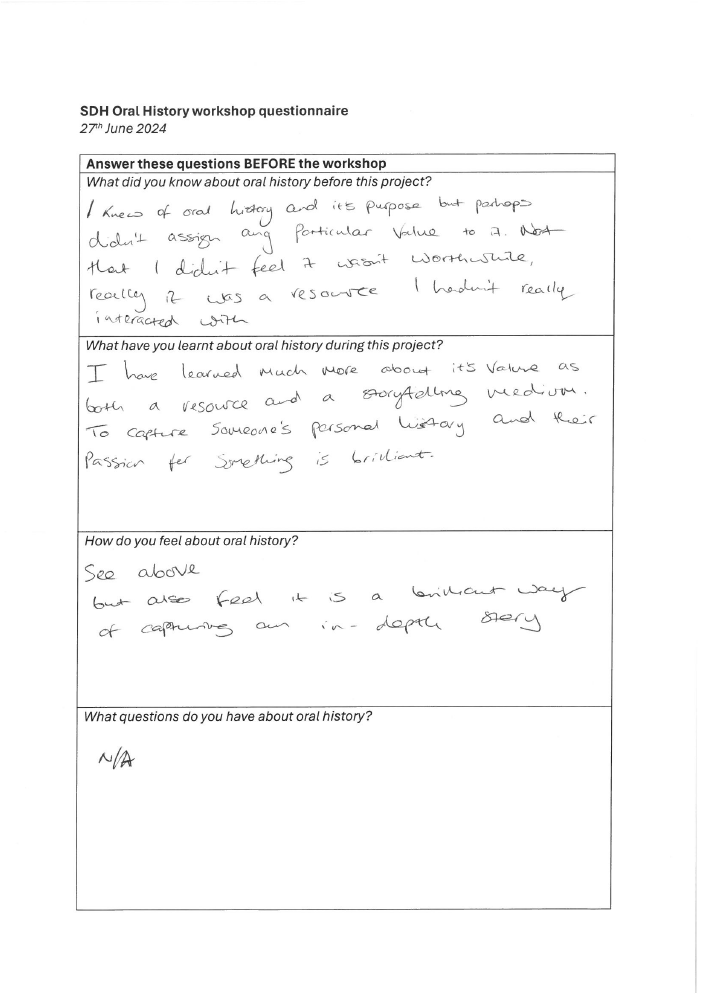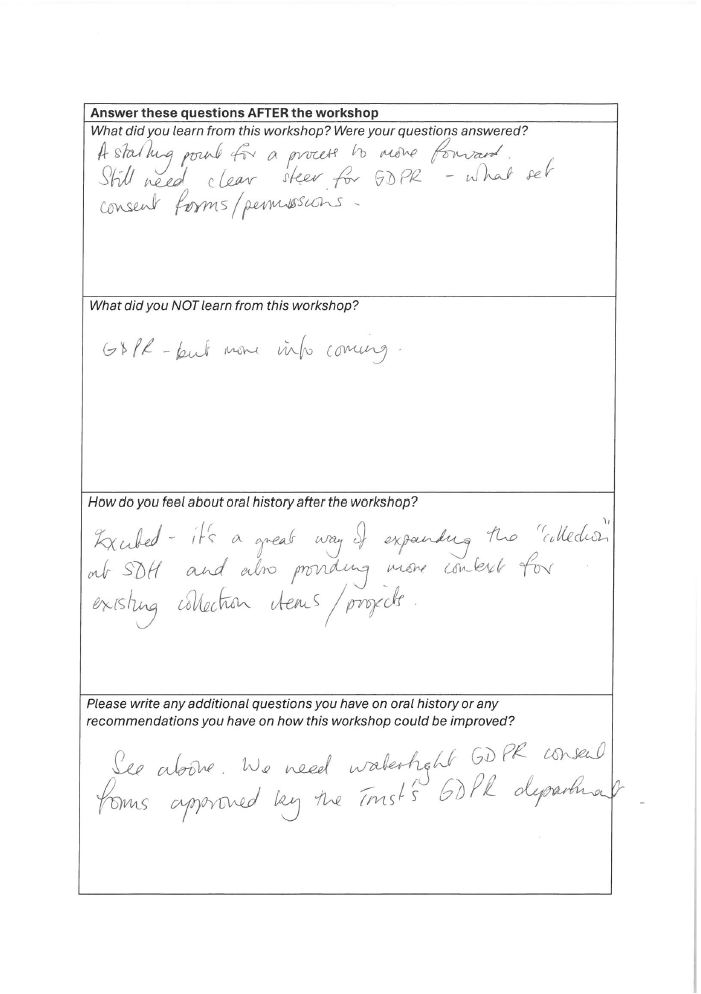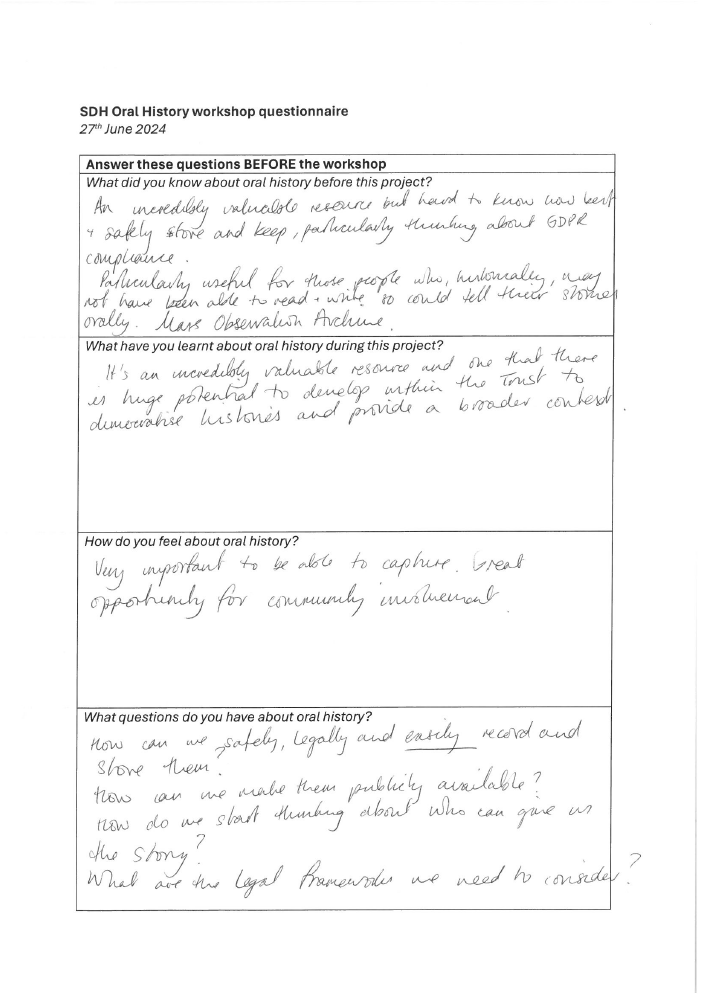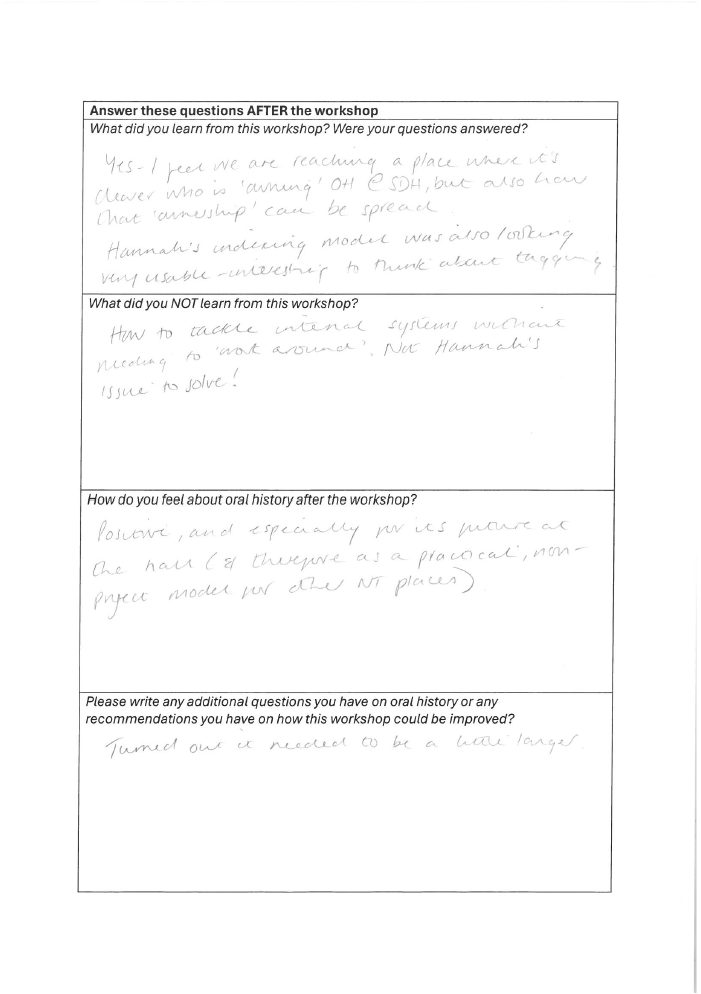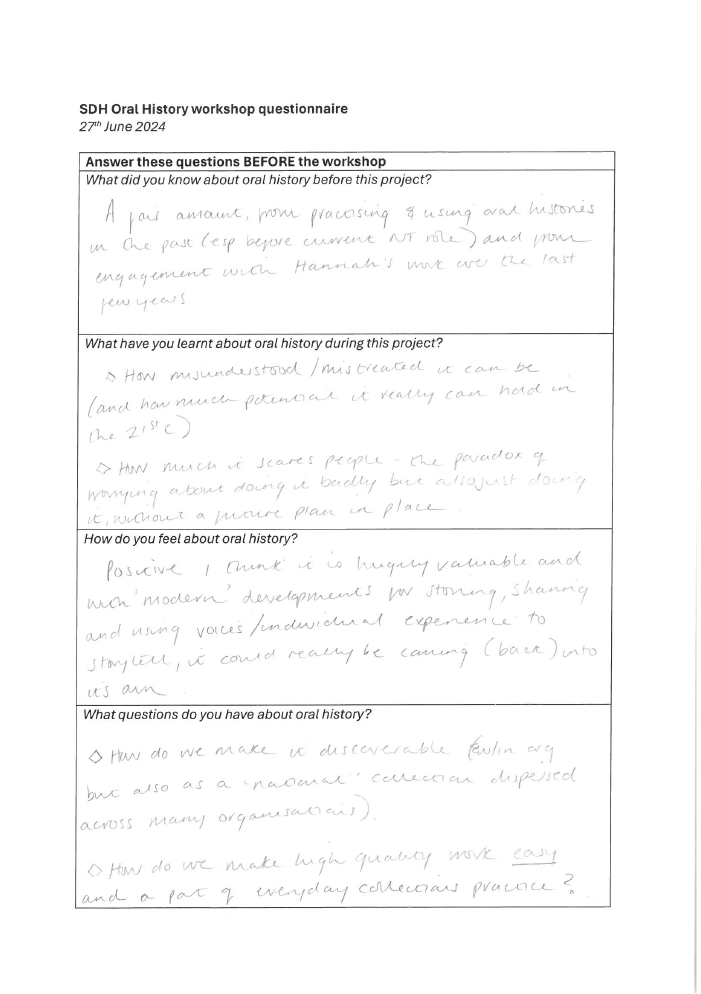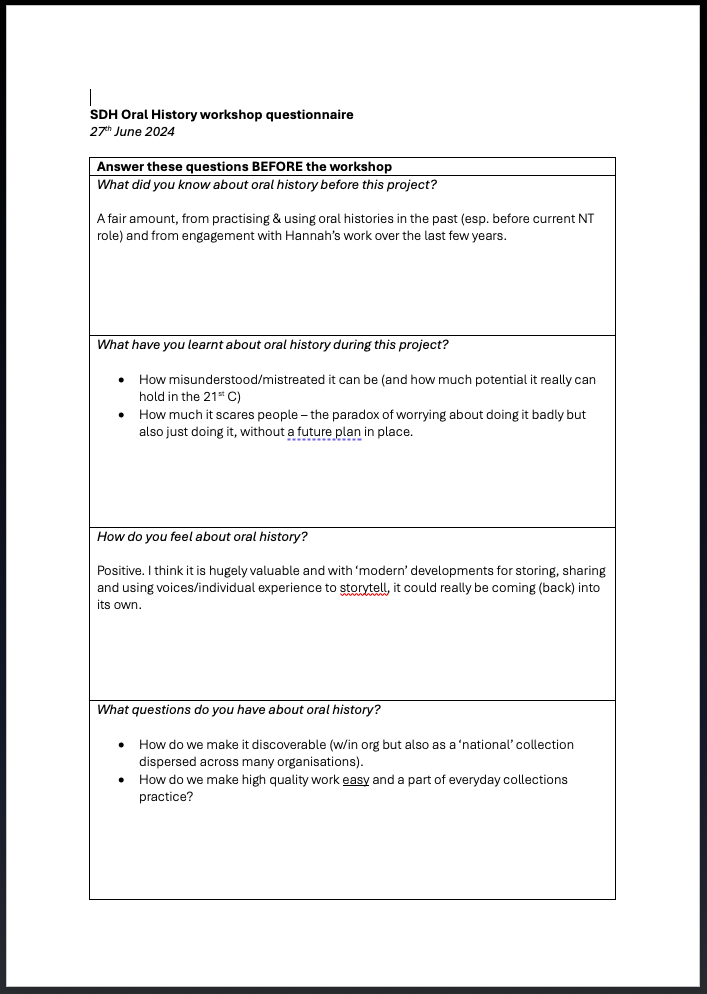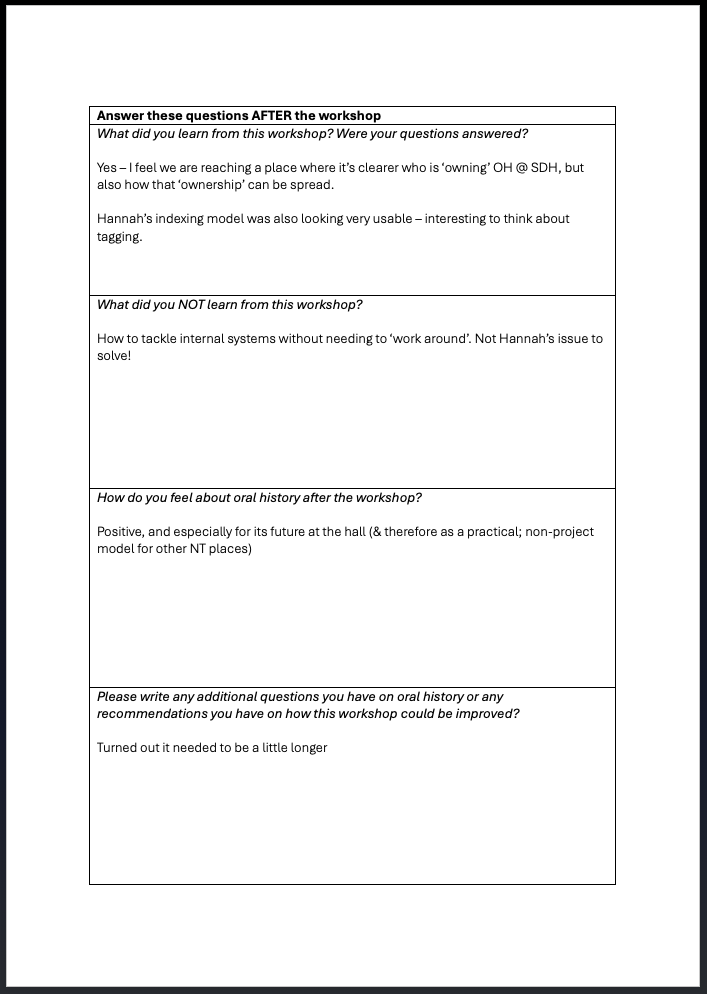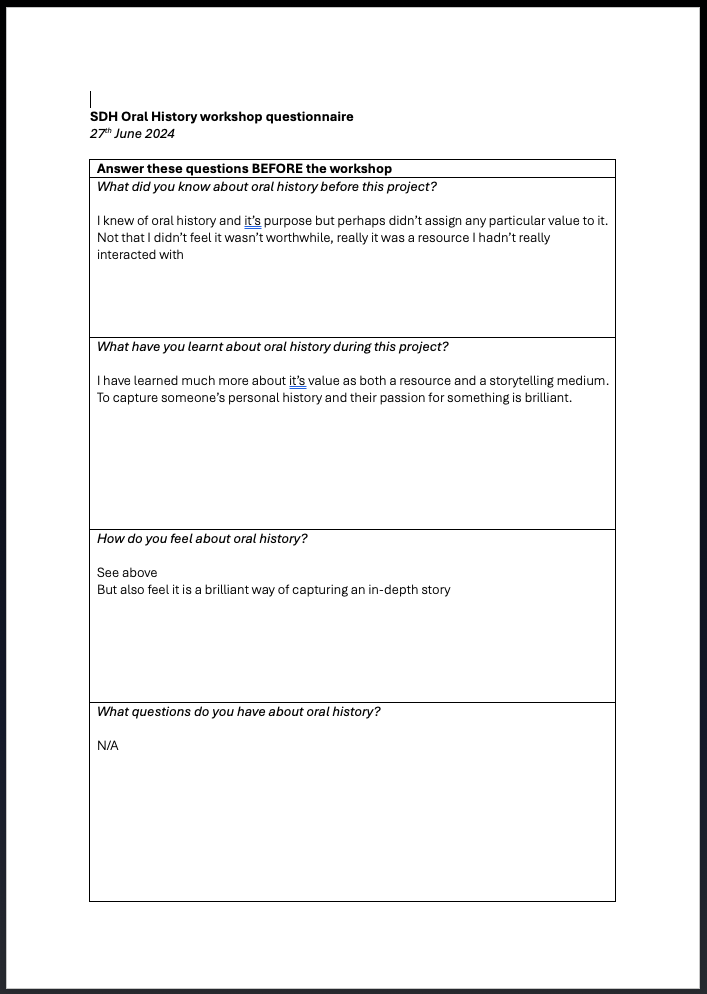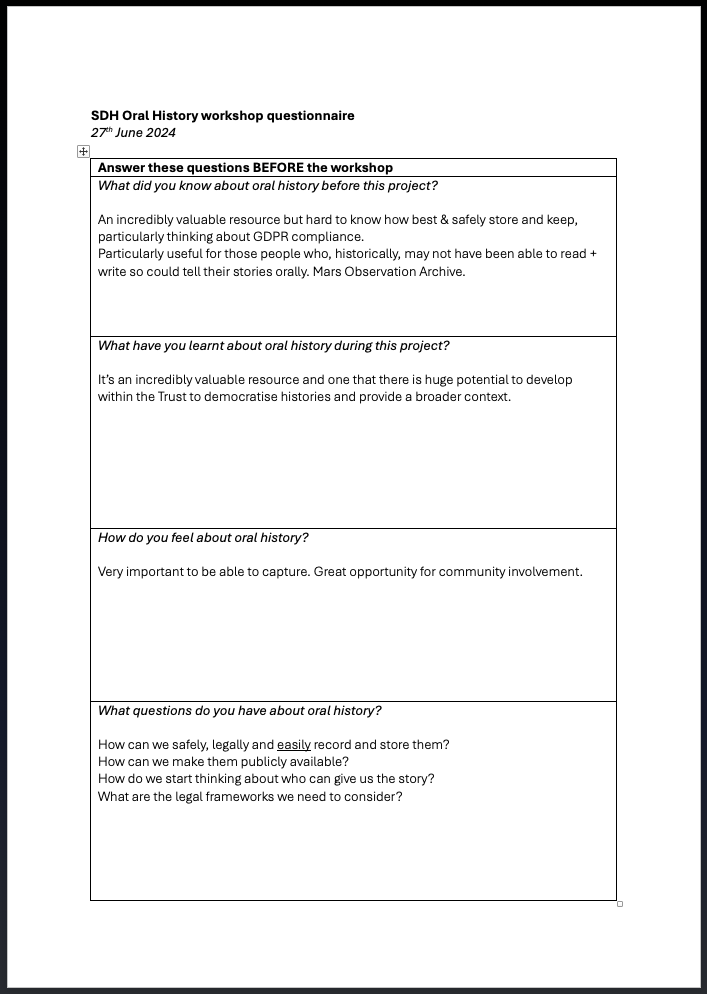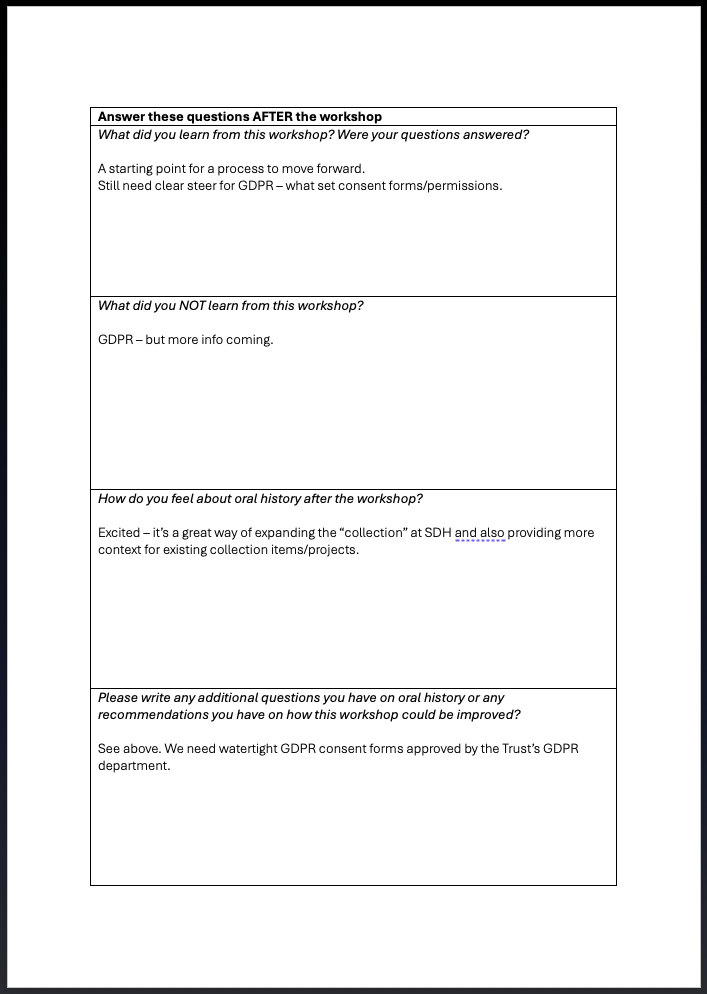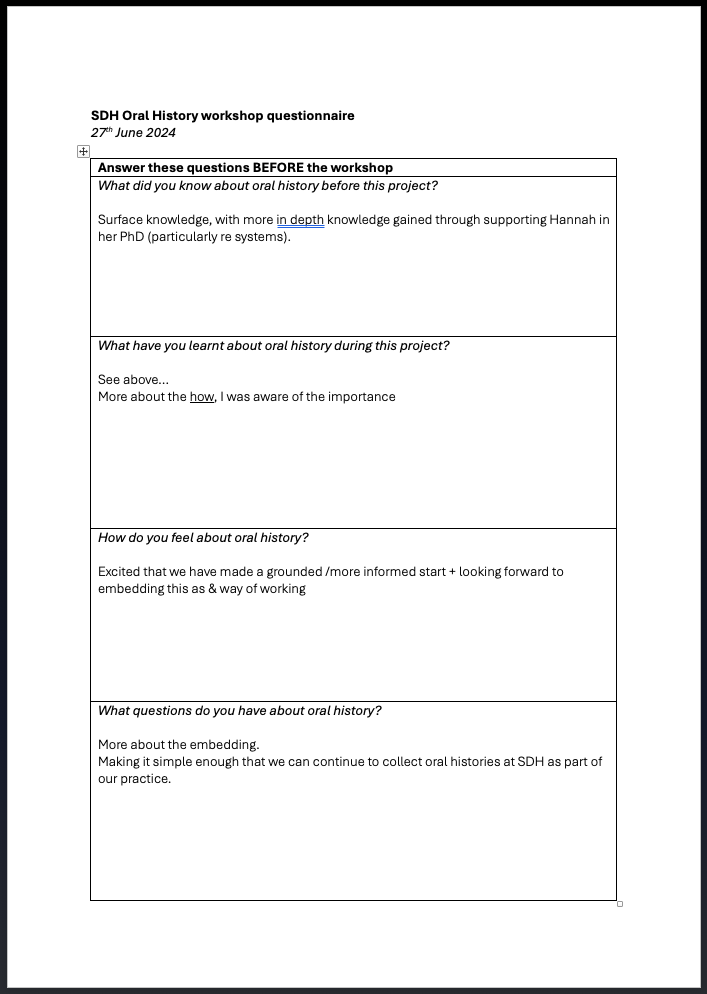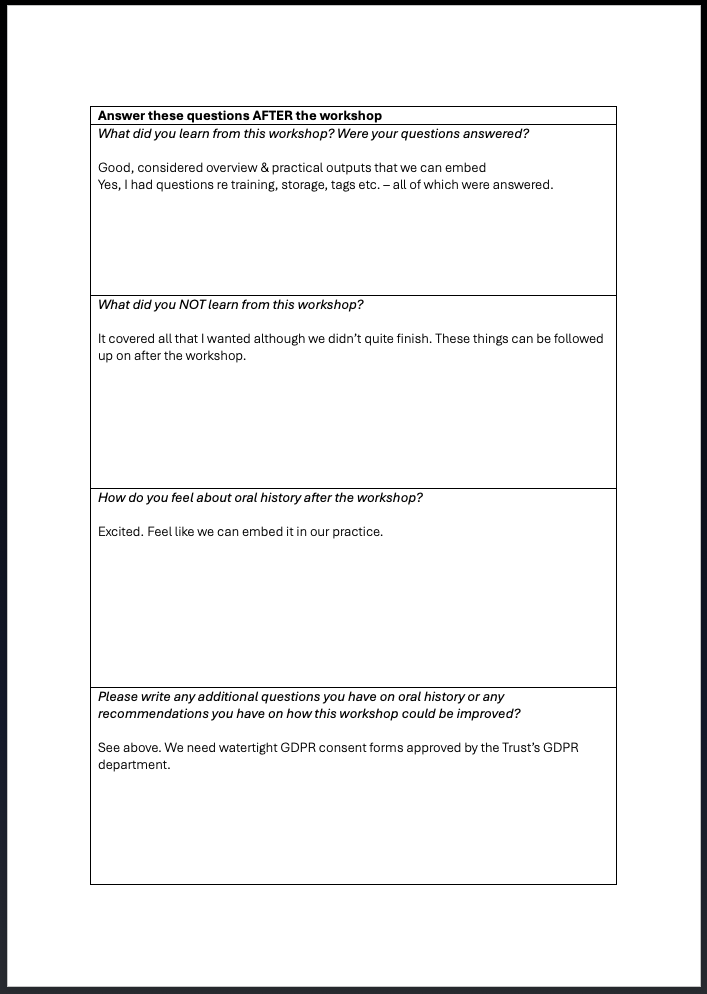sdh. 001 My work with Seaton Delaval Hall can be divided into two parts. The first is the oral history pilot project which ran through my research period, and the second is my design of the Research Room at the Hall during my three-month placement in the summer of 2022. From these two activities I identified the opportunities and obstacles of recording and using oral histories within the particular setting of a heritage site, Seaton Delaval Hall. My presence at the Hall led the staff to become more familiar with oral history and the wicked problem that surrounds it. They also helped me in my work, and I helped them with theirs, from unloading easter eggs to digitising cassettes to advising on copyright.1 Together with some members of the Hall’s staff, I completed my residency by developing an oral history strategy for them to follow in the future.
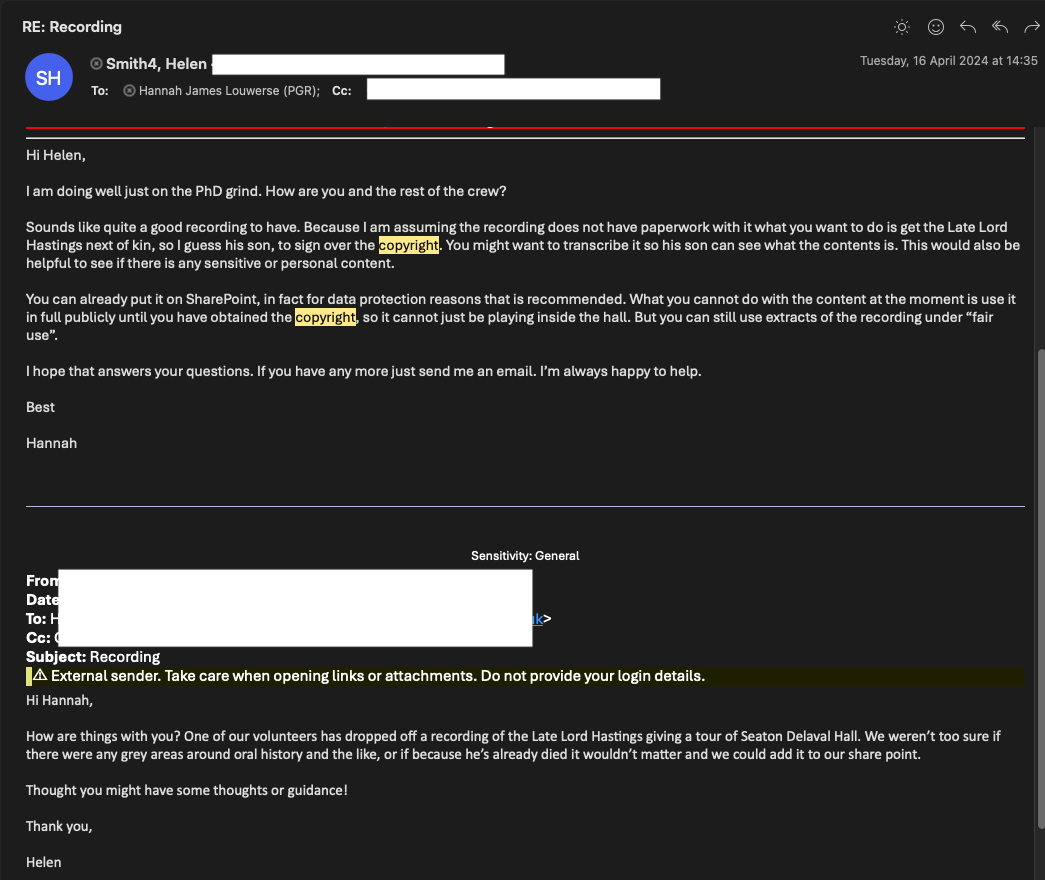
Email advising on copyright – OHD_SSH_0309
Recording Oral Histories
Oral History information sheet – OHD_COL_0291
My interview participation agreement – OHD_COL_0291
sdh. 002 I recorded my interviews under the auspices of Newcastle University. This was initially because it seemed the most logical option. I later learned that if I had recorded under the National Trust, I would have faced a different set of ethical and logistical challenges. For instance, the IT office opposed storing WAV files on SharePoint due to their large size and carbon footprint, while the Data Protection Office insisted on using SharePoint for data security reasons.
Following digital storage rules (given to me by the archivist at BALTIC in 2021) I kept my recordings in three different places: two hard drives, one of which I kept at home, and Microsoft Teams.
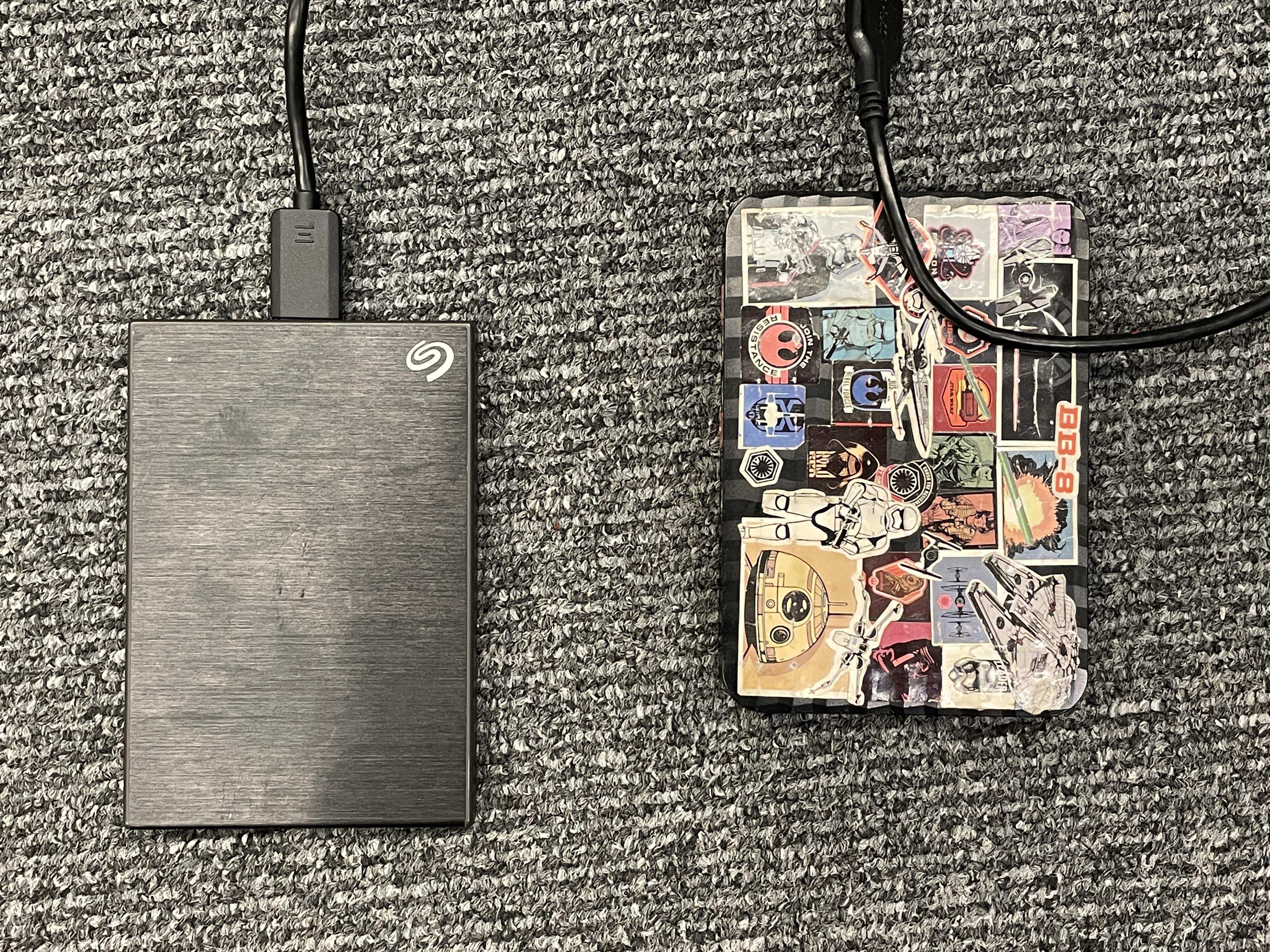
Top: SDH_PP. Bottom: Stormtrooper.
sdh. 003 After each recording, I wrote a detailed summary for the participant to review. I recorded twelve oral histories and spent most of the time sorting out the copyright, which proved to be a challenge. The first obstacle in obtaining copyright was creating the appropriate copyright form. I had been given permission from the oral history archivist at the British Library to donate my recordings to the local Northumberland Archives. However, this meant I could not use the National Trust’s standard copyright form because this ascribes copyright jointly to the British Library and the Trust. I therefore needed to make my own copyright form, and as I was not an expert on oral history or archival copyright I used existing forms as inspiration.2 I then sent my first draft of the agreement to the archivist at Northumberland Archives and attempted to seek contact with the head of copyright at the Trust. The former approved while the latter, after my Trust supervision emailed them multiple times, replied that this was not the kind of copyright they dealt with.
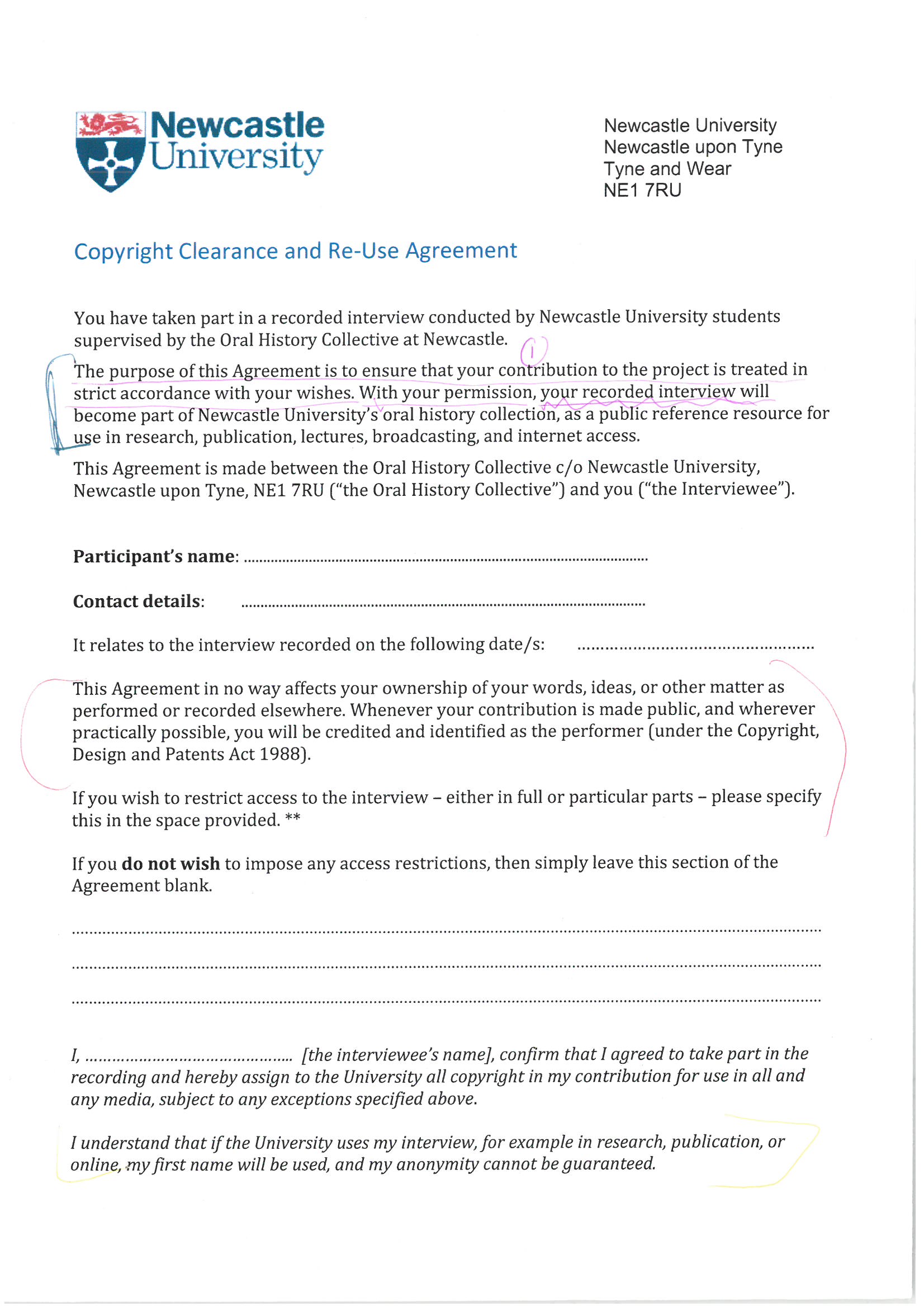

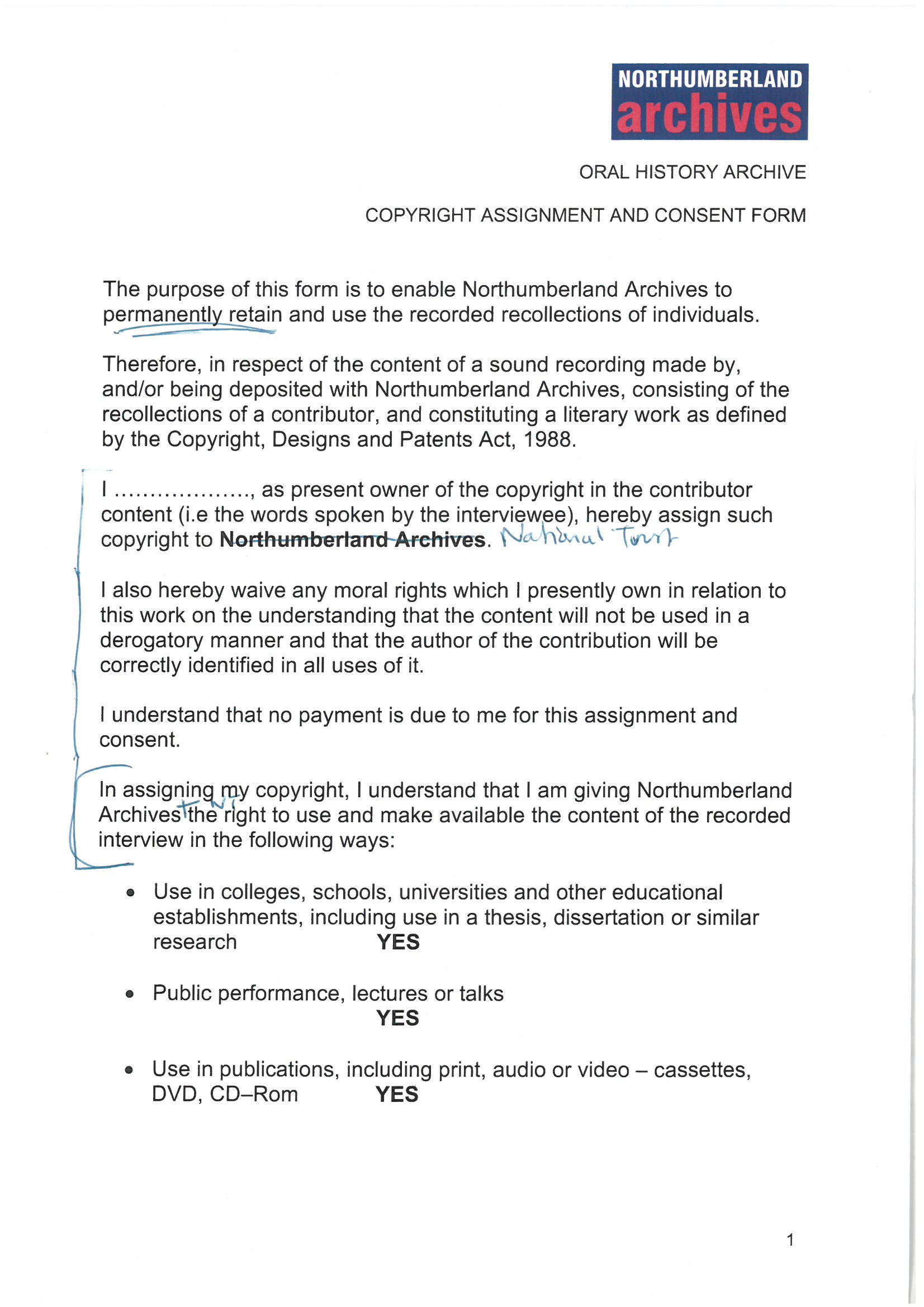
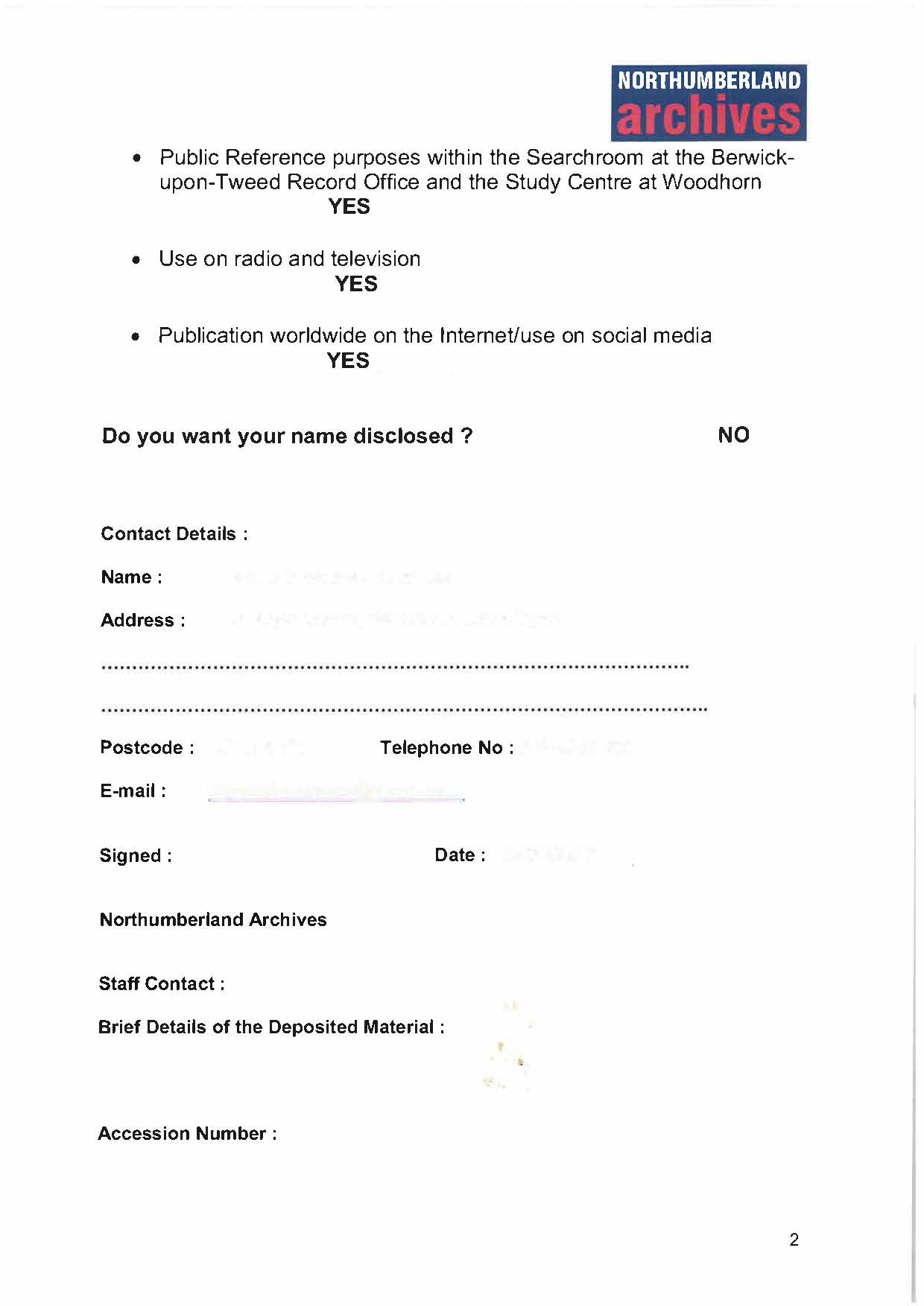
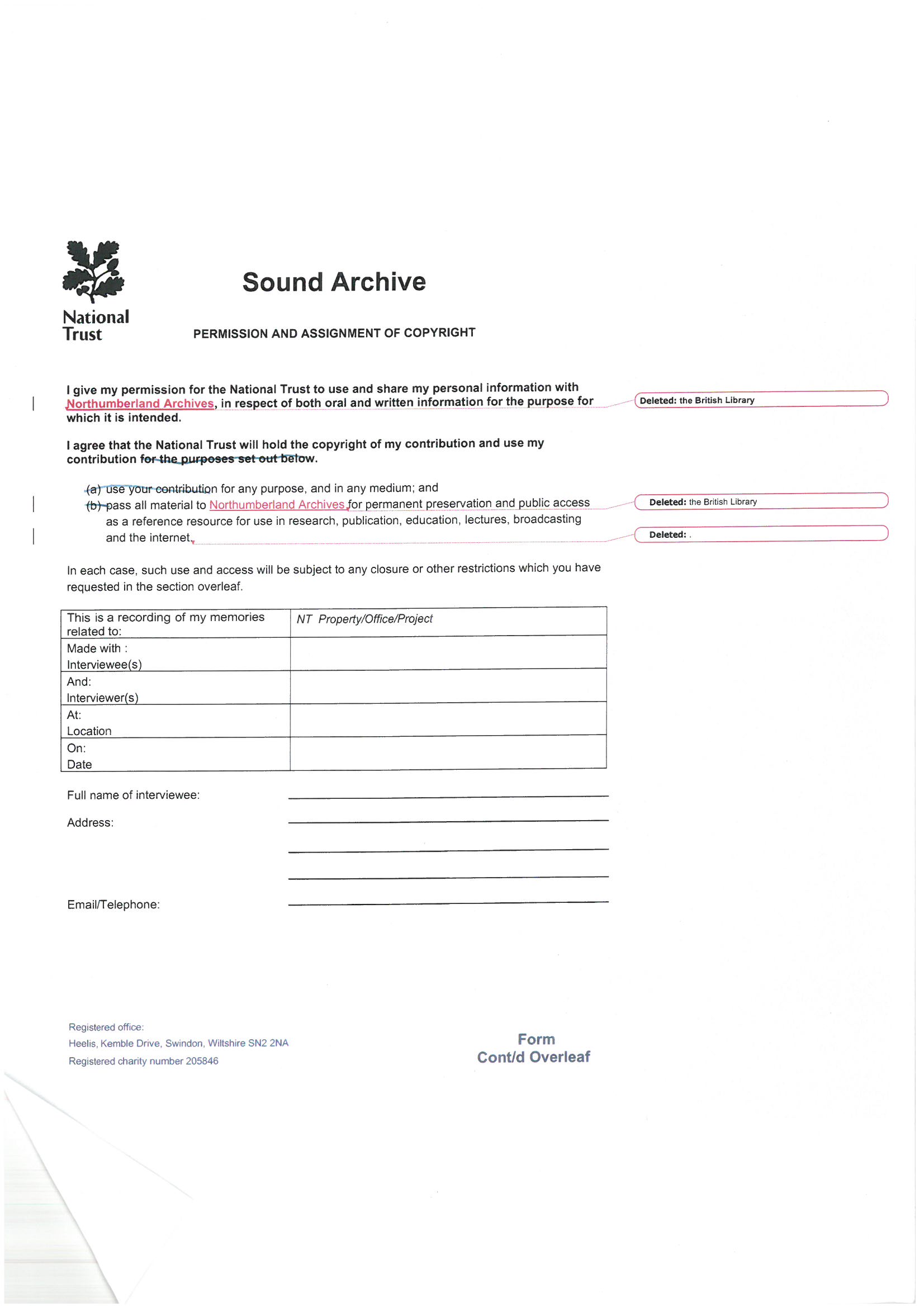
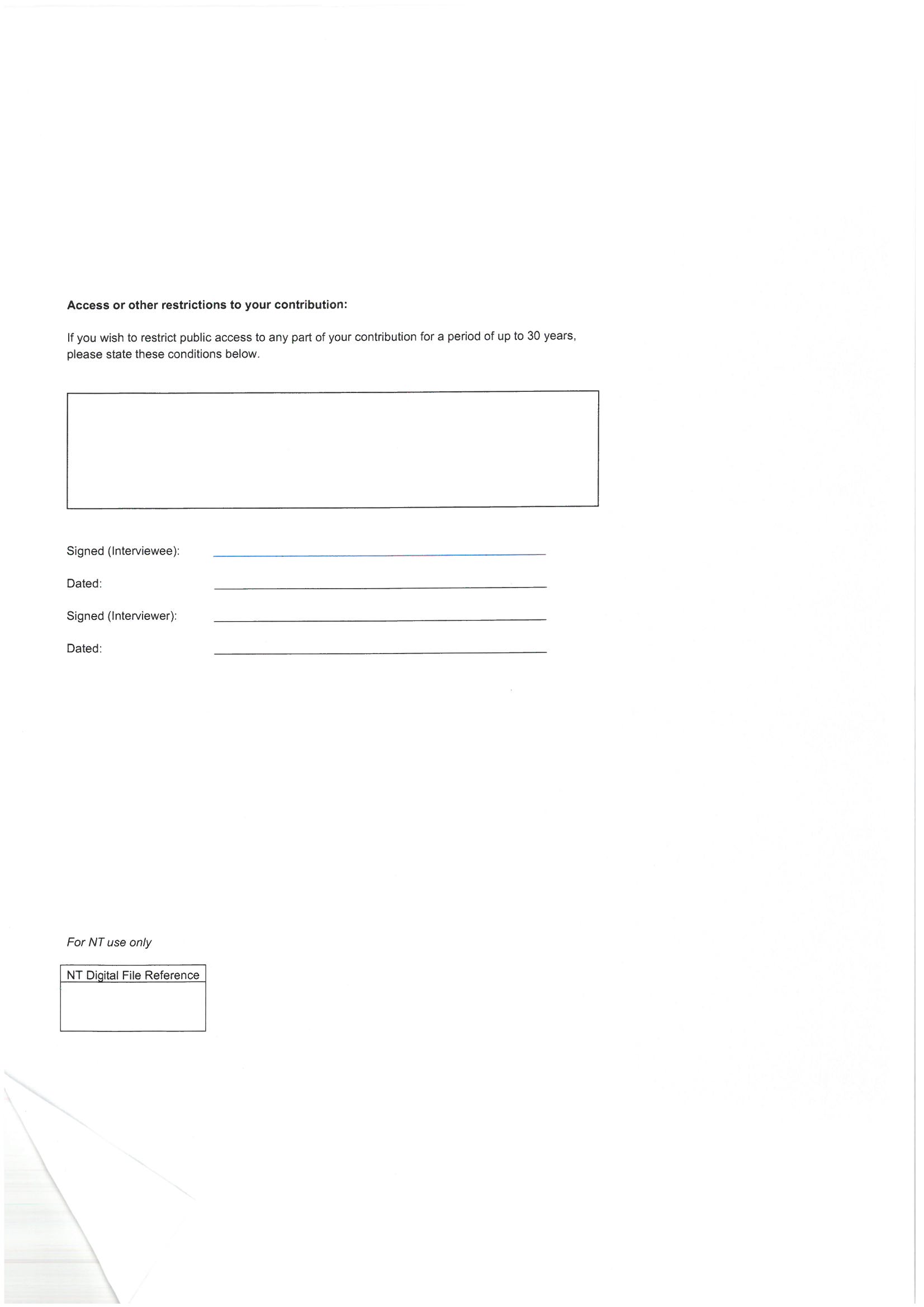
Copyright forms (for inspiration) – OHD_FRM_0226
sdh. 004 The second obstacle was getting people to sign the copyright, something many oral historians experience. I was fortunate to have help from the Hall’s team, specifically the Volunteering Officer, who proved essential to securing copyright.
Email about OH copyright – OHD_SSH_0294
sdh. 005 I concluded the oral history pilot project with a listening party at the Hall one evening in the summer of 2024,3 inspired by the listening parties oral historians organise as a way to engage the wider community beyond the interviewees.4 Various volunteers and staff members, some who I had recorded and some who I had not, came to listen to audio extracts and have a discussion about the content. It was lovely and had a surprisingly high turnout. I asked audience members to write about why they attended and what they took away from the experience.5
Extracts from the listening session – OHD_AUD_0295



Post it note feedback from the listening session – OHD_PST_0289
sdh. 006 Before the listening session, I had also put together a soundwalk with the recordings which I shared with my Trust supervisors to help them imagine the outputs they might produce from the oral history recordings.6 Many of the same extracts I used for the listening session.
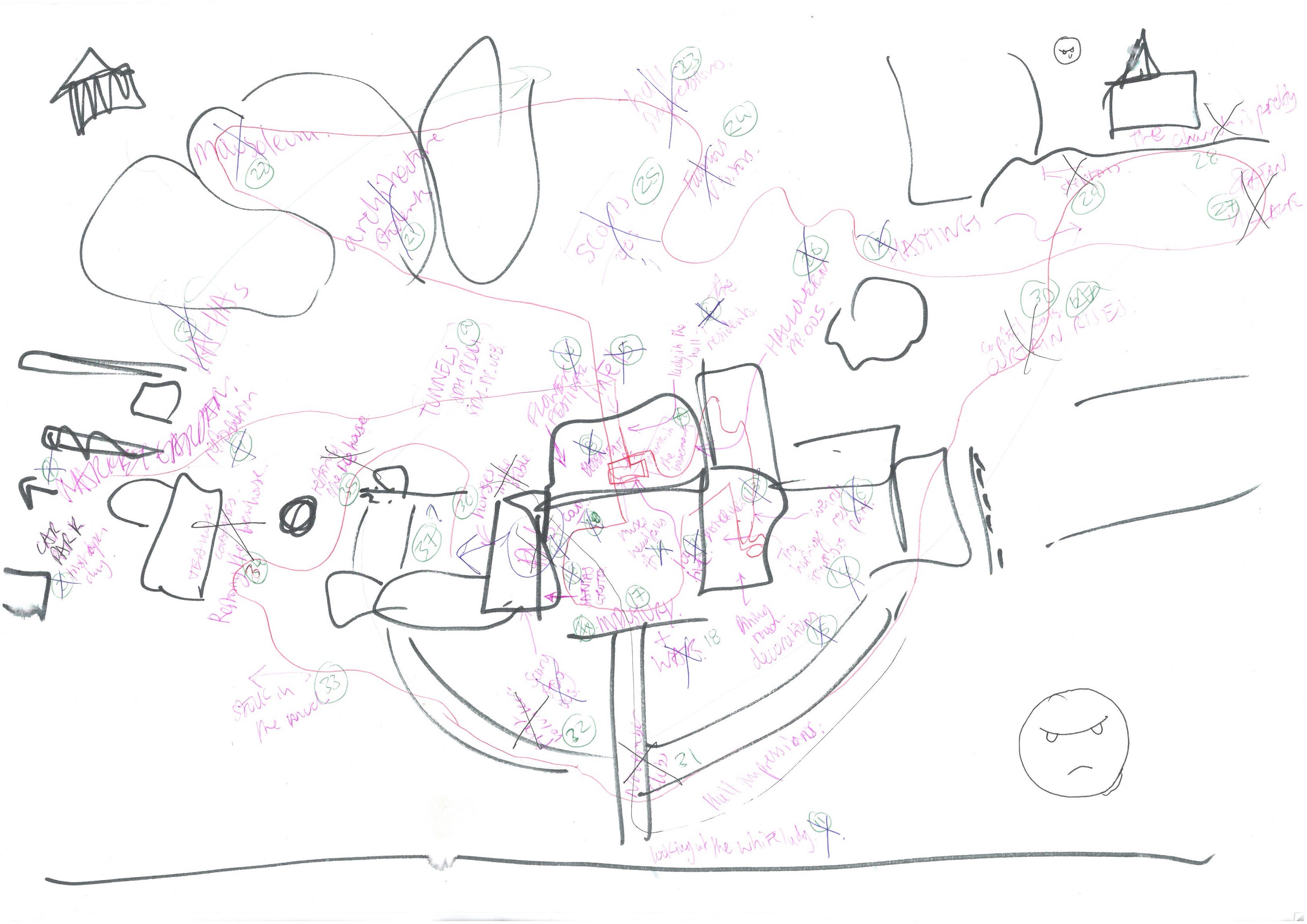
sdh. 007 The final archiving process entailed me donating the audio to Northumberland Archives and uploading my files to the Seaton Delaval Hall SharePoint. When doing this I made sure the Hall received MP3 and WAV versions of the recordings, and that the indexing spreadsheet adhered to the British Library one. This would make transferring the oral histories easier in case staff at the Hall decide they do want a copy at the British Library.
Deposit receipt – OHD_RCP_0293
The Research Room
sdh. 008 During my three-month placement at Seaton Delaval Hall in the summer of 2023, I was tasked with designing the Research Room. This was a space in the Hall that would allow people to access the vast amounts of non-collection worthy material, which had been accumulated over the years.7 In many ways I had to start from scratch, first working out what would go into the Research Room, what kind of spaces there would be, and then creating the forms and processes to make everything work.
Seaton Delaval Hall placement Miro board – OHD_WHB_0157
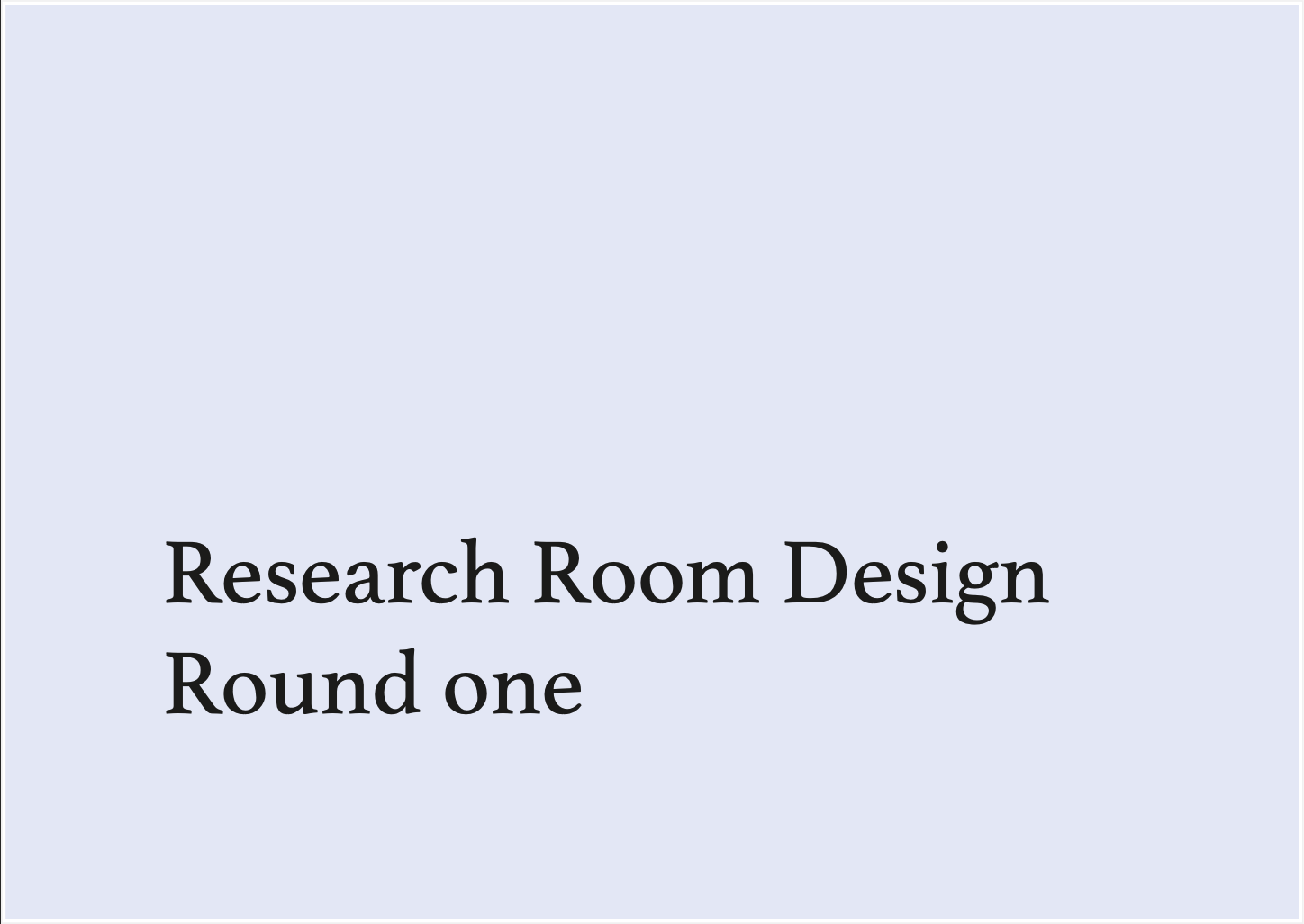
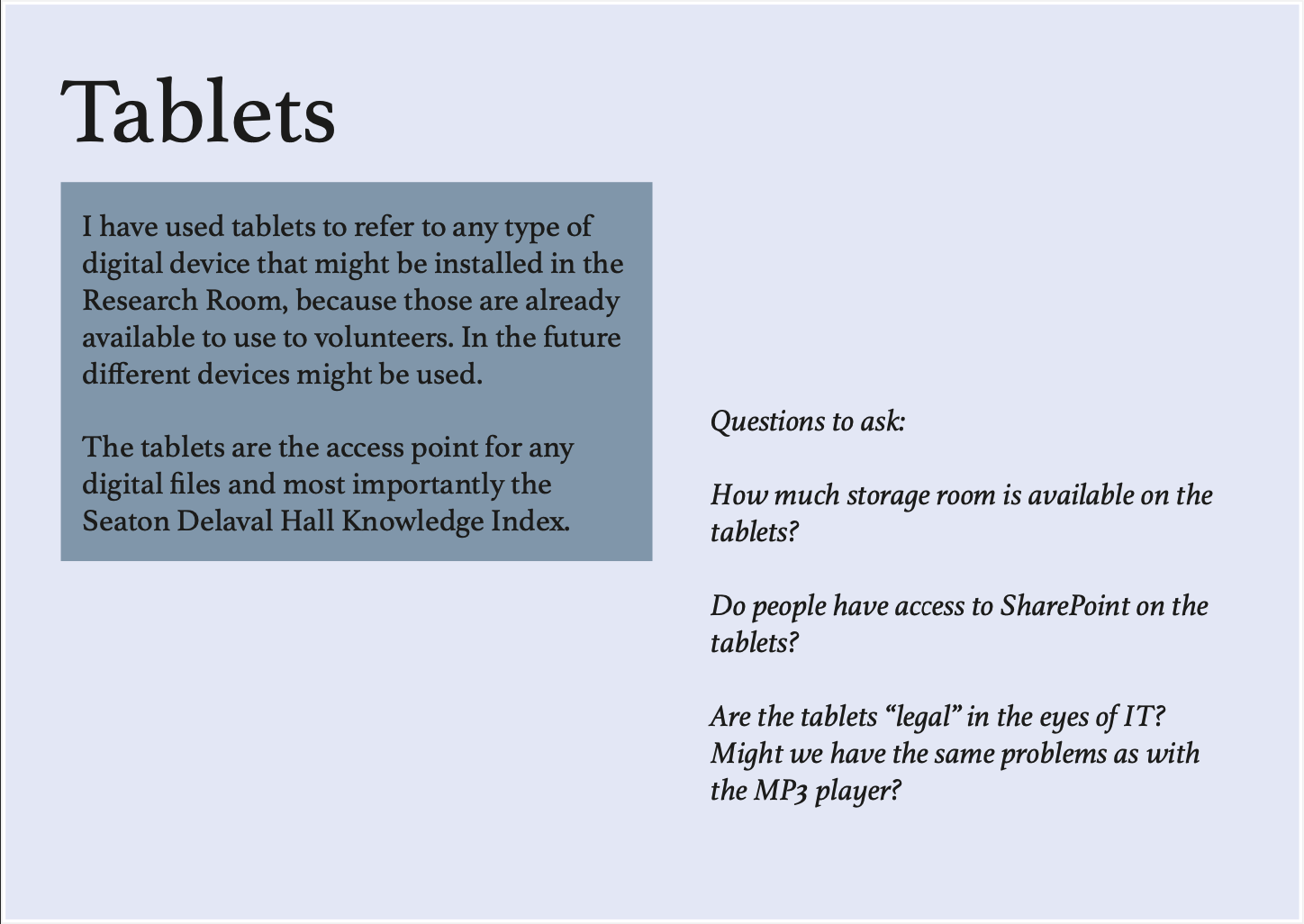
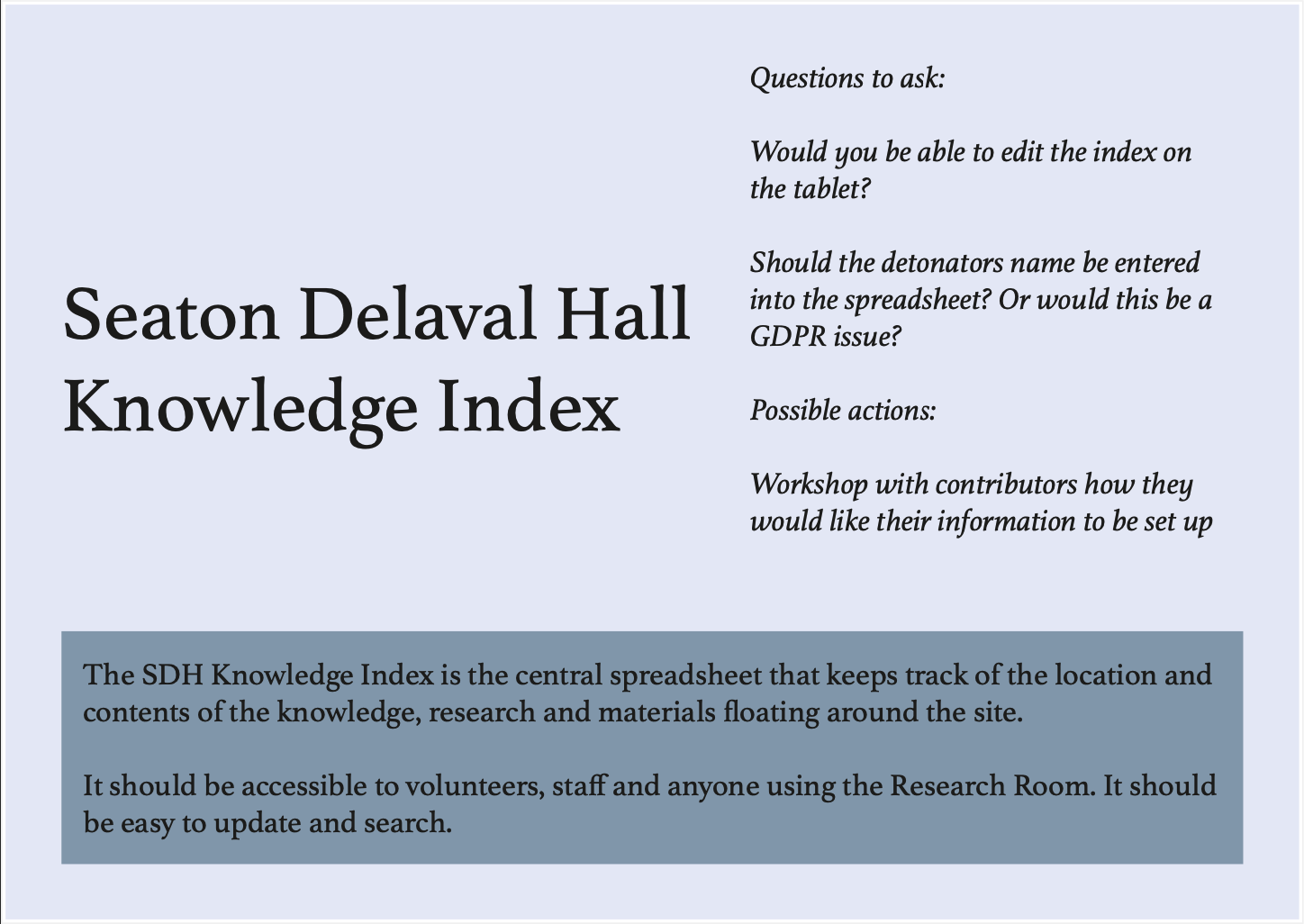
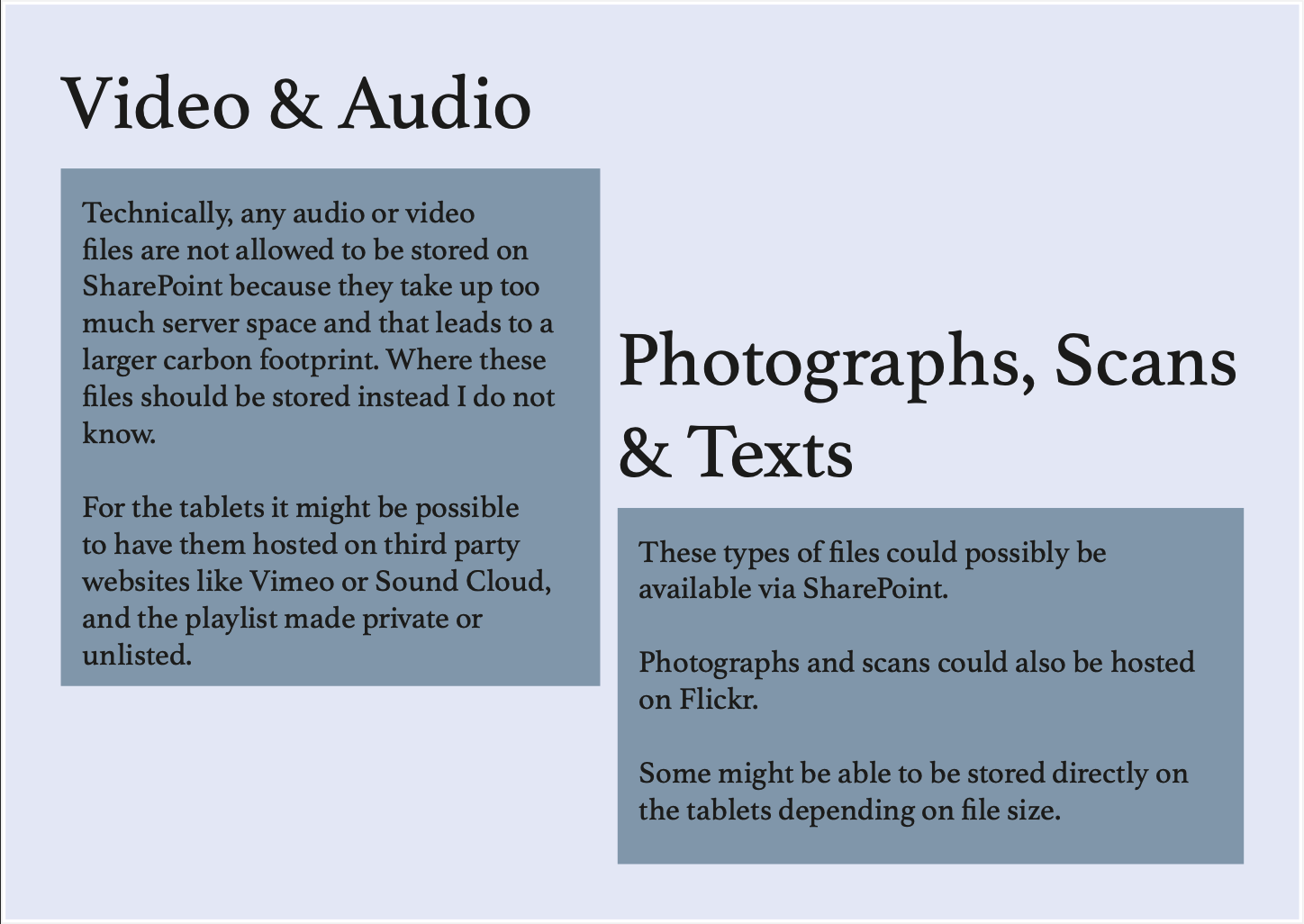

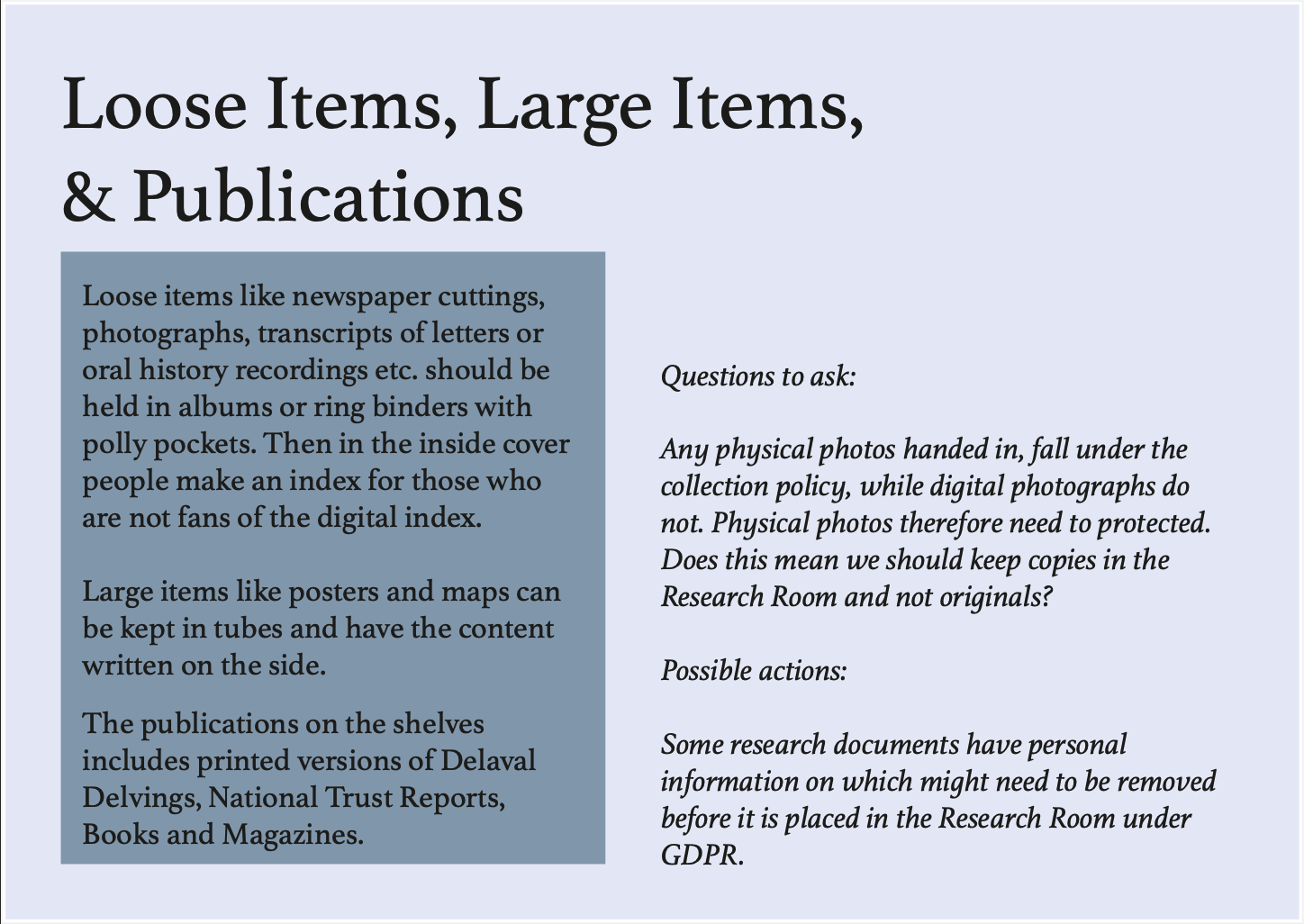
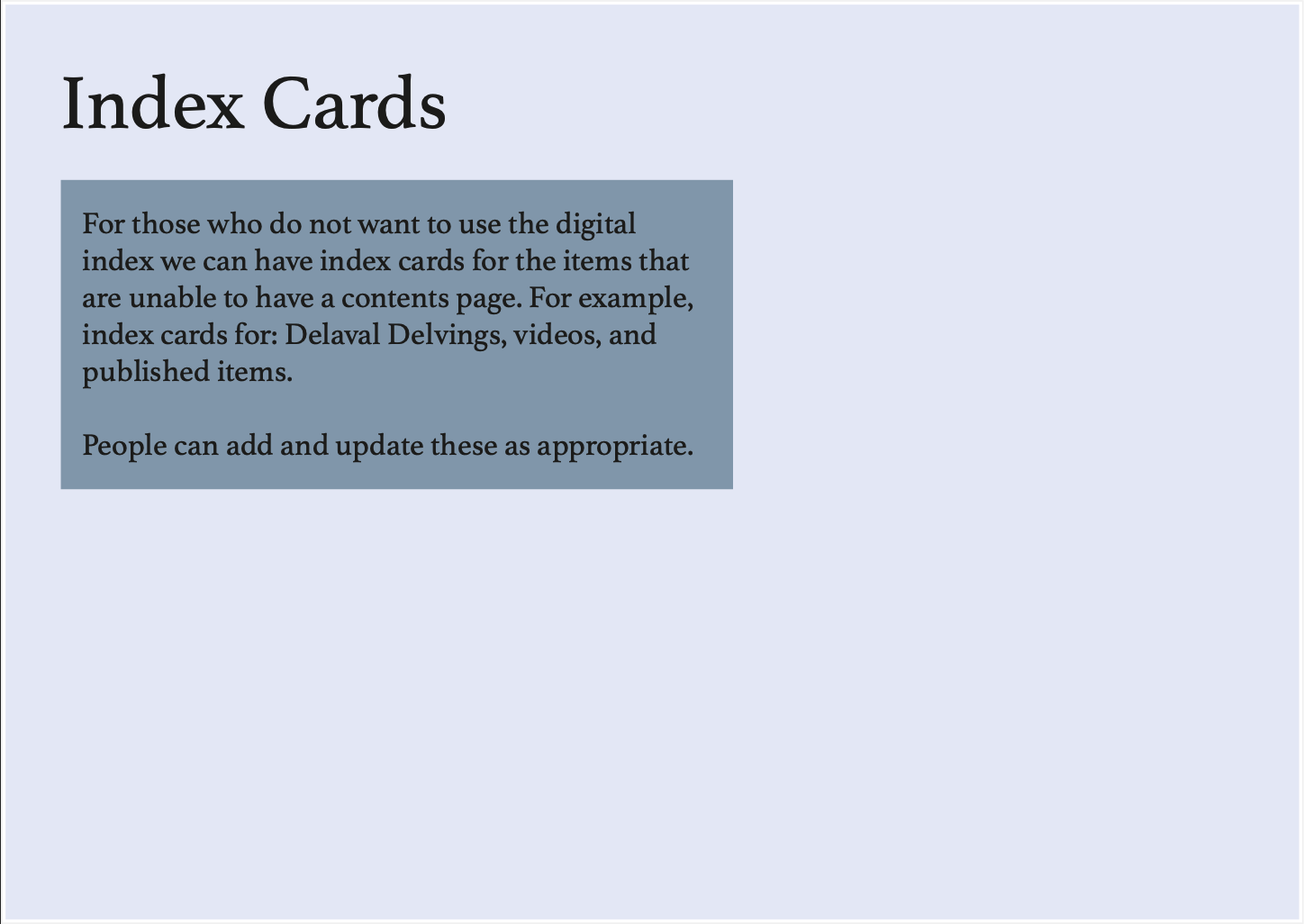
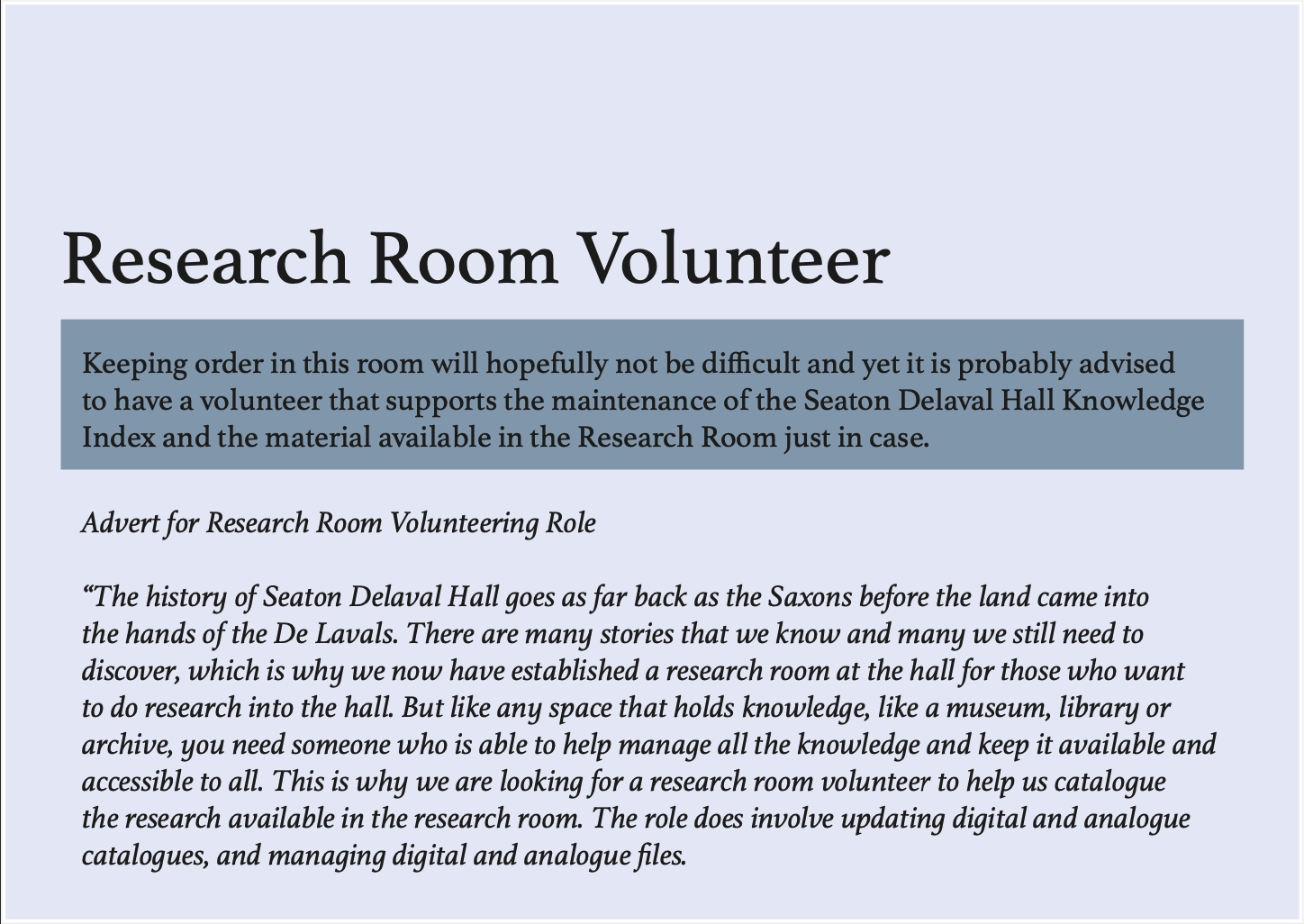
Round one report of the Research Room – OHD_RPT_0198
sdh. 009 Because I was working from scratch I used design fictions to help myself imagine the process of donating and using the Research Room.8 Design Fiction, a term coined by the science fiction writer Bruce Sterling,9 is used ‘predominantly as an object for interrogation, from which other iterations may follow, that in the end inform a design brief.’10 It is a tool intended to help an observer understand a situation without having to interfere directly with the situation, which was perfect for my work as the Hall’s staff wanted to avoid over-promising.11 The design fiction below allowed me to imagine the processes of the Research Room in its finer detail.
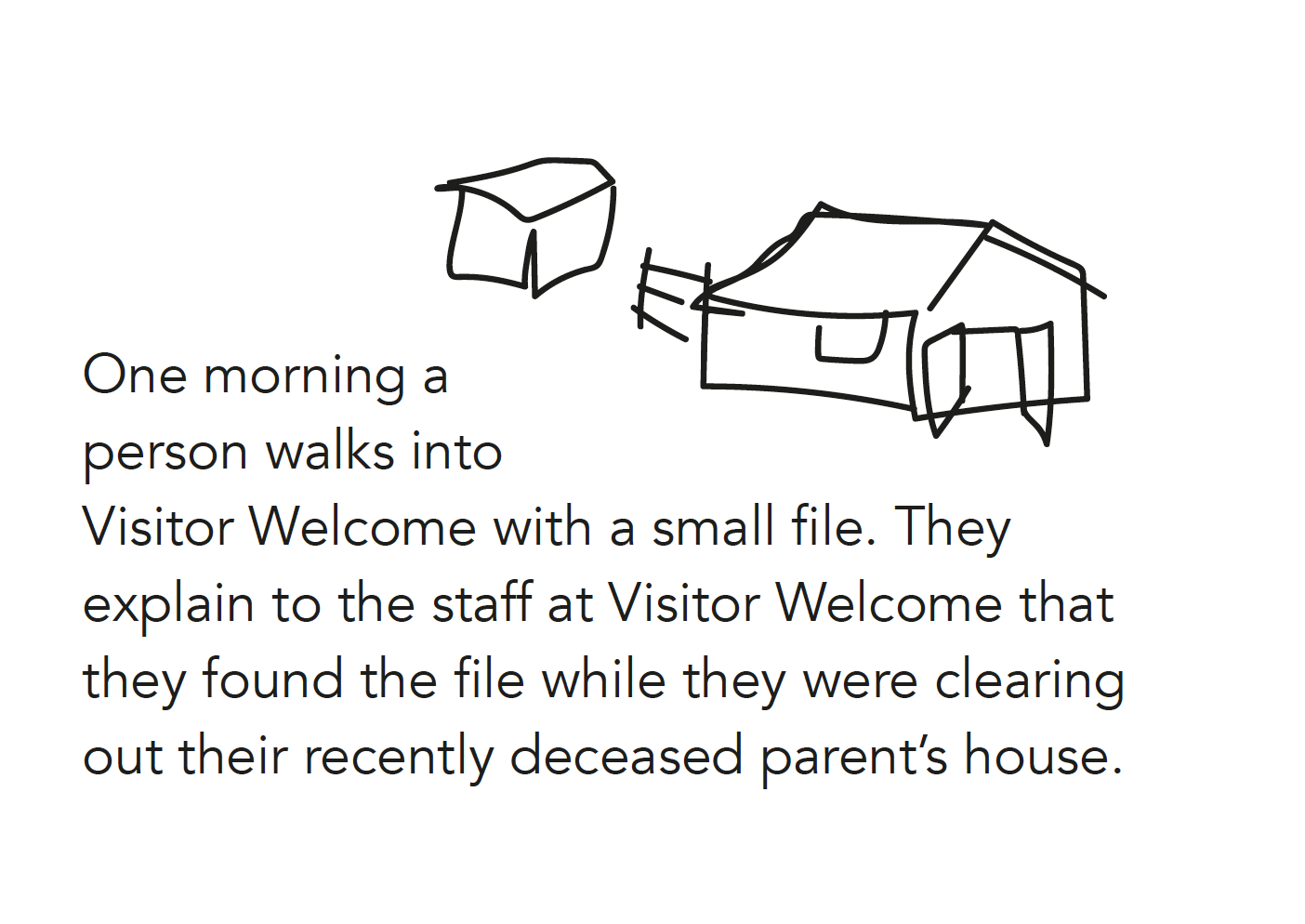
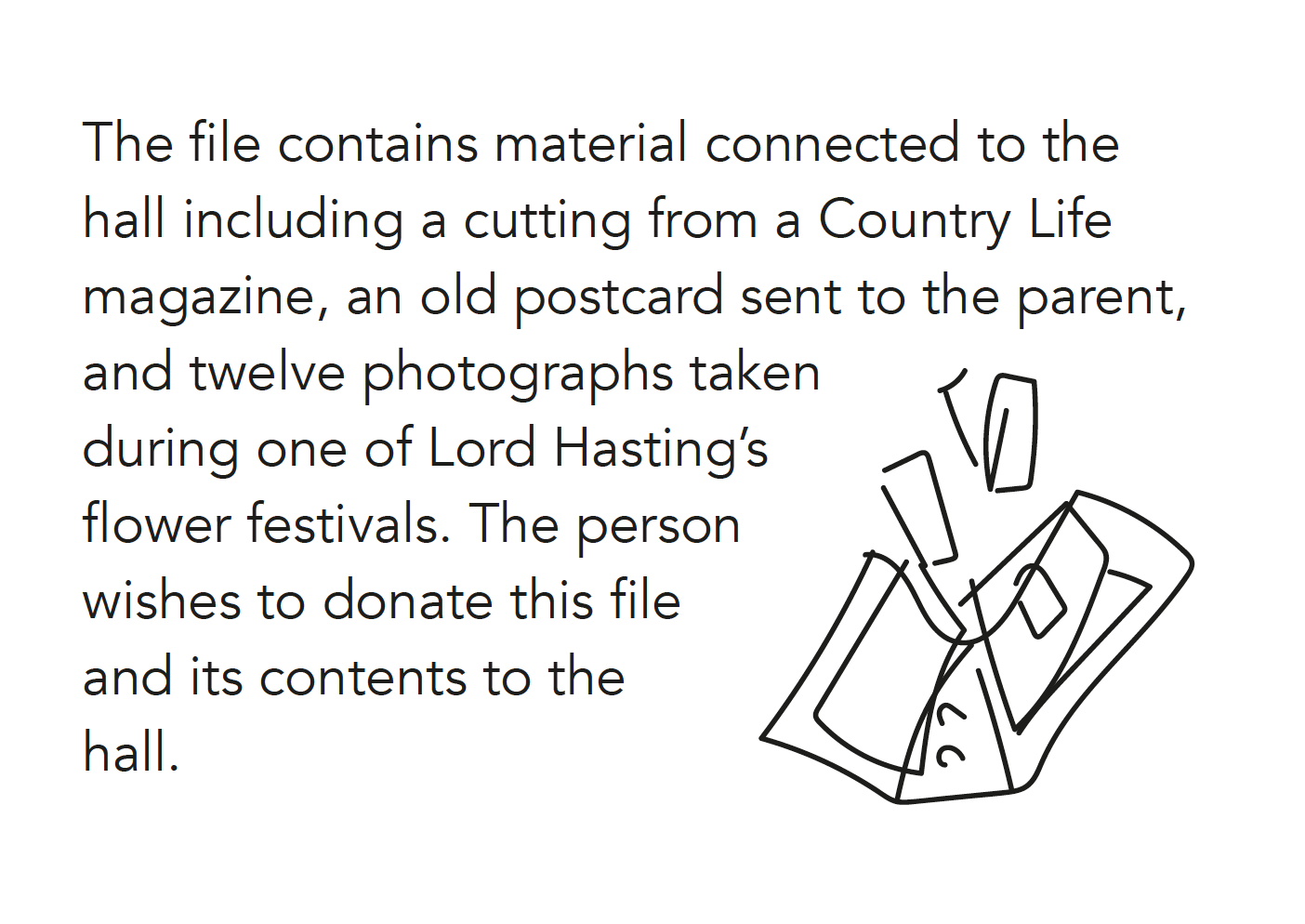

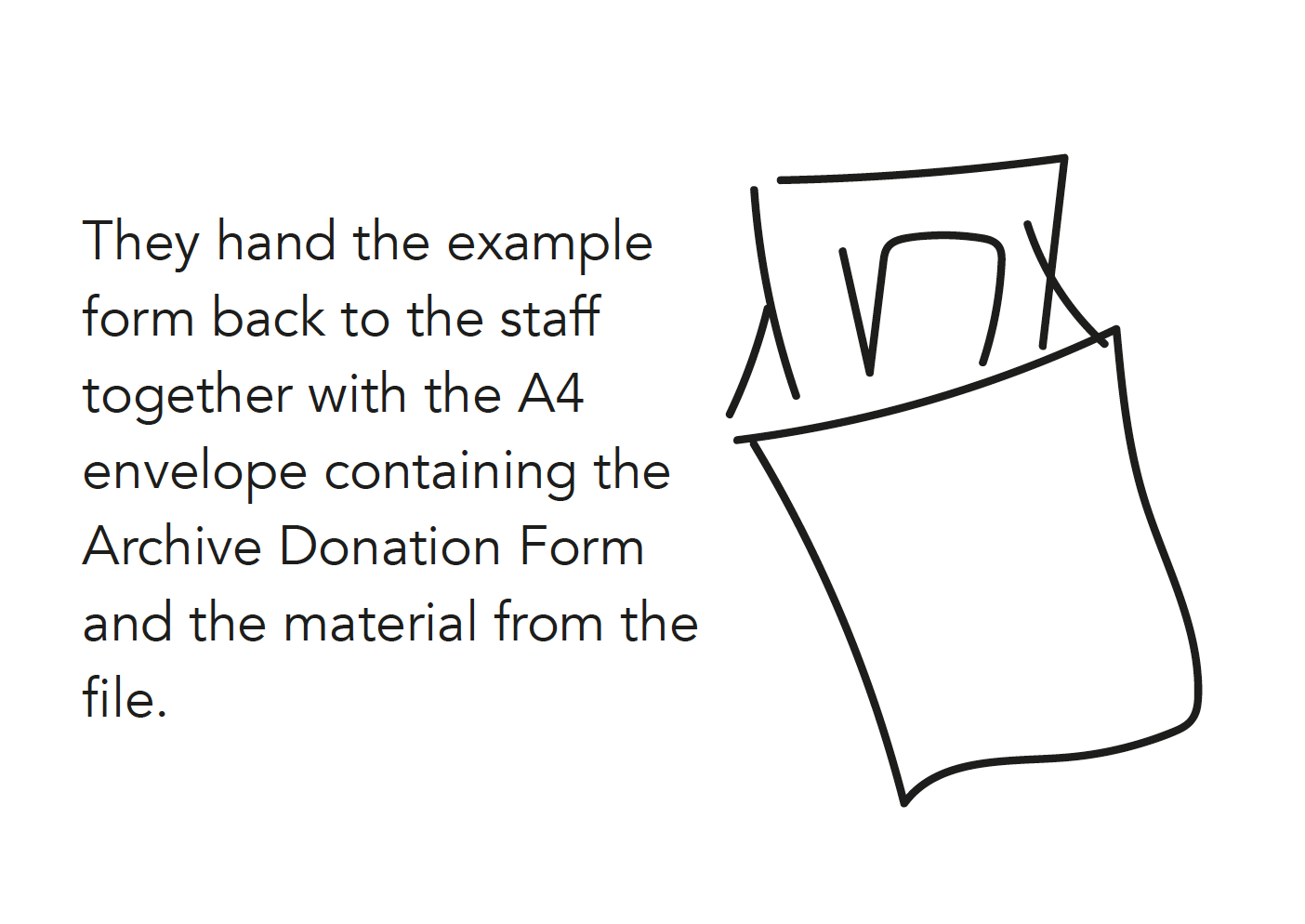
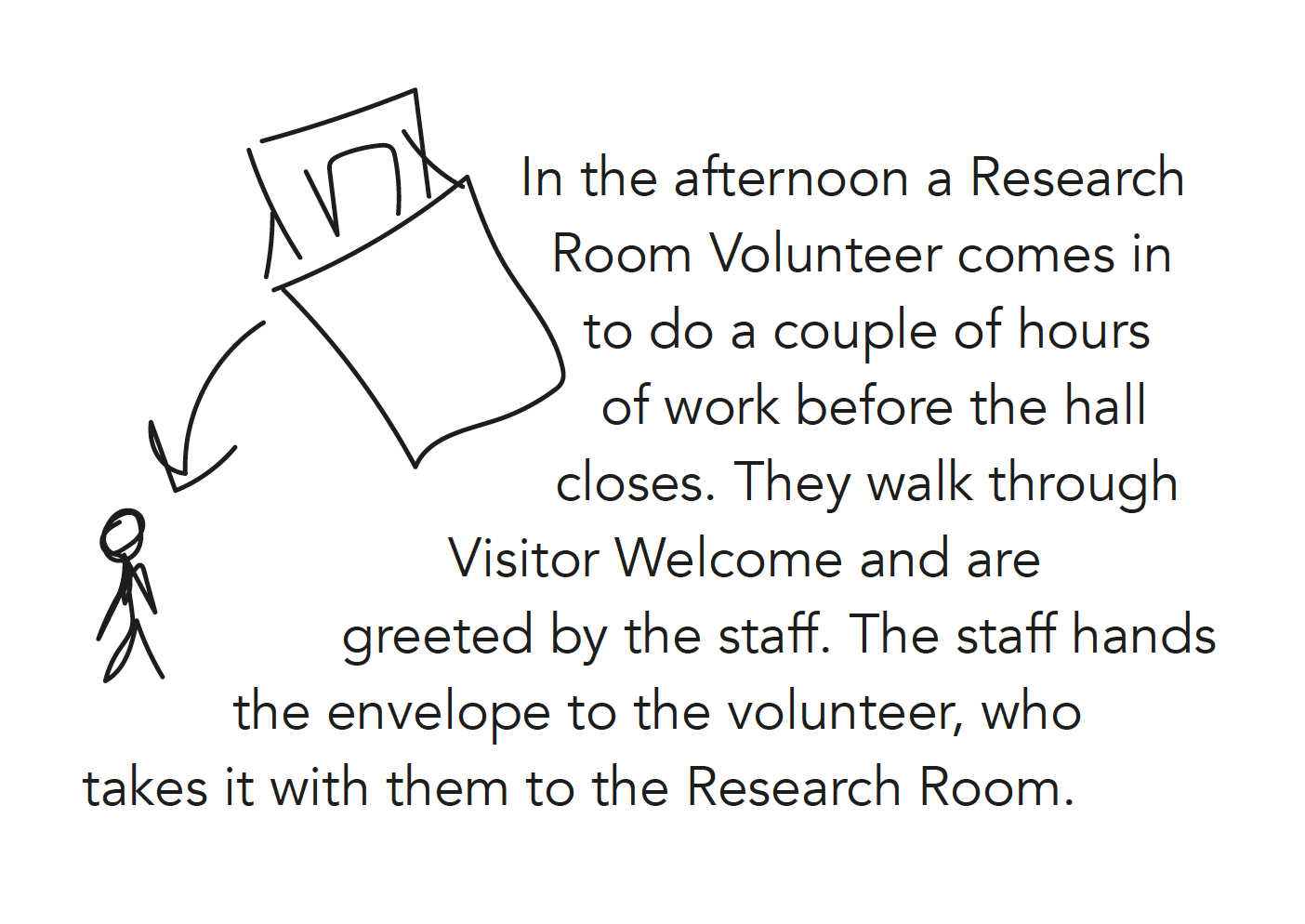
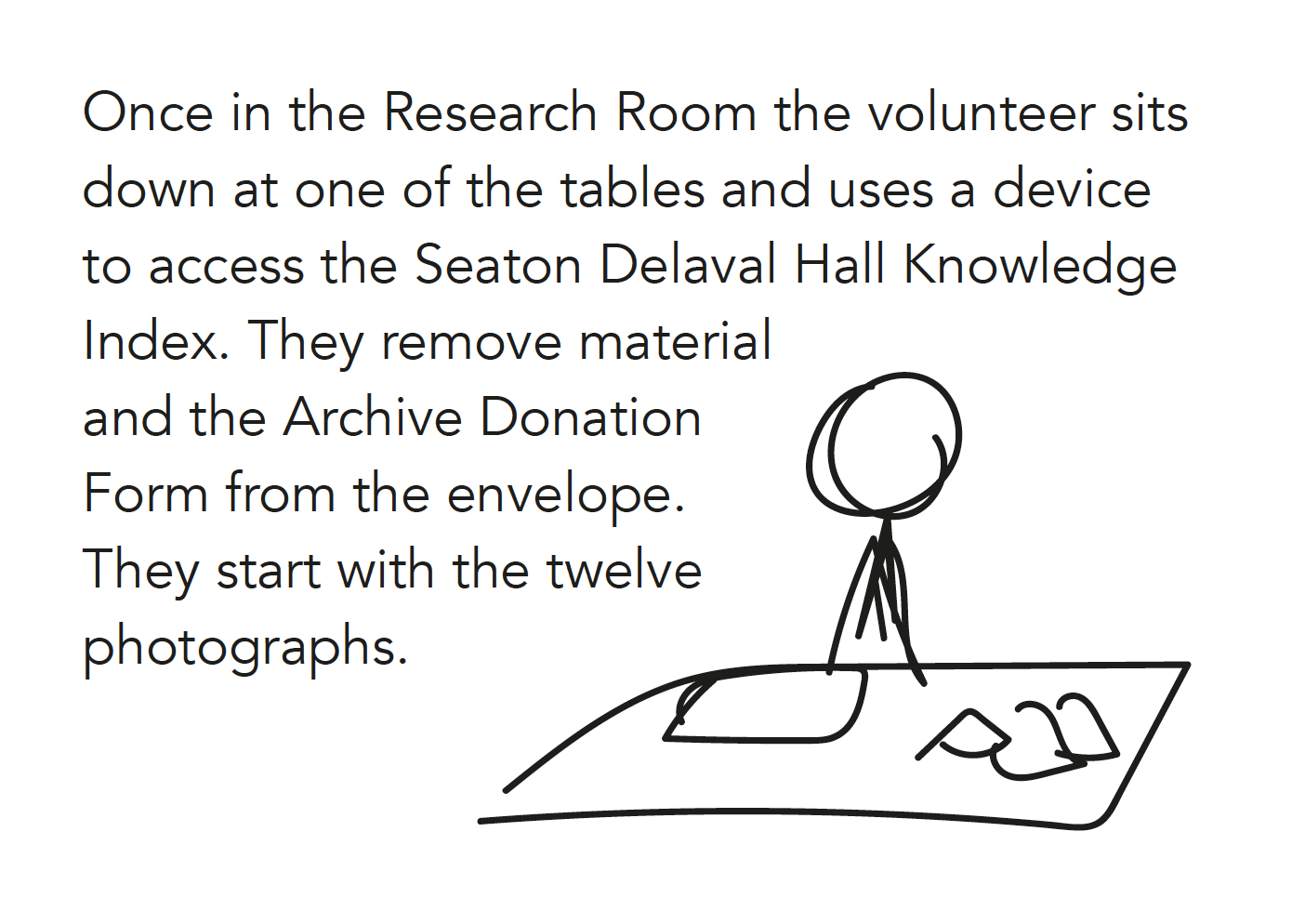
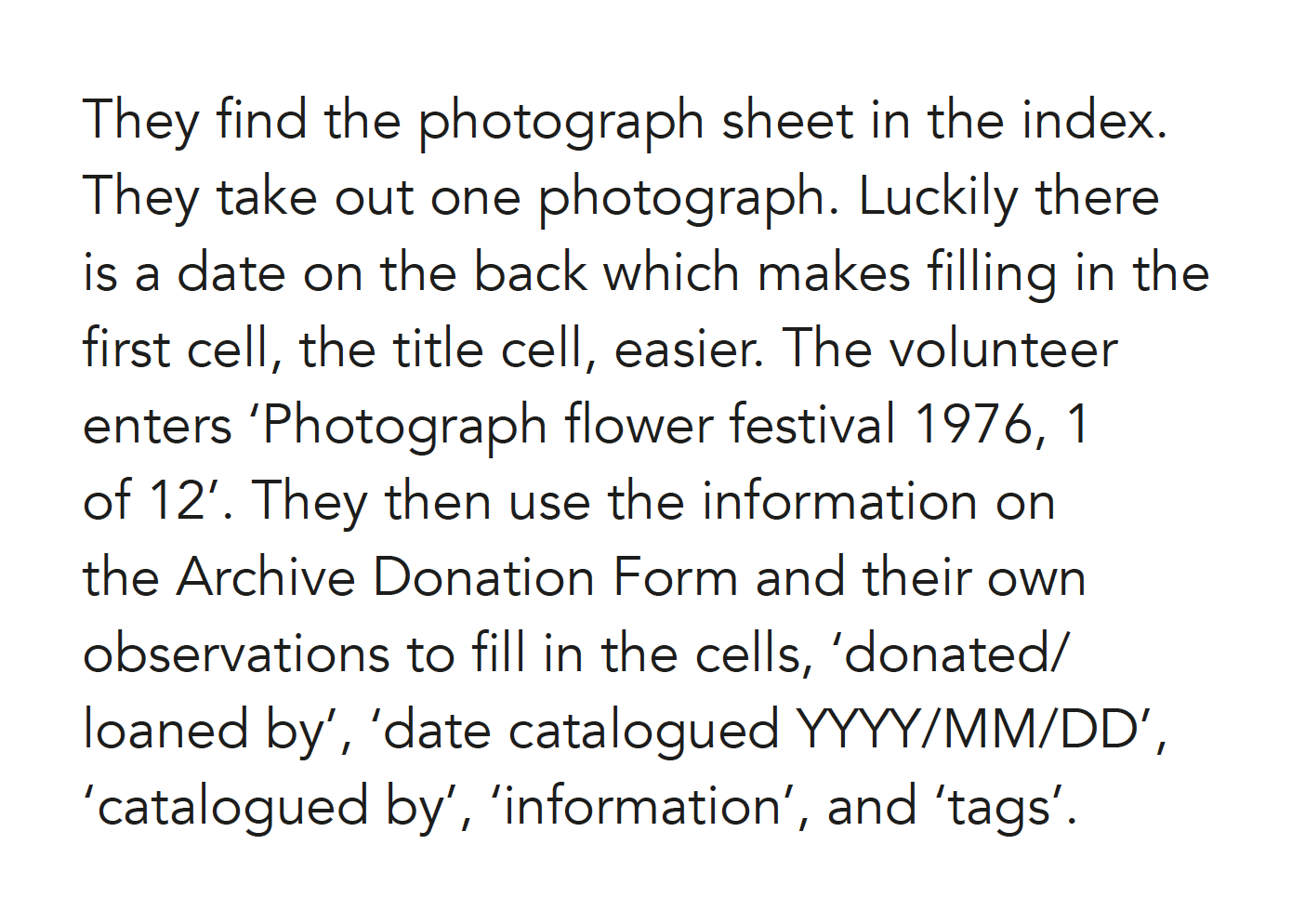
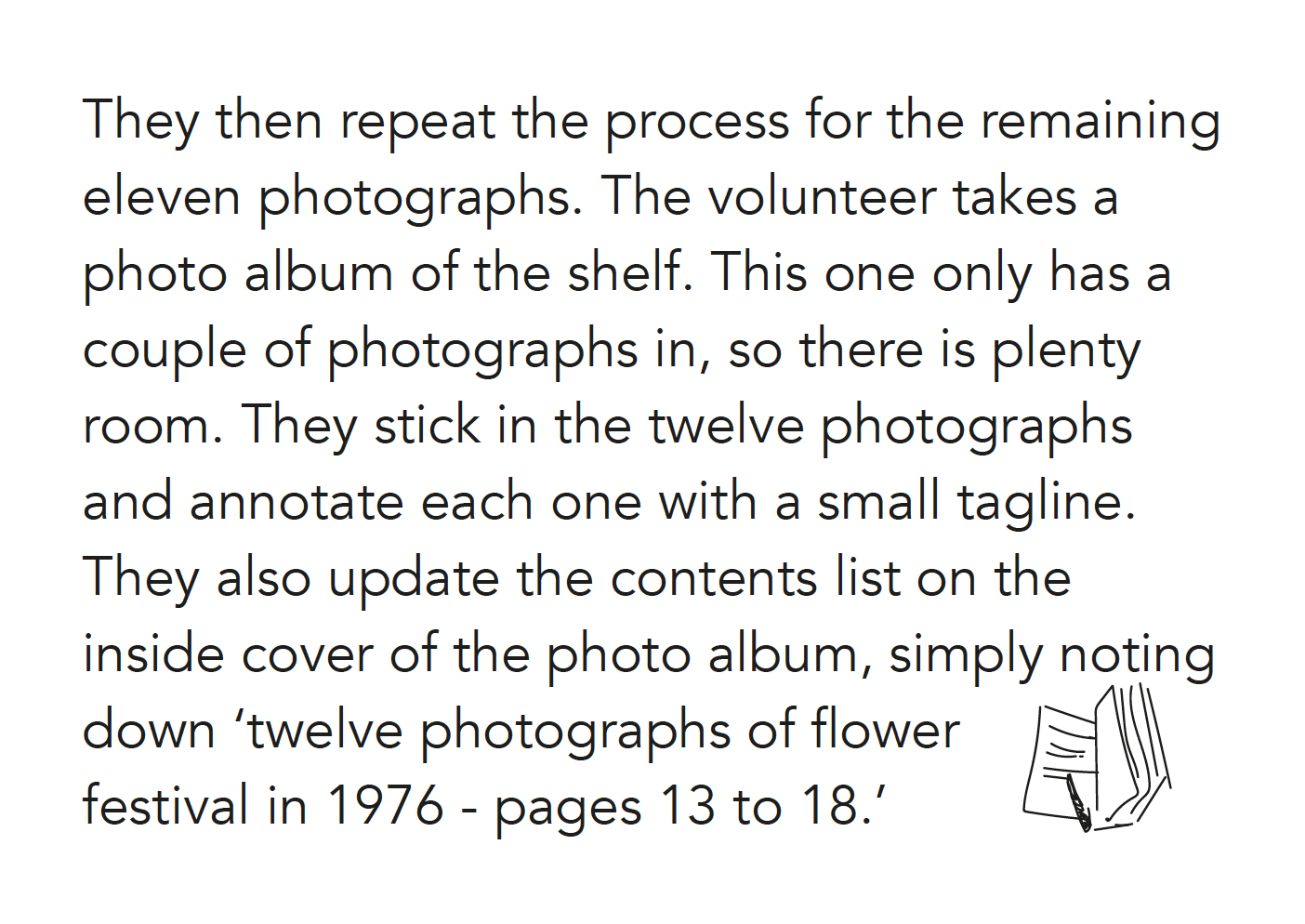
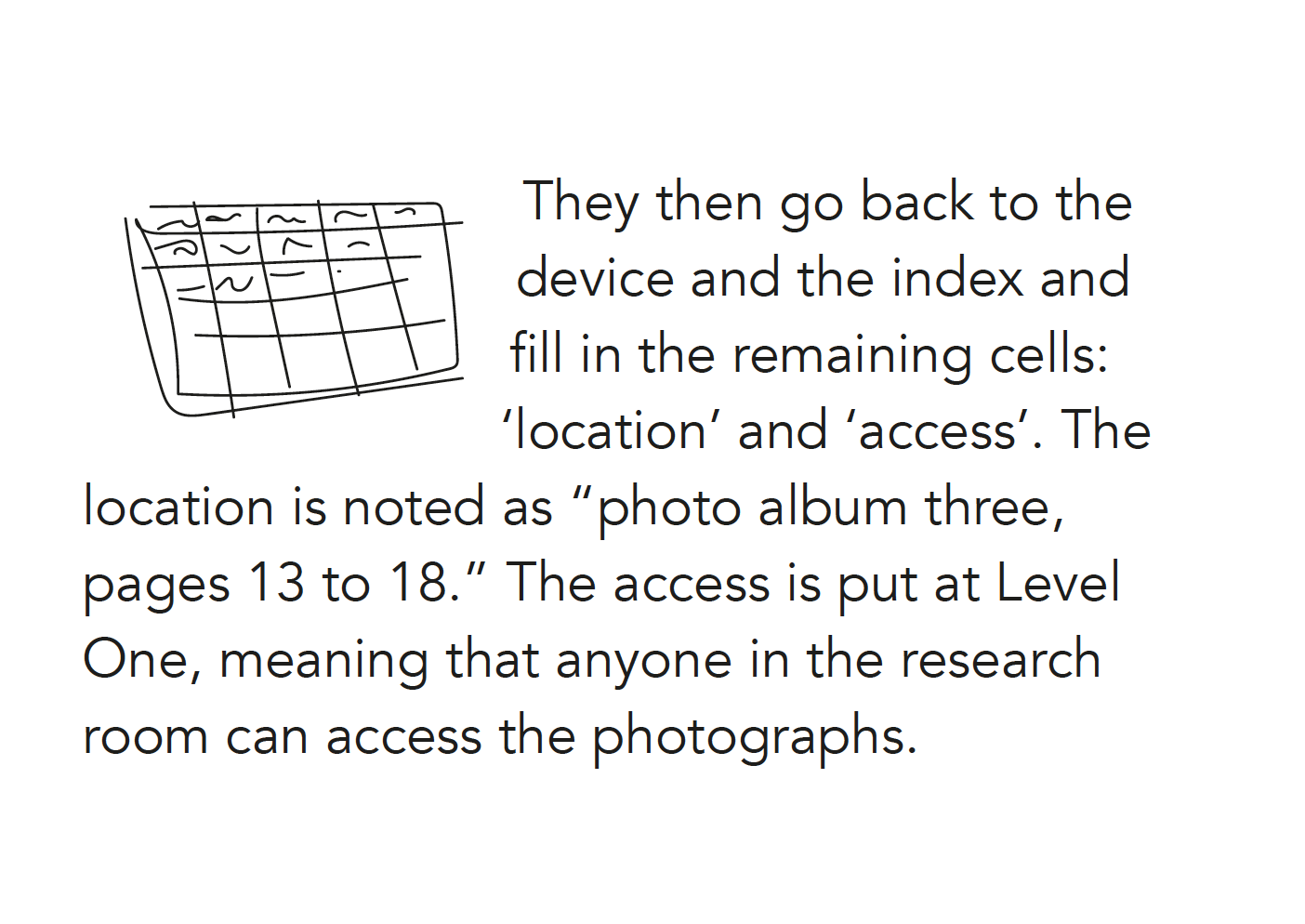
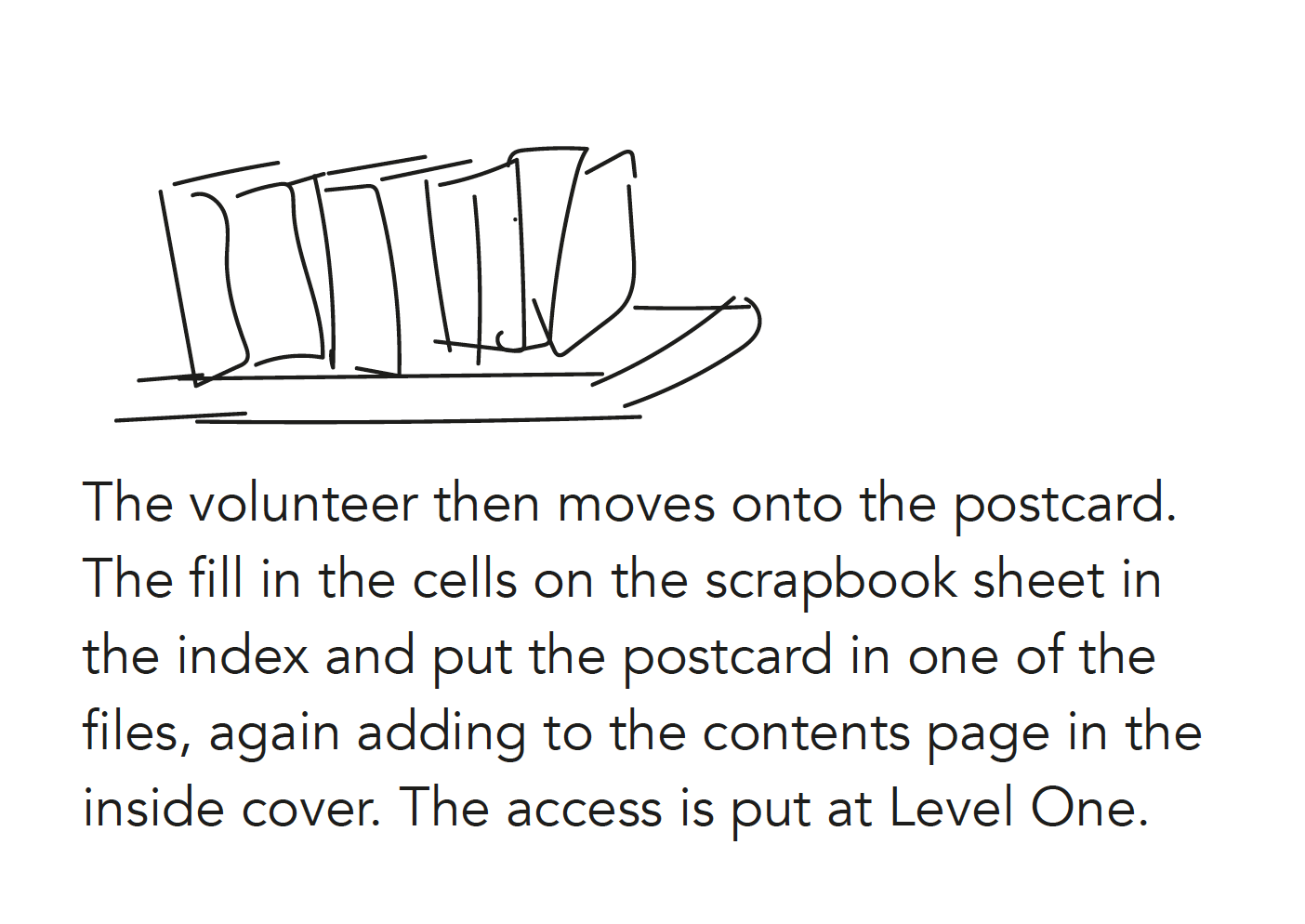
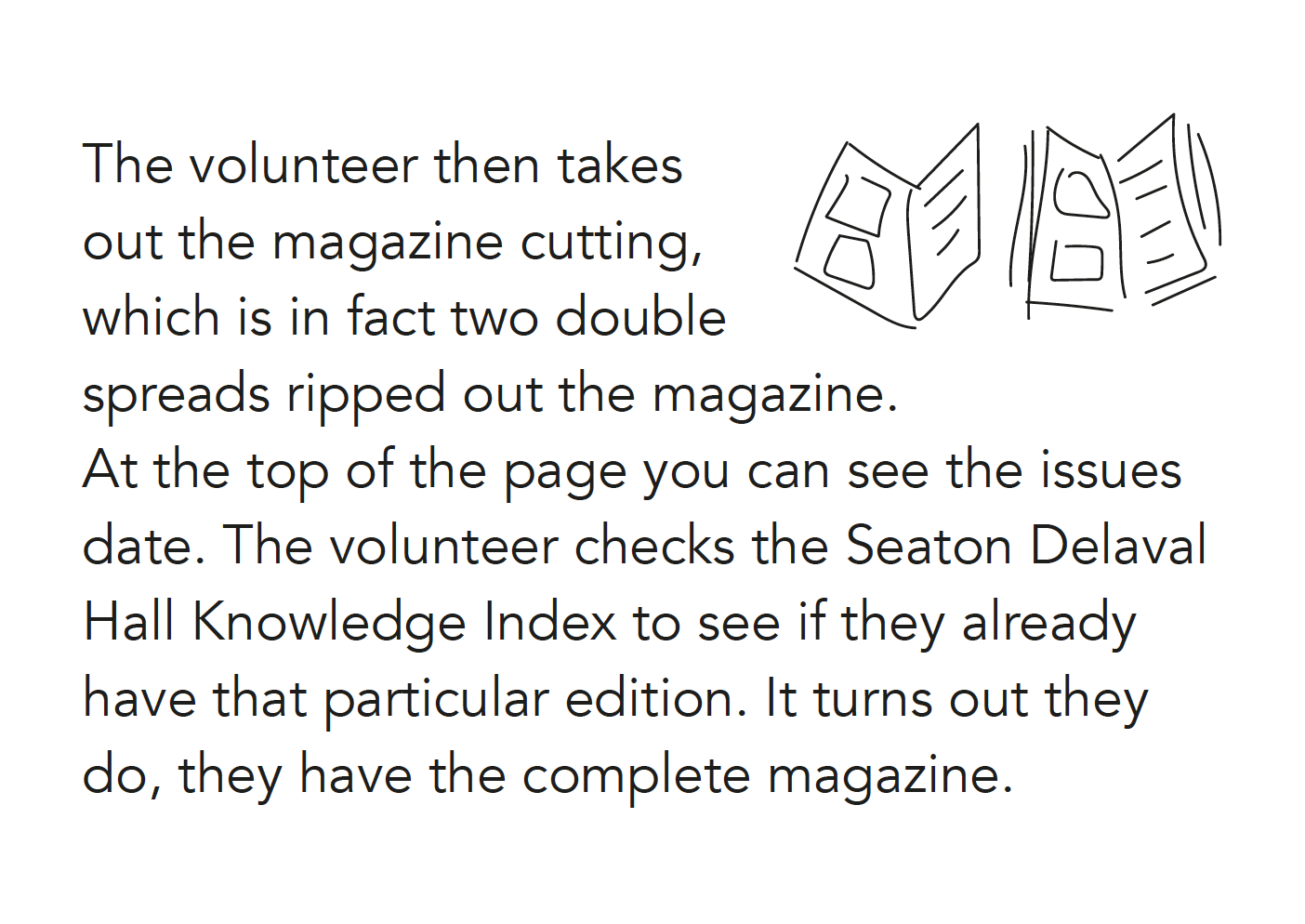
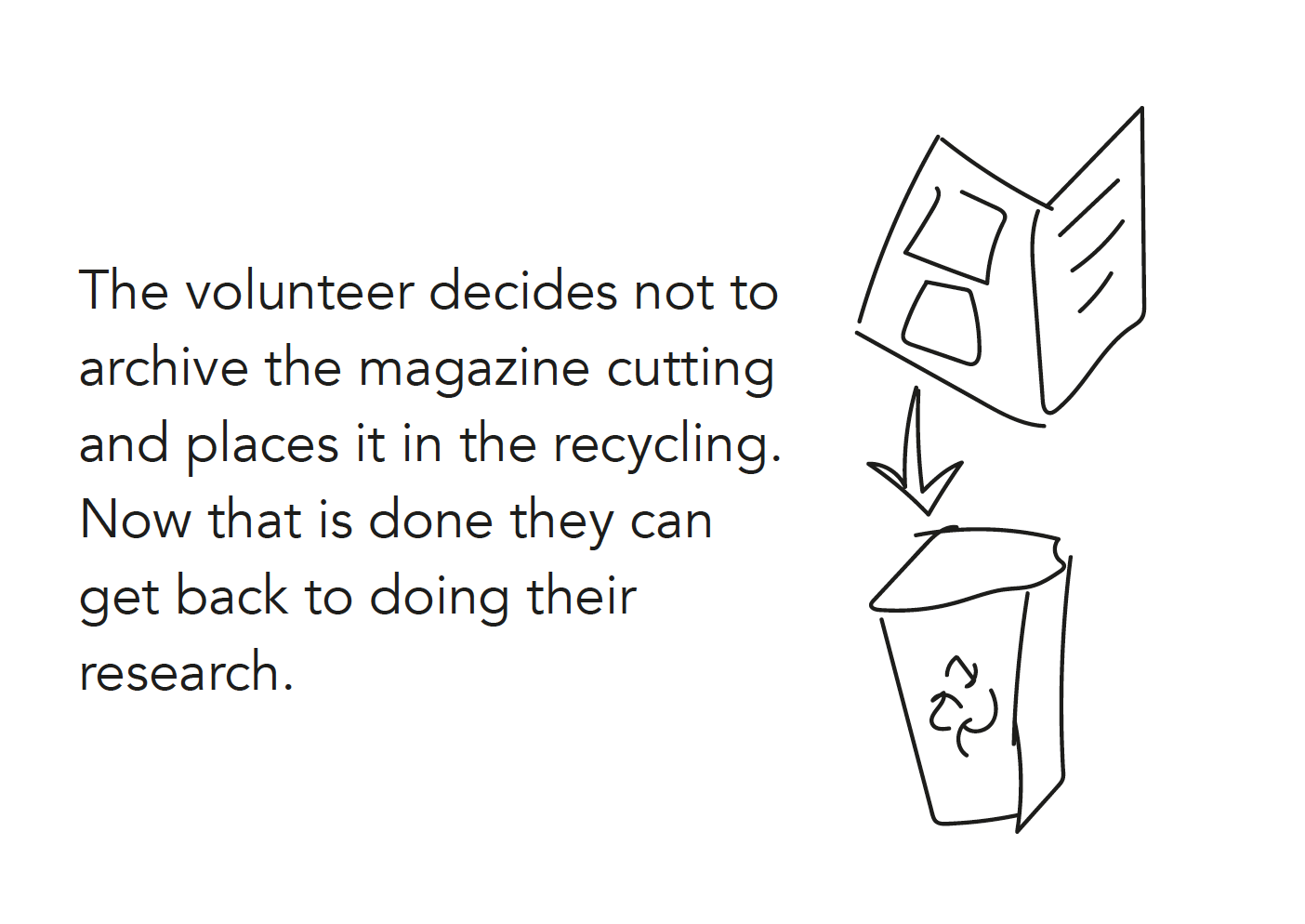
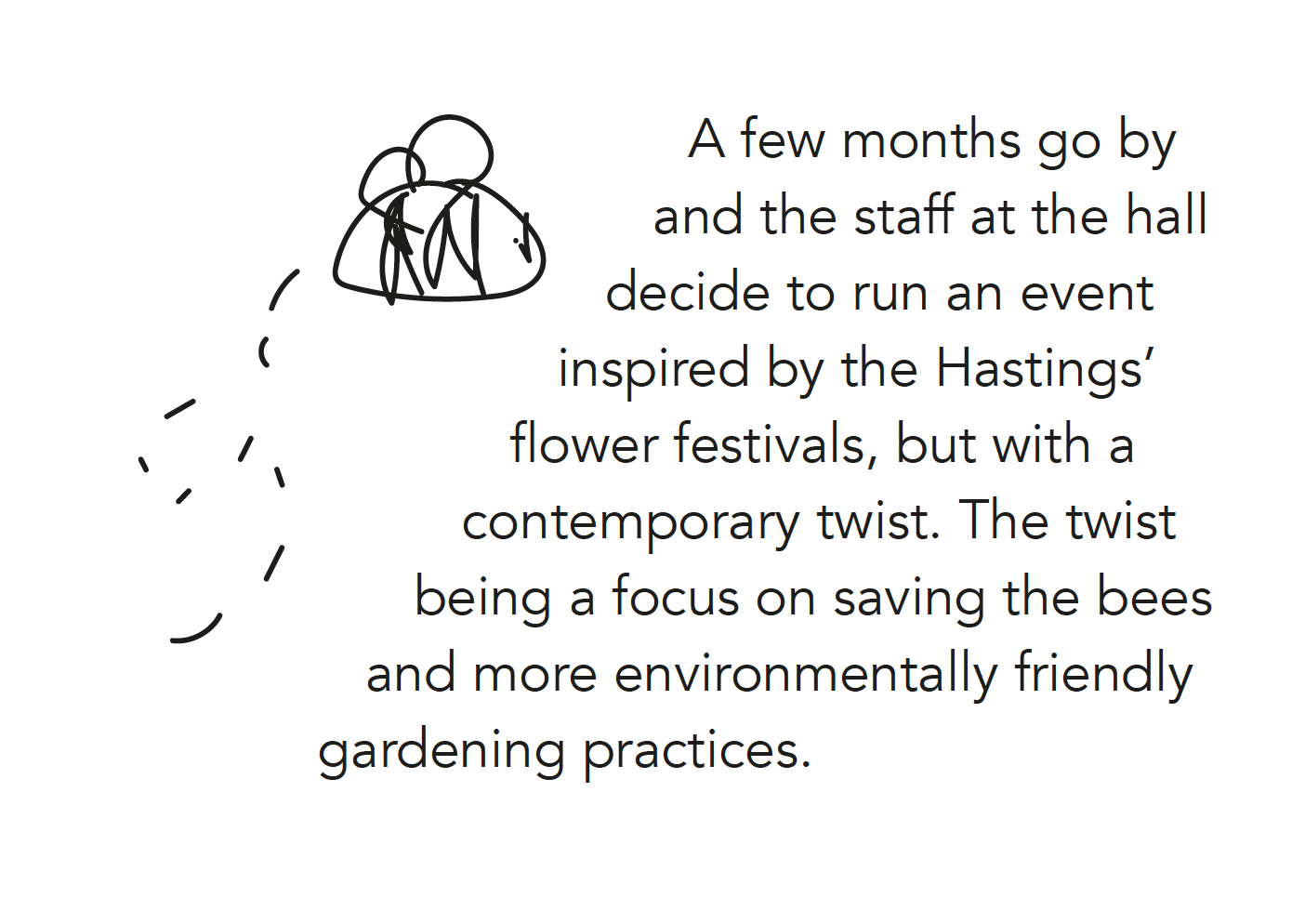
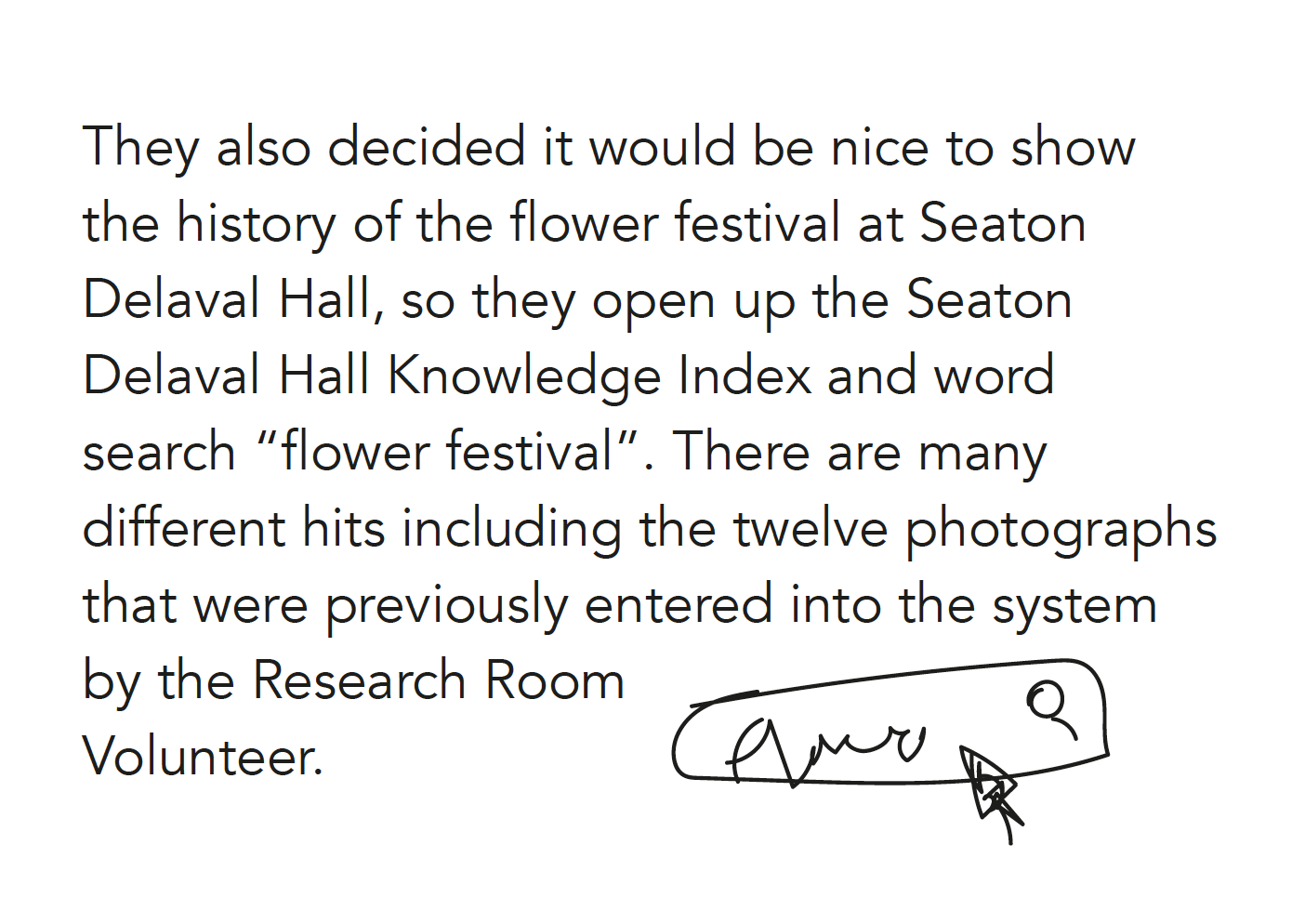
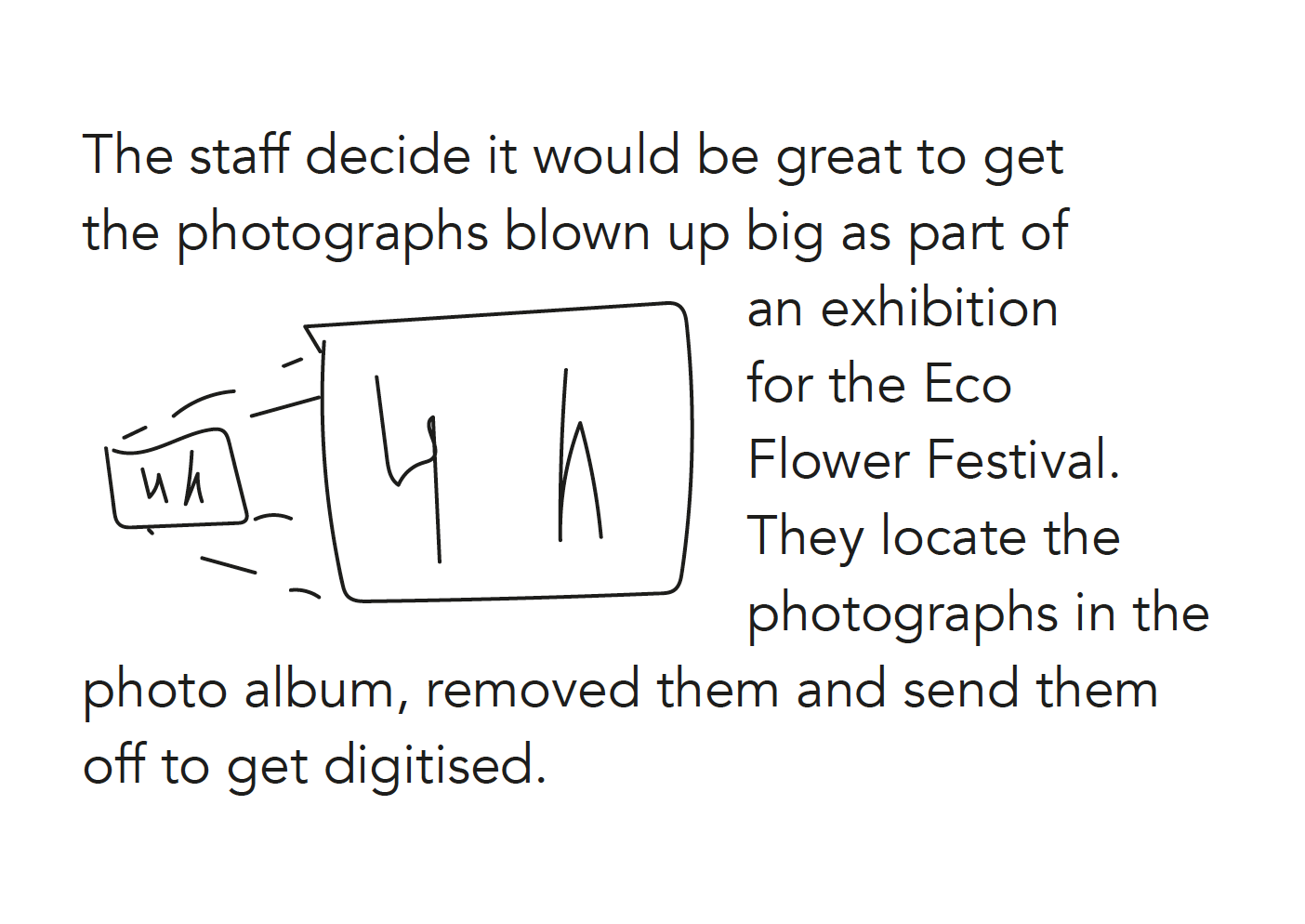
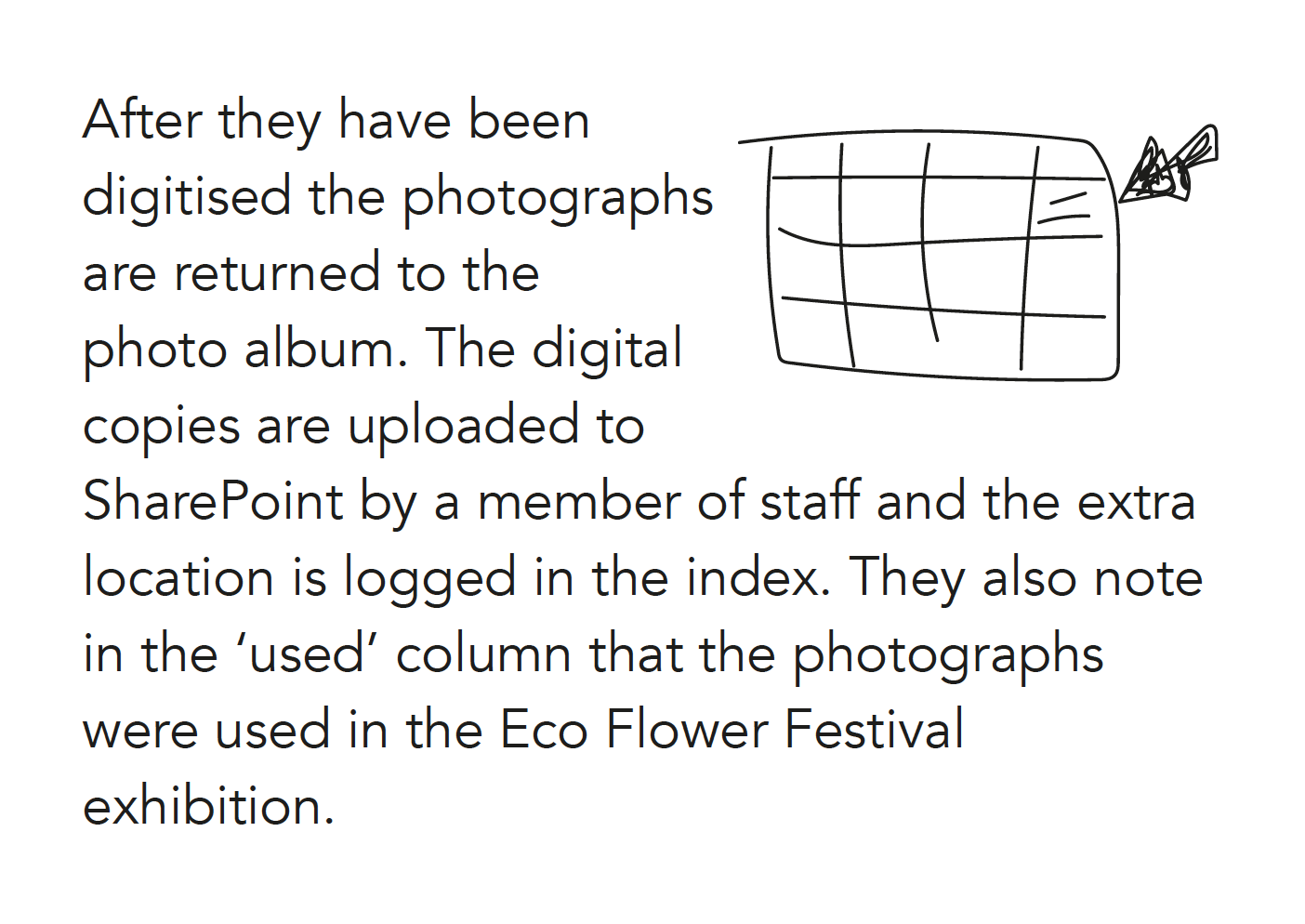
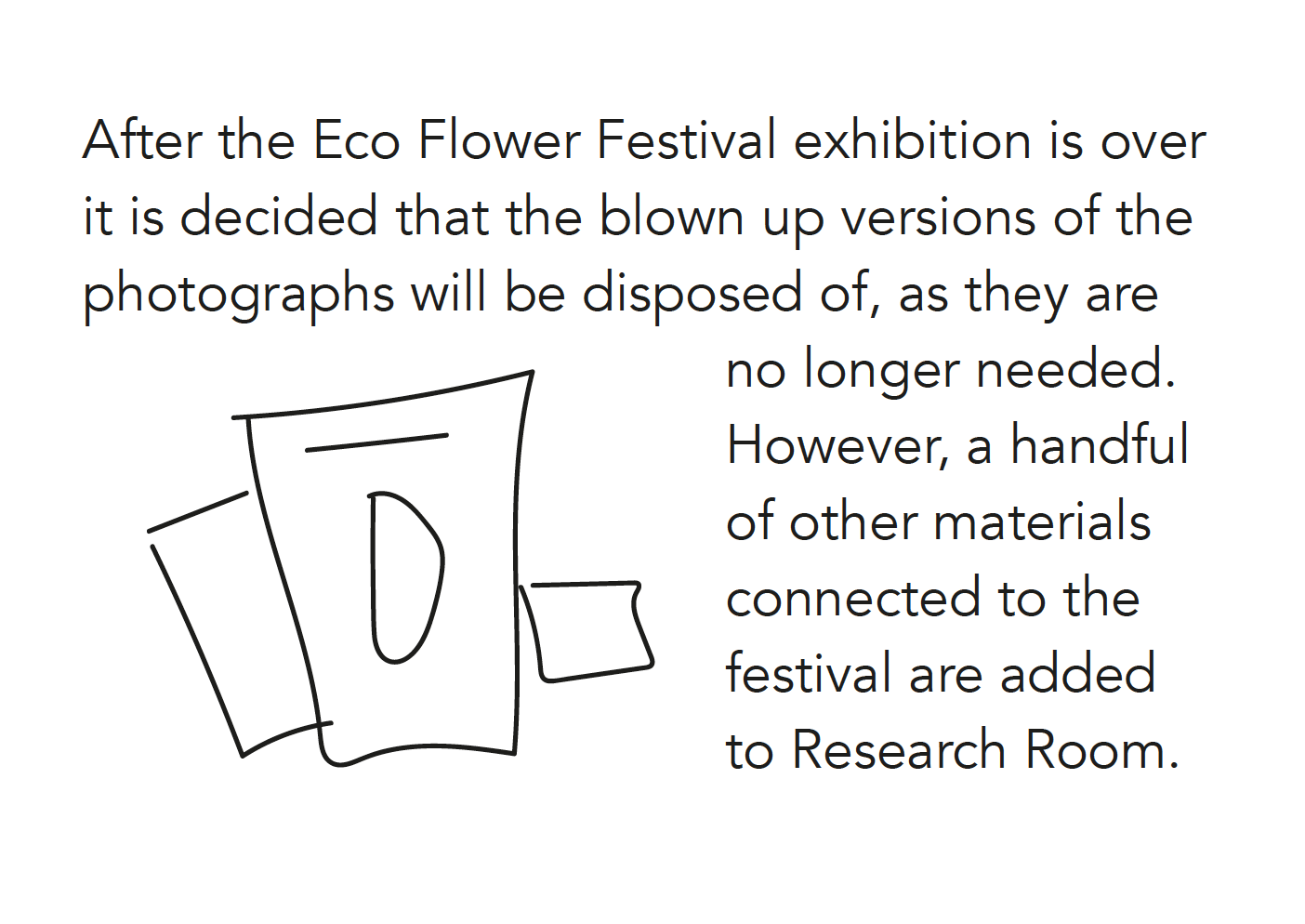

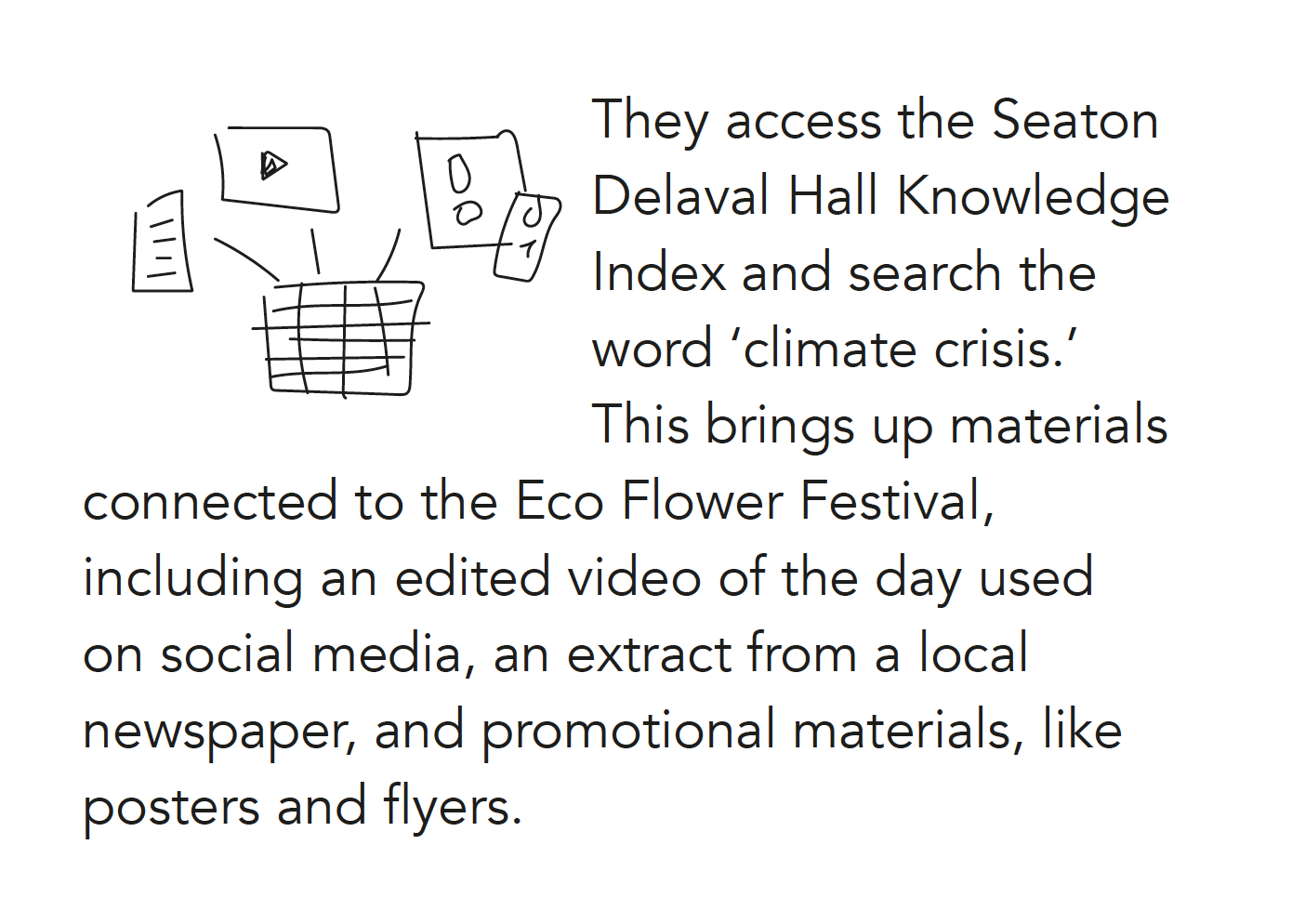
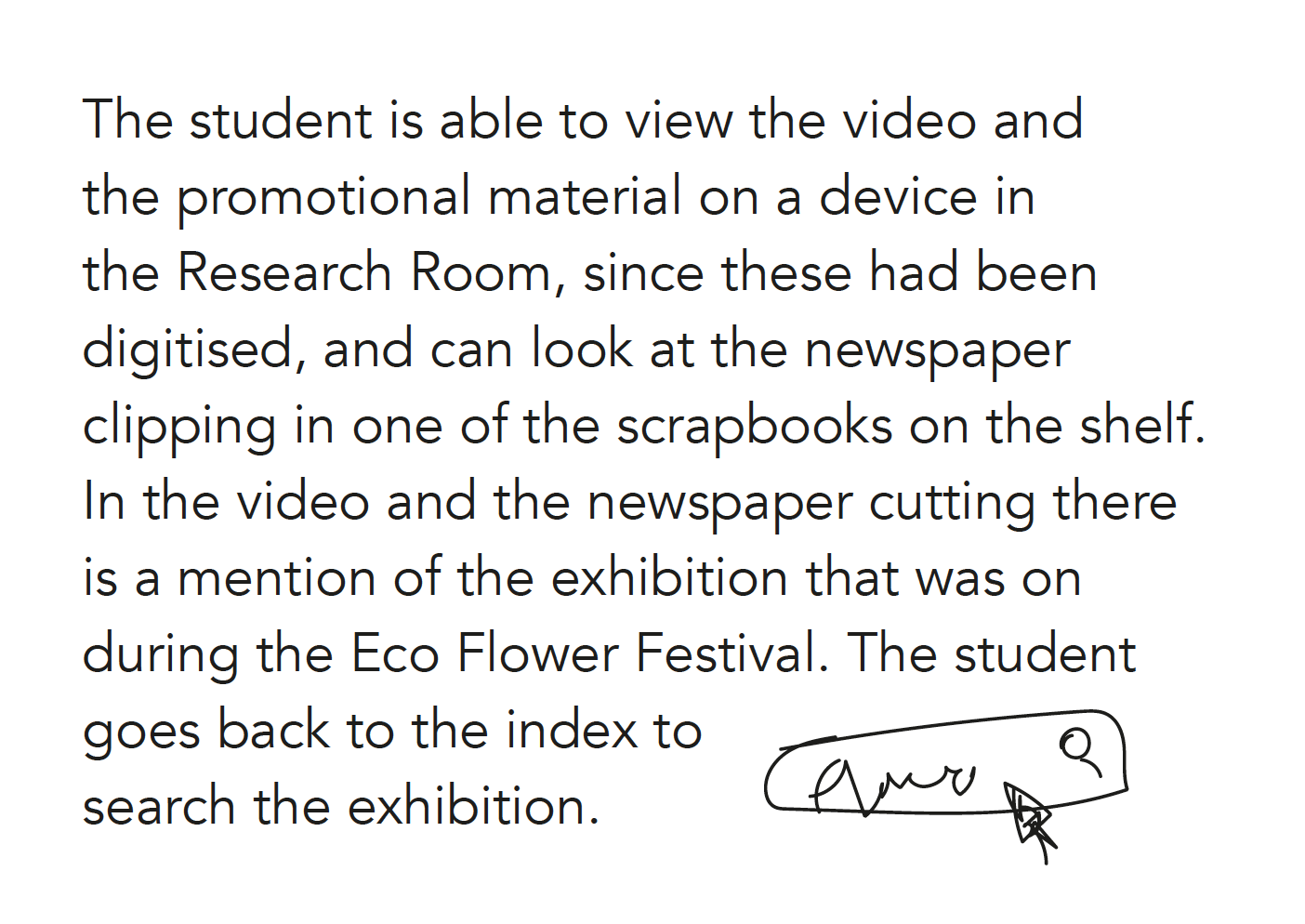
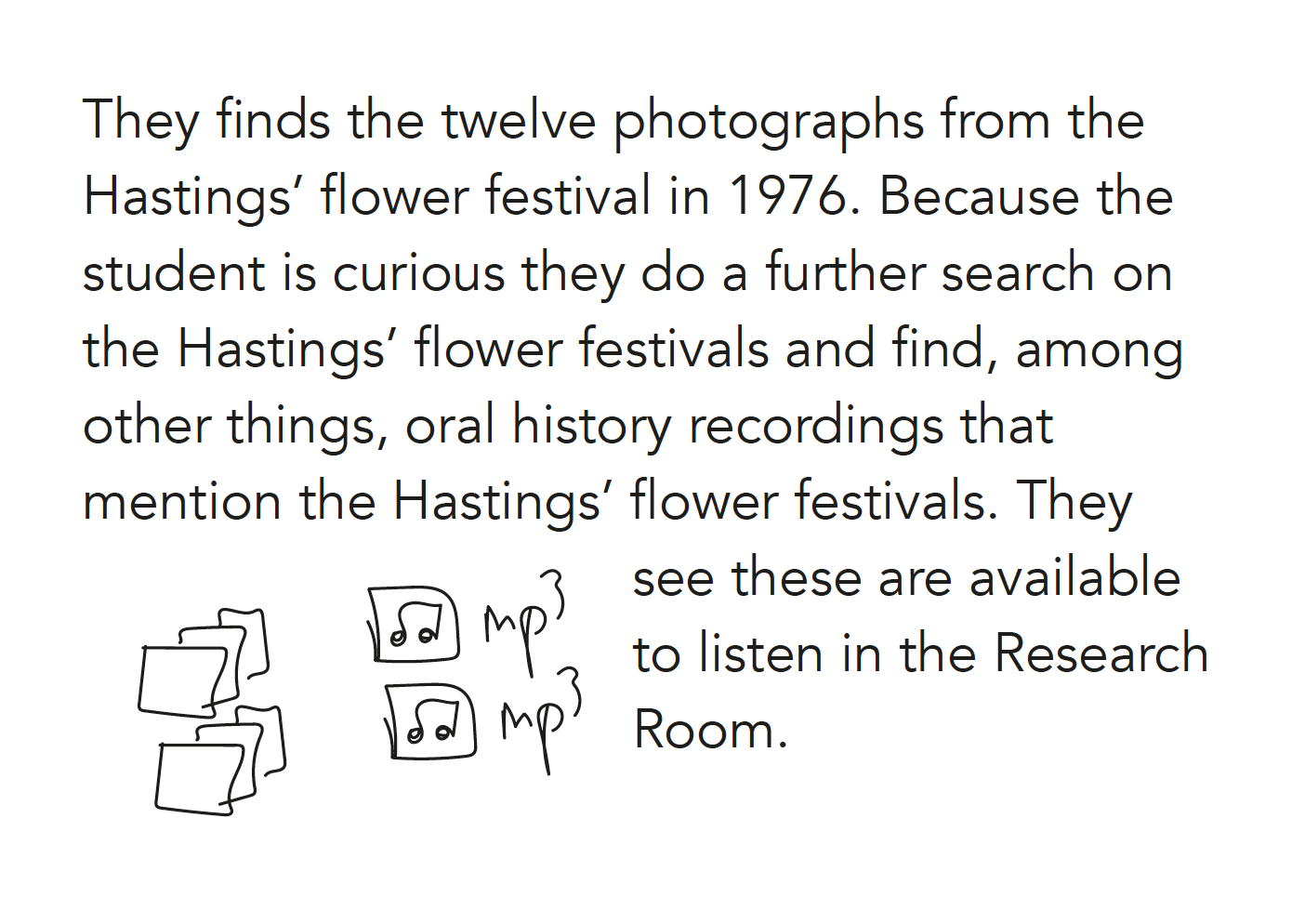

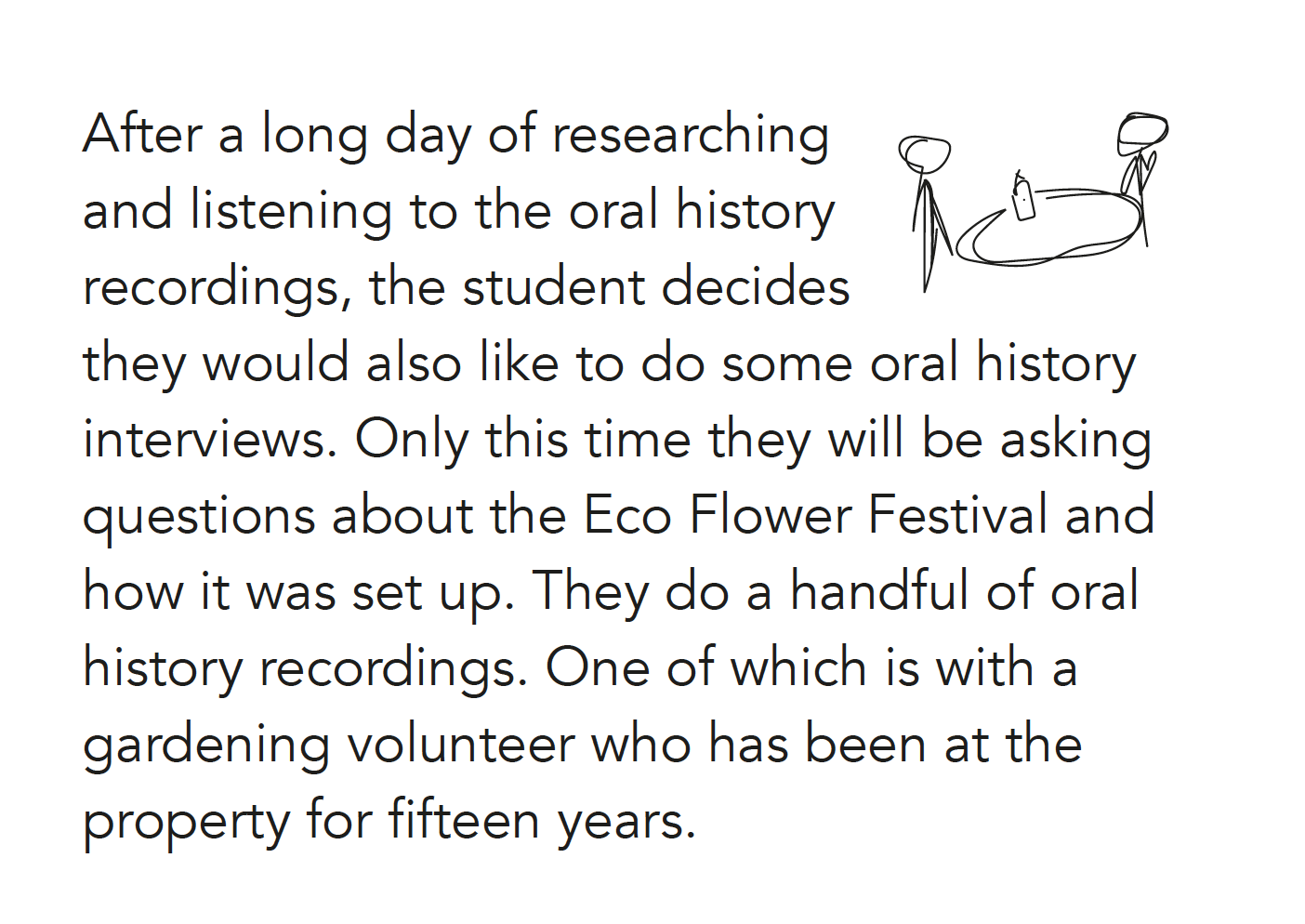

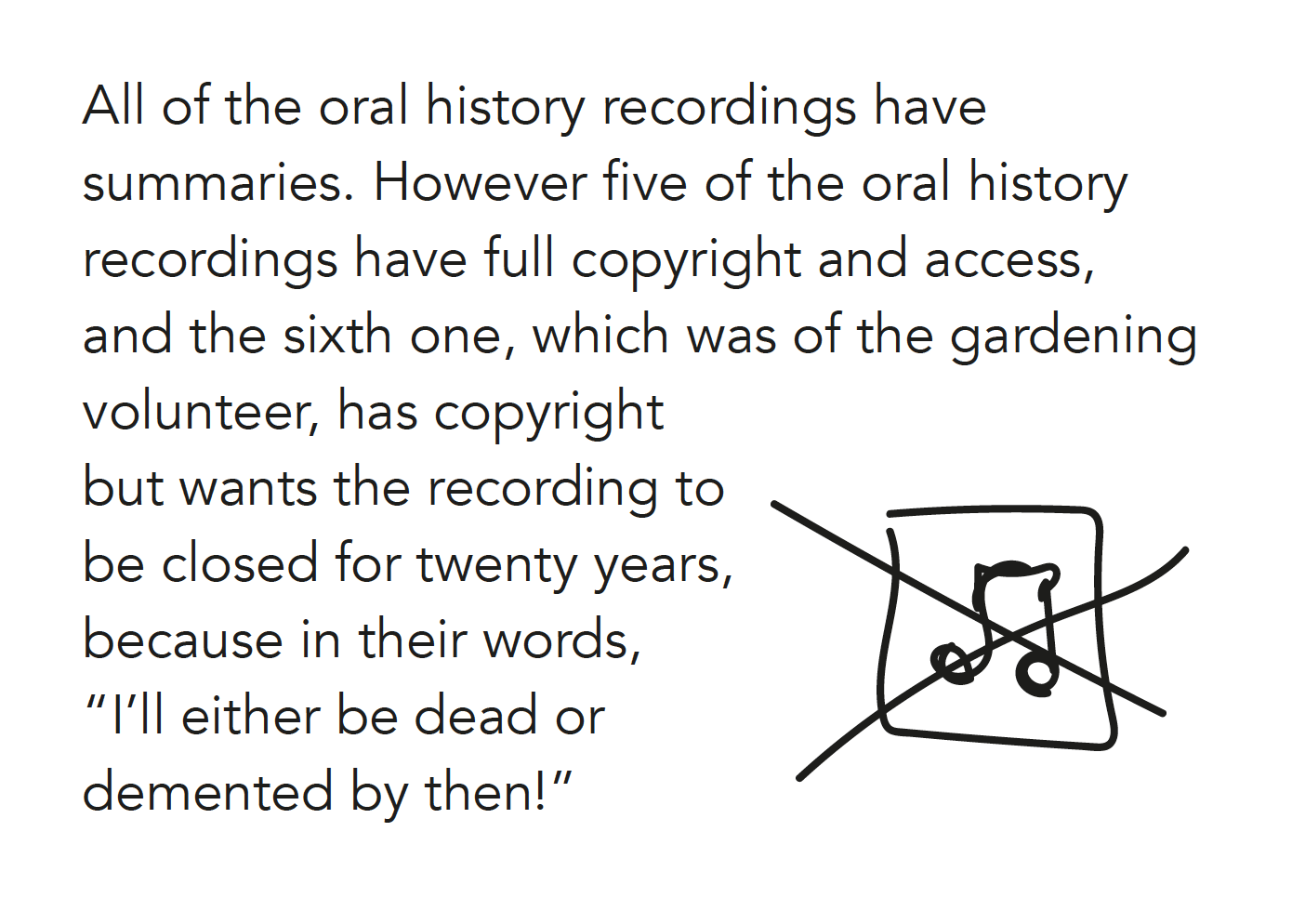
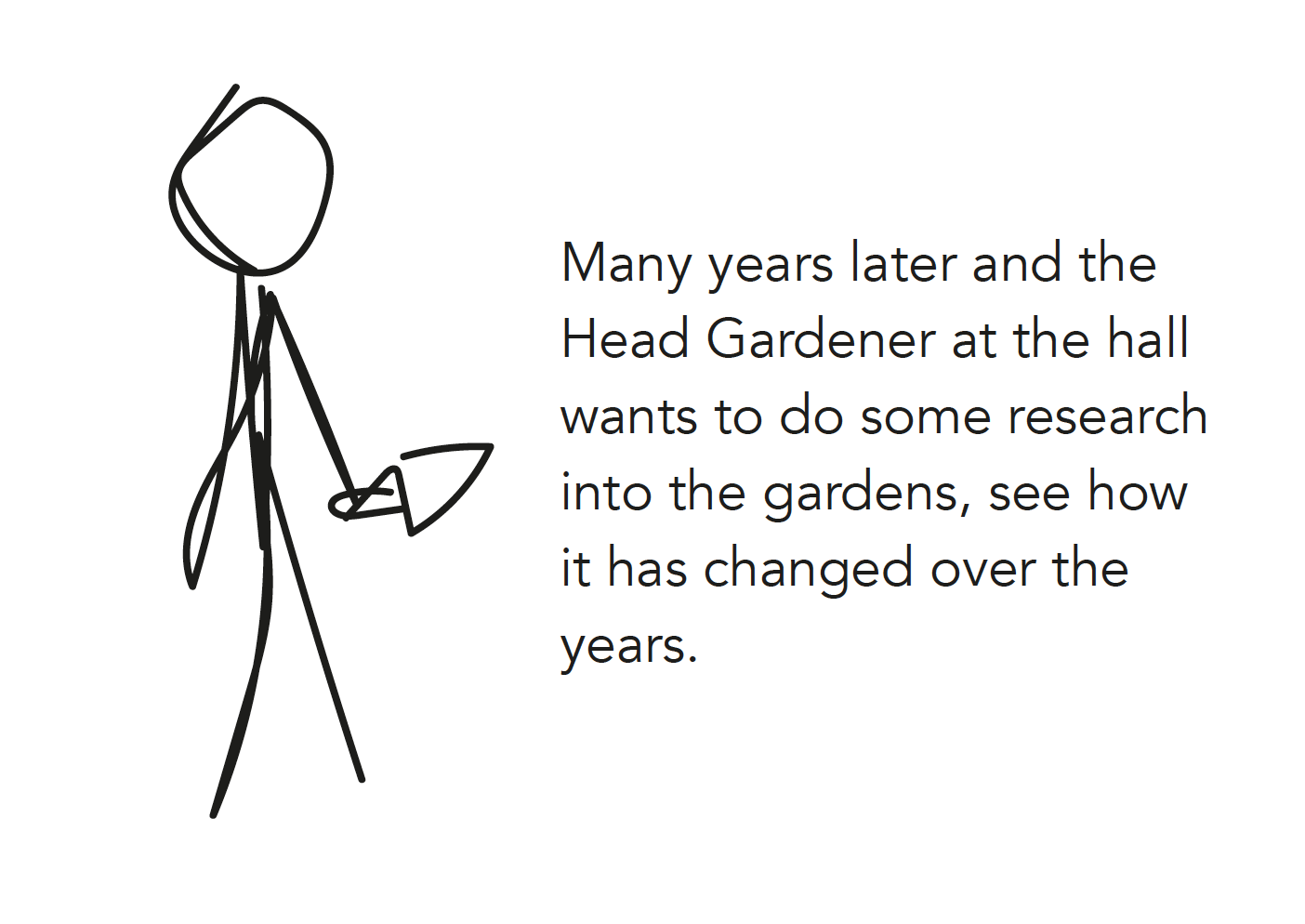
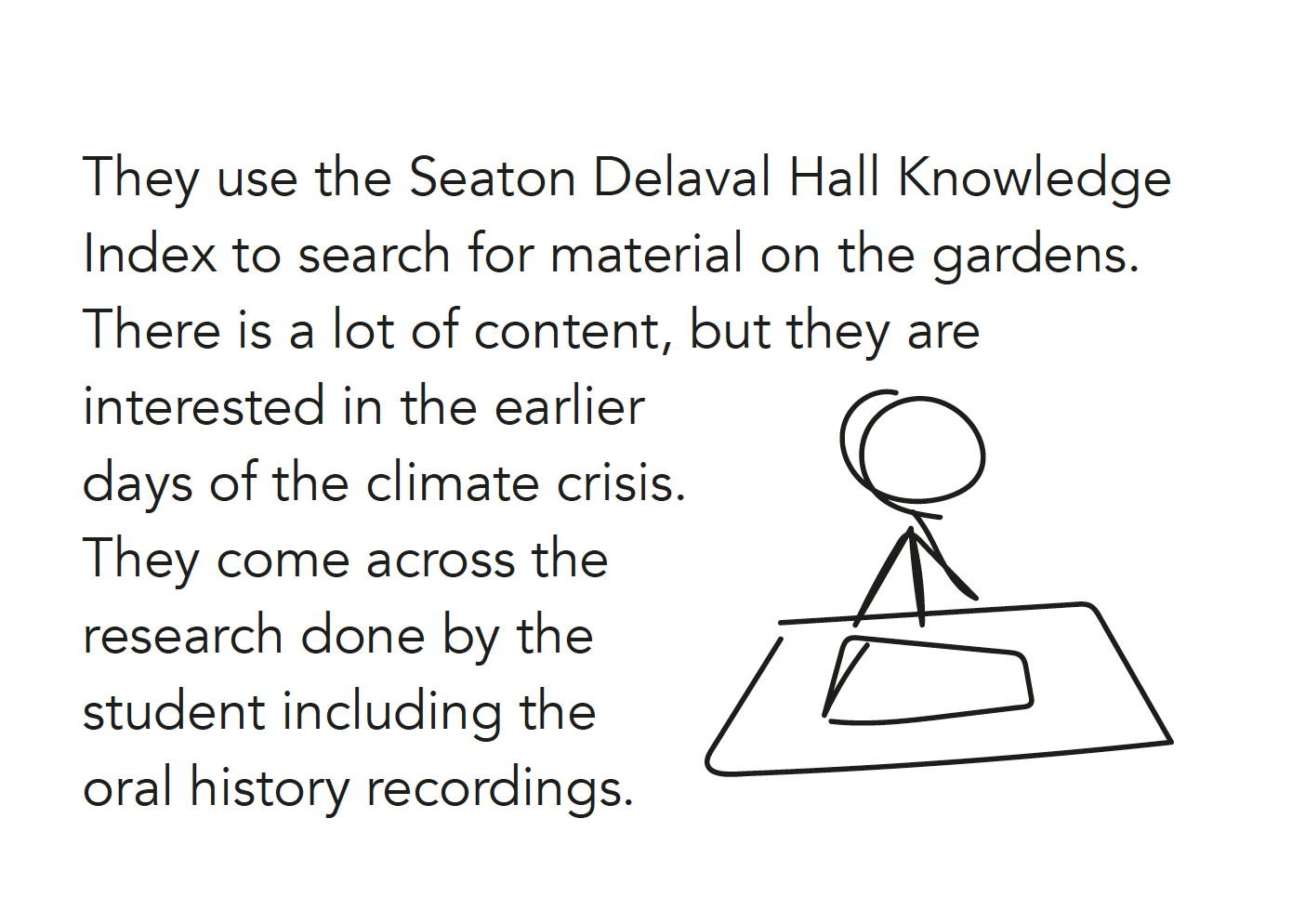
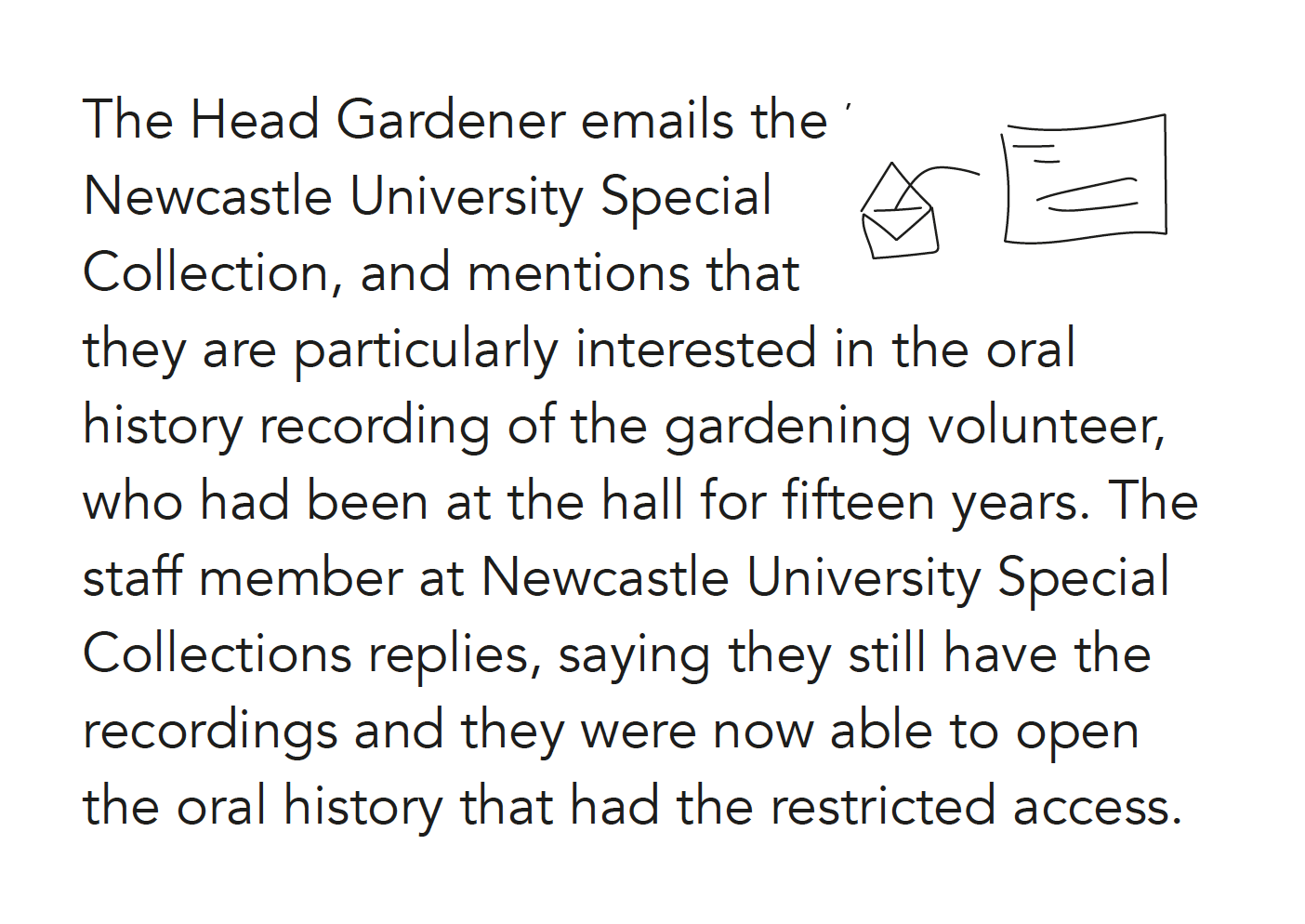
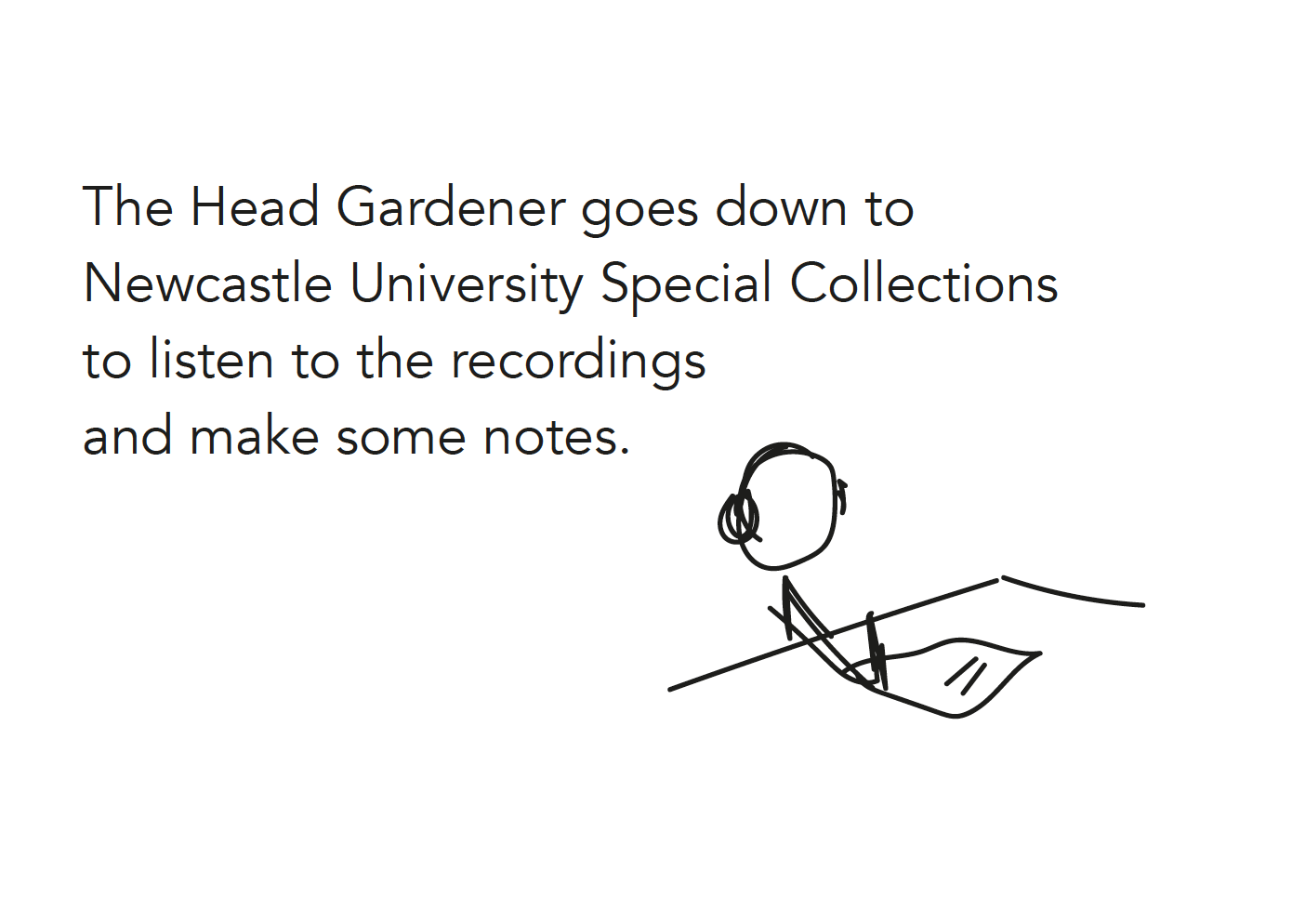
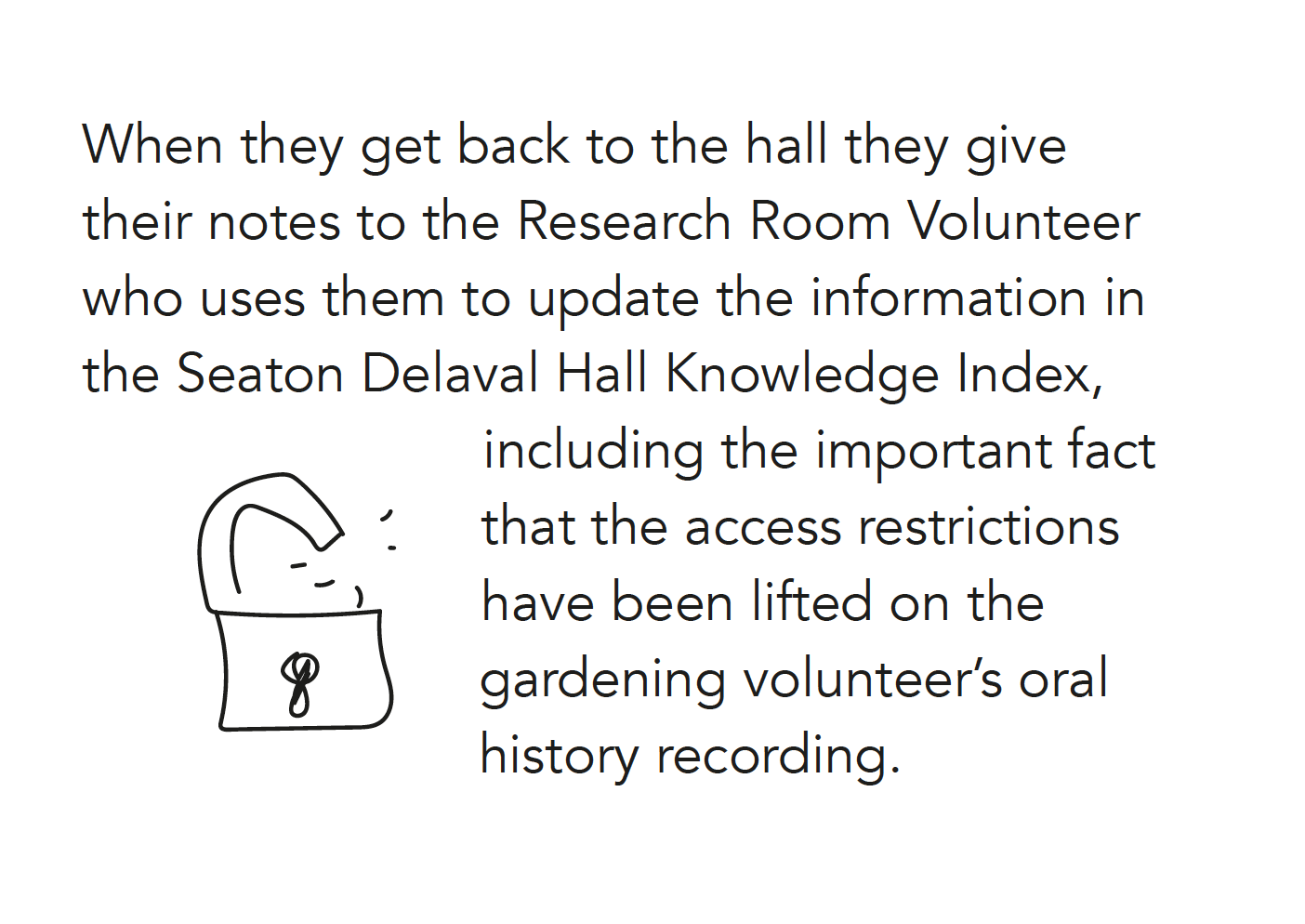
Research Room Design Fiction – OHD_DSF_0182
sdh. 010 What I realised through this design fiction was the way in which the particulars of the Research Room’s structure and process would be shaped by how the material is classified. I therefore made various iterations of a flowchart which allowed me to map the different items that people could donate and the accompanying paperwork and processes that would allow the donated item to be made accessible in the Research Room.12
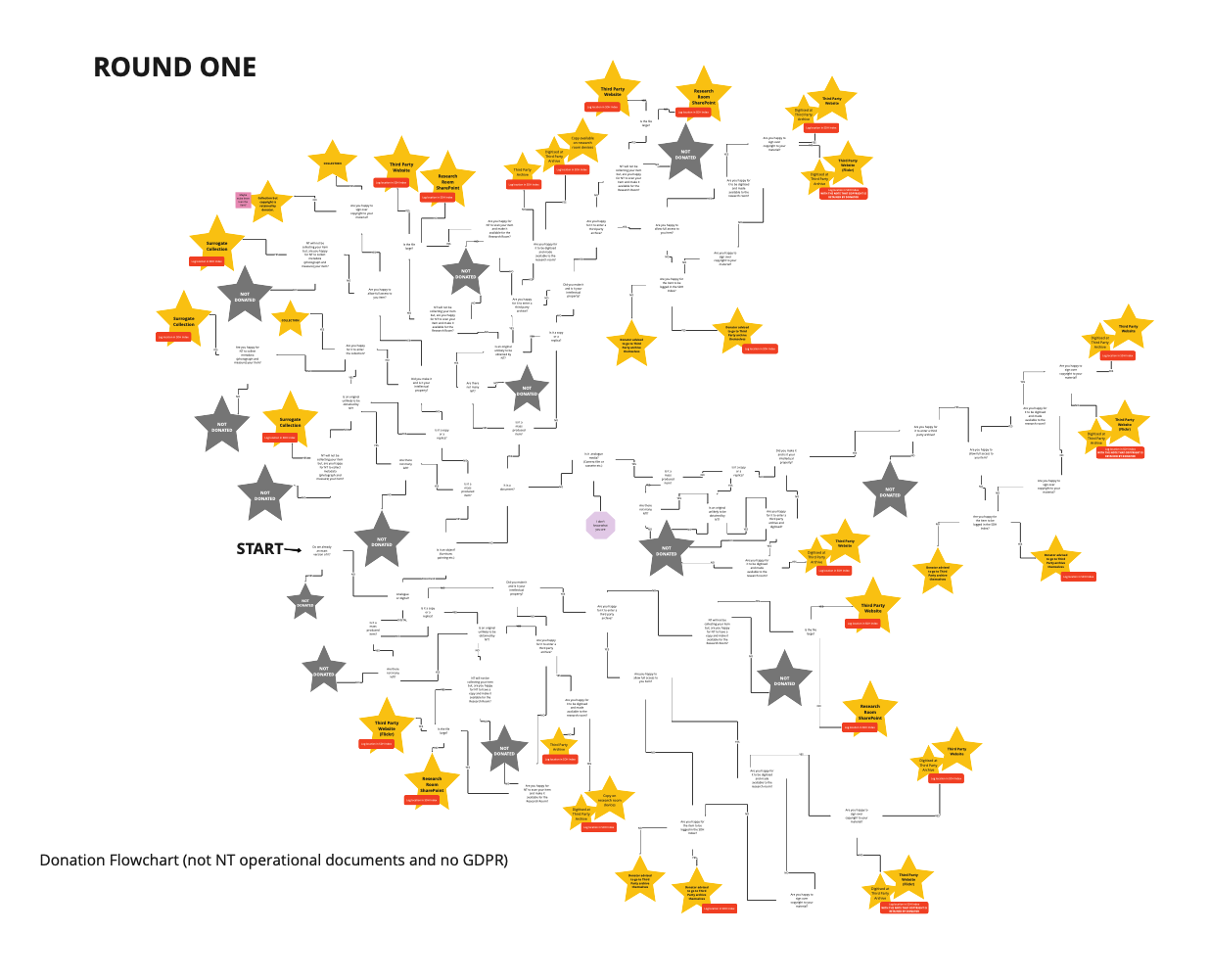

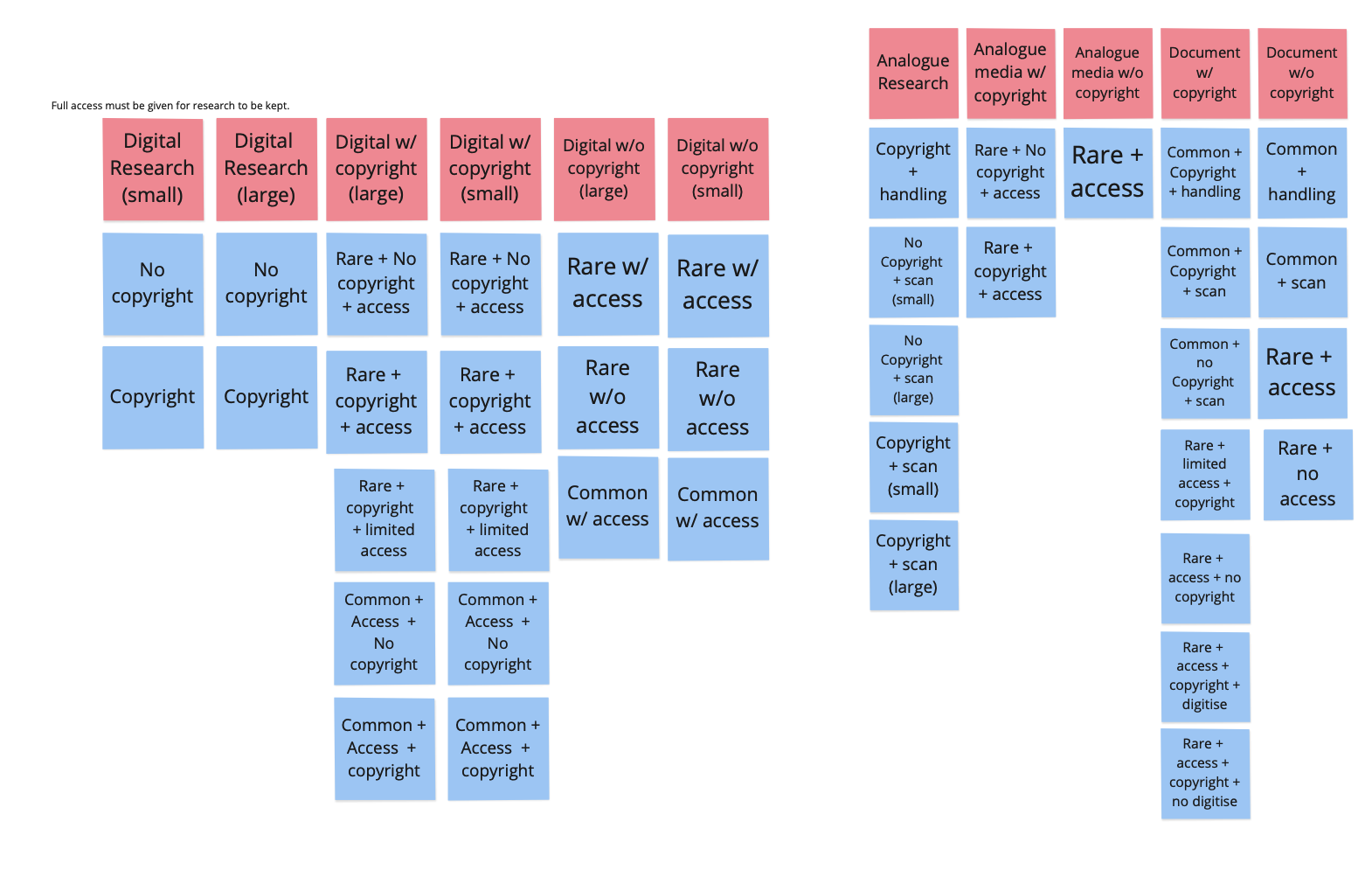
The Research Room flowcharts – OHD_DSN_0158
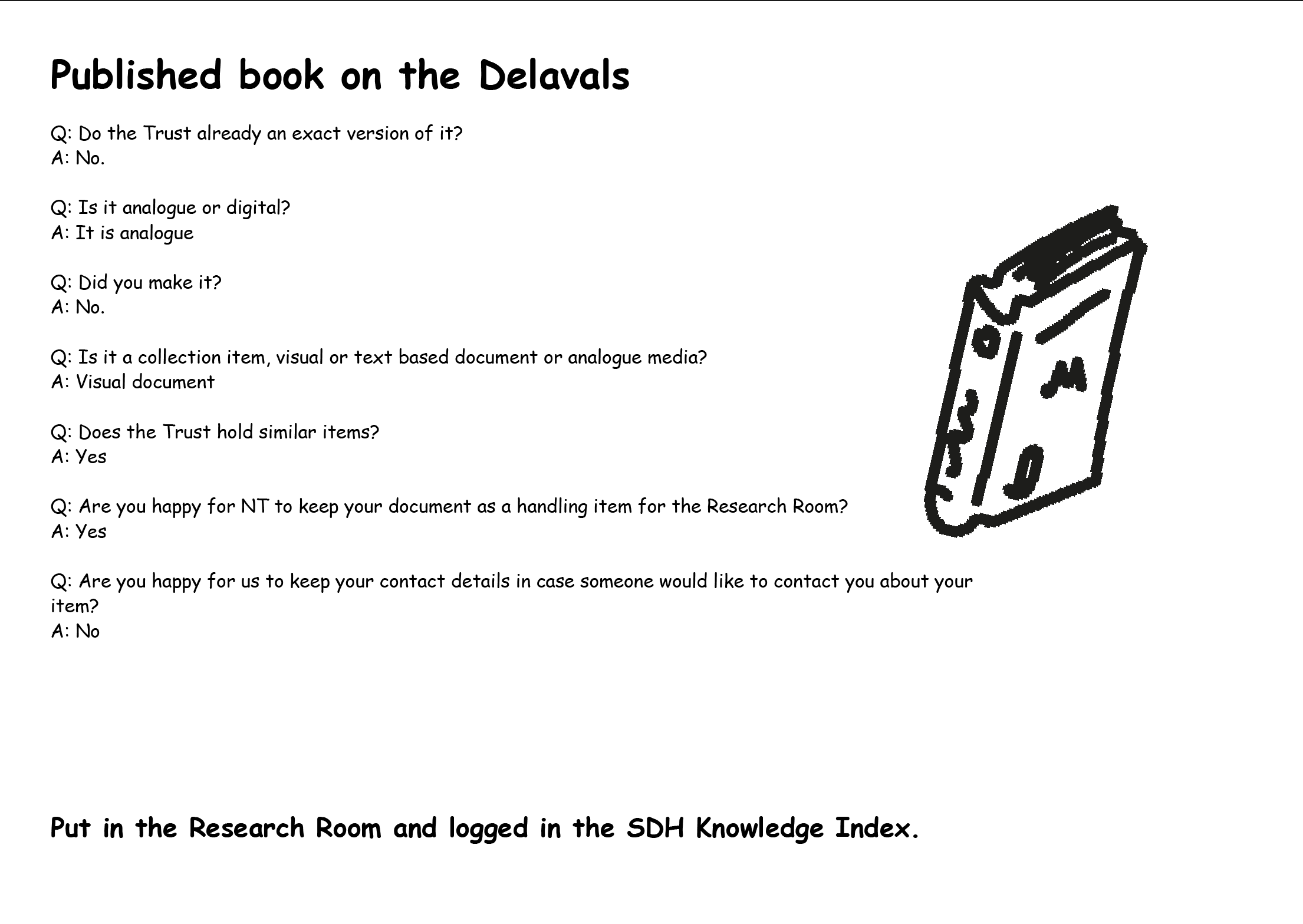
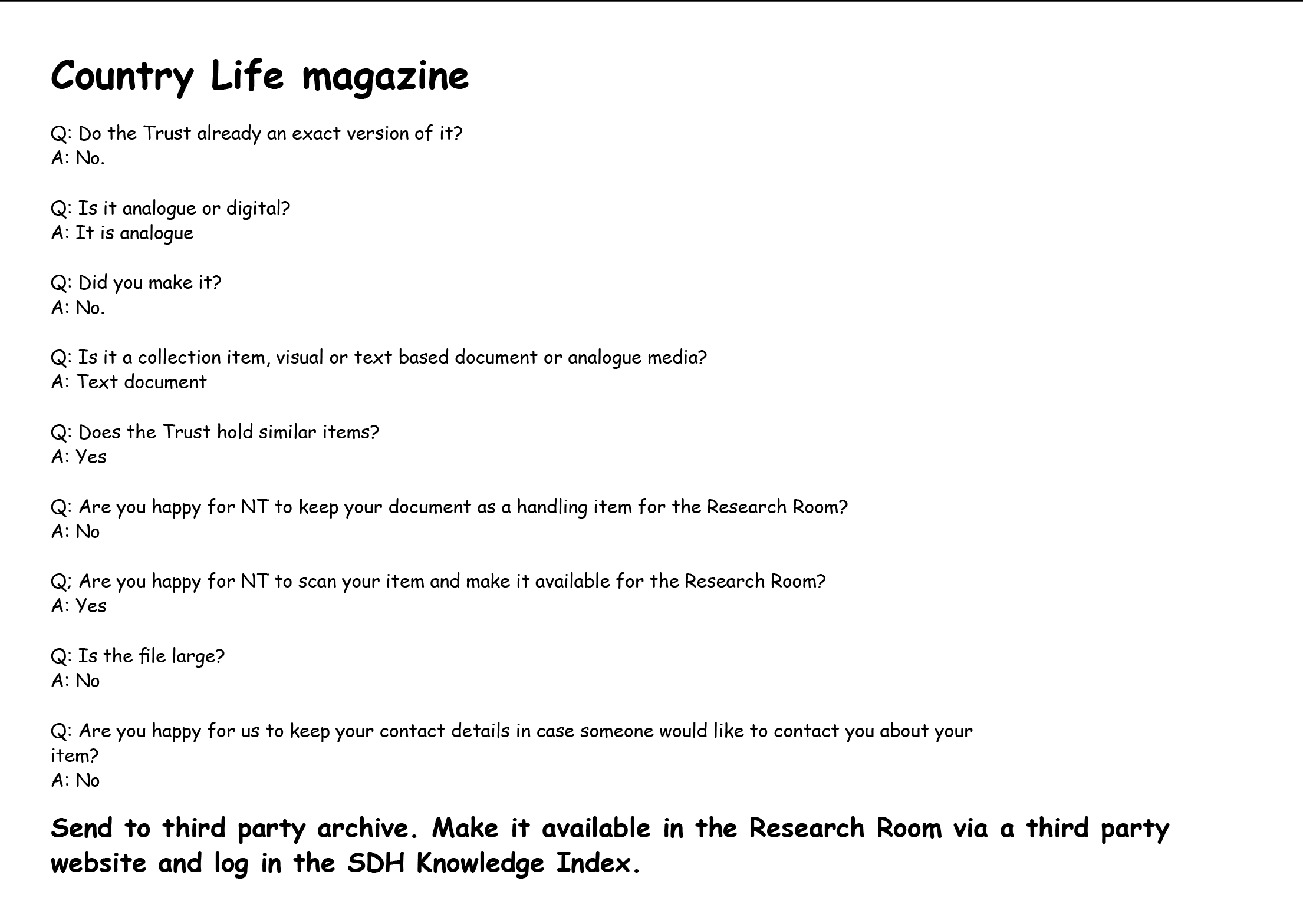
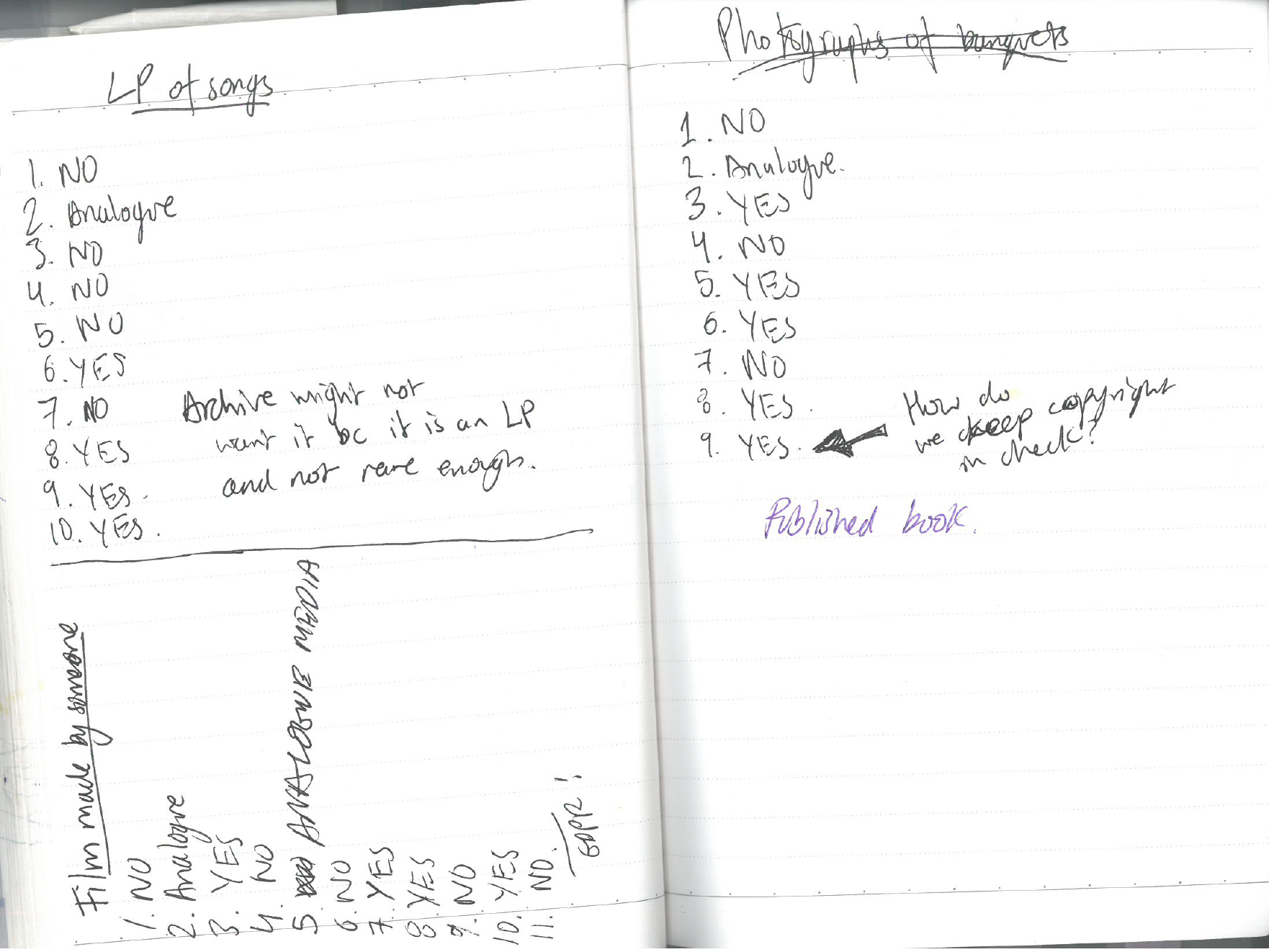
Testing the flowcharts – OHD_PRT_0188
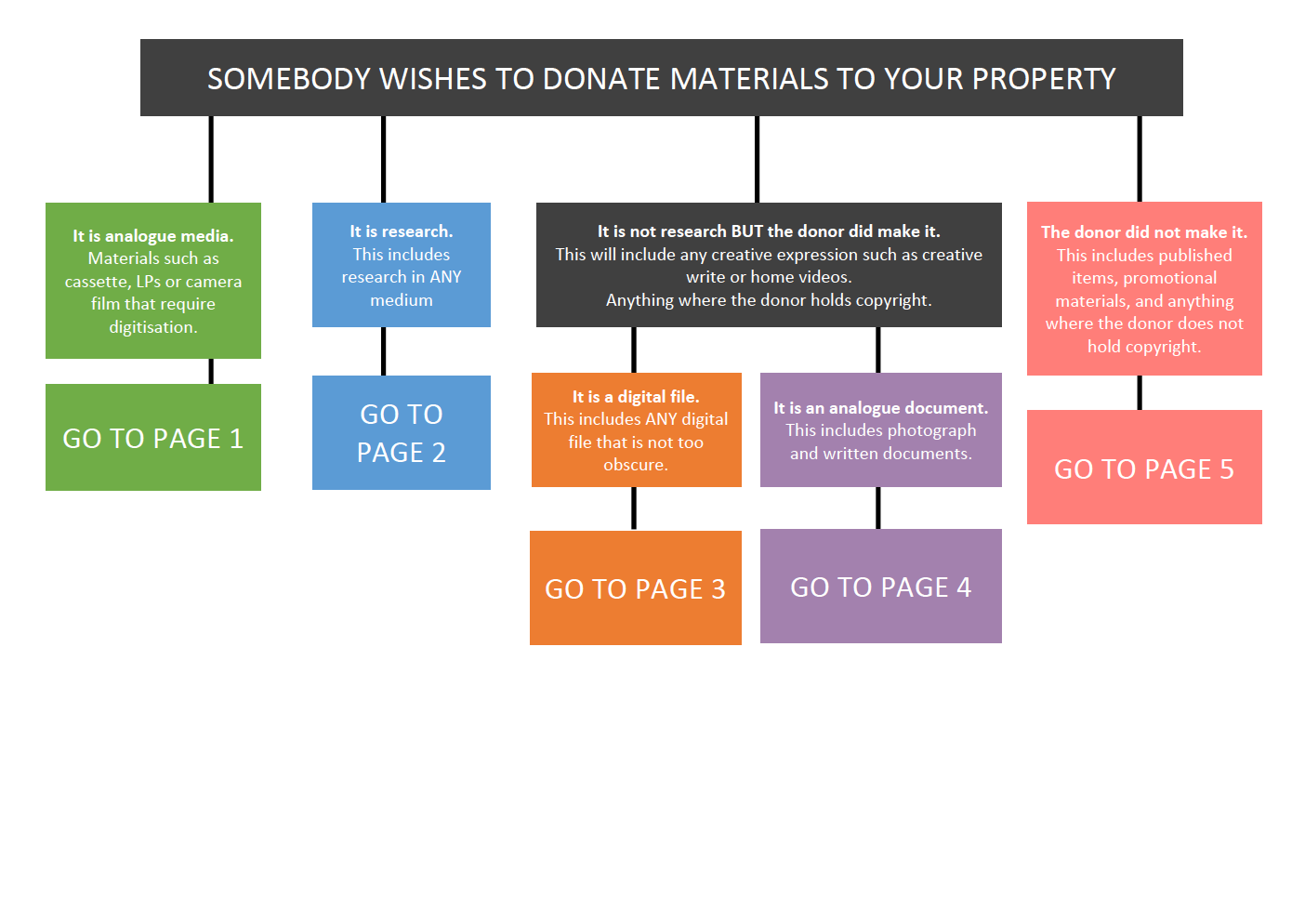
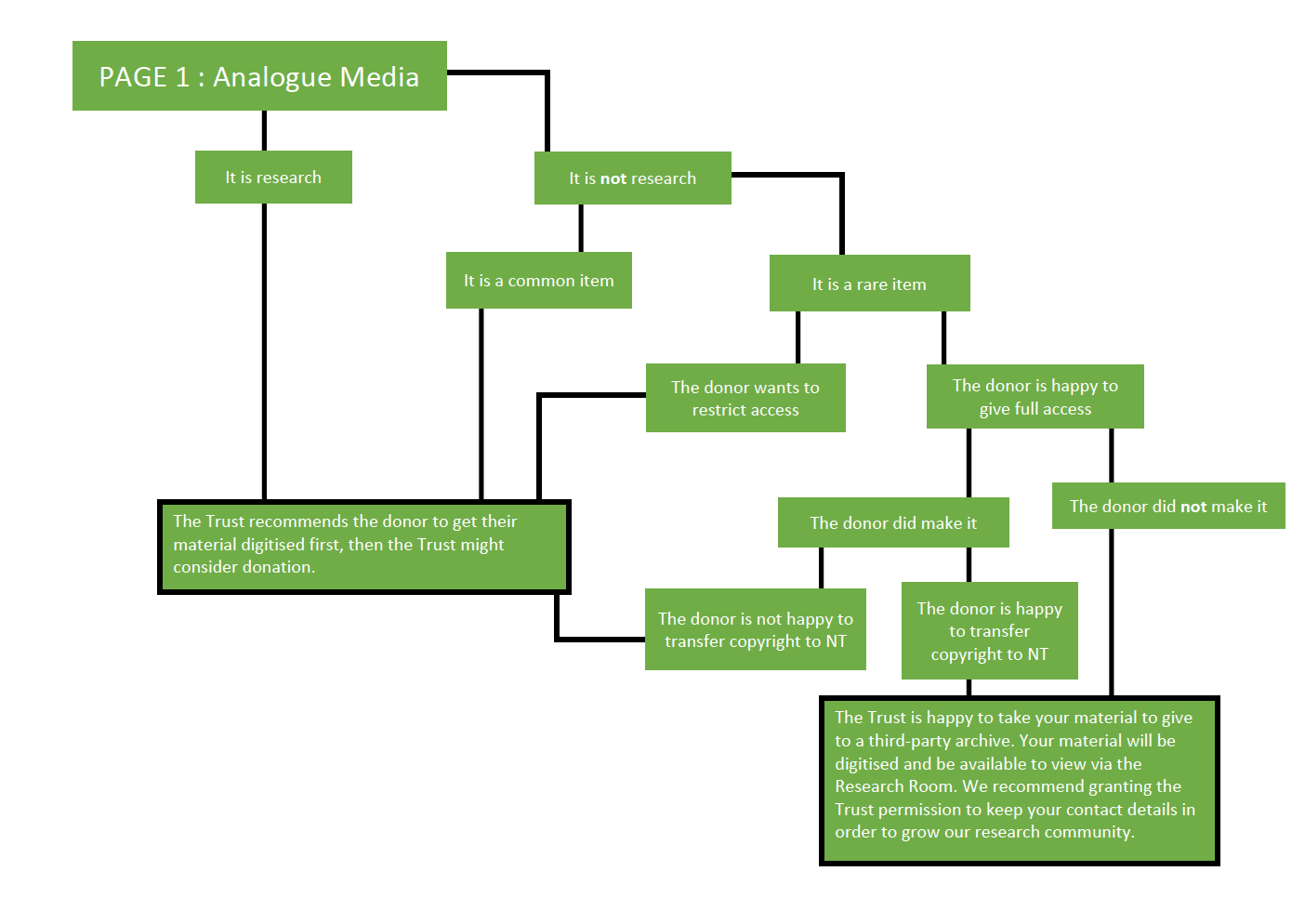
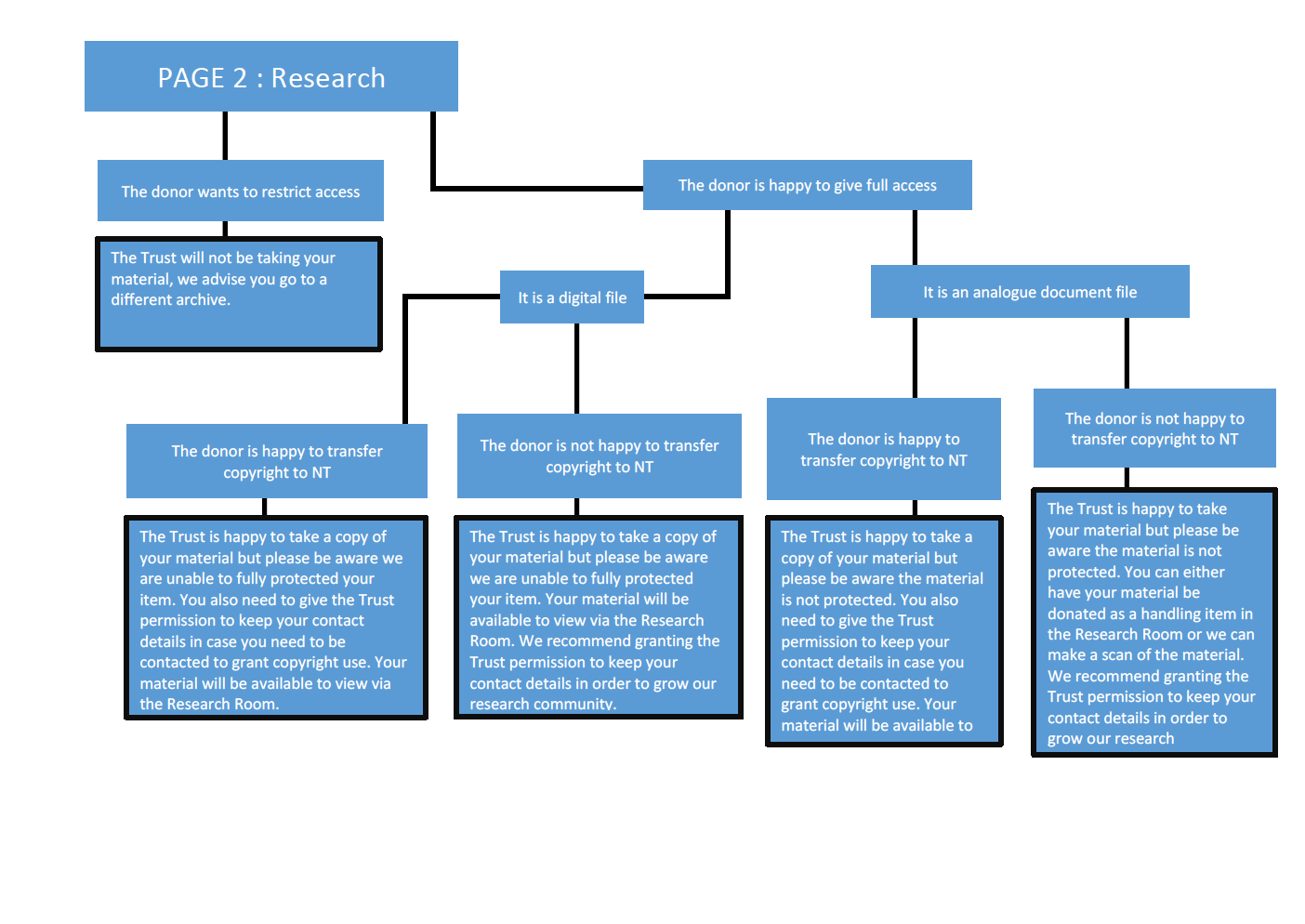
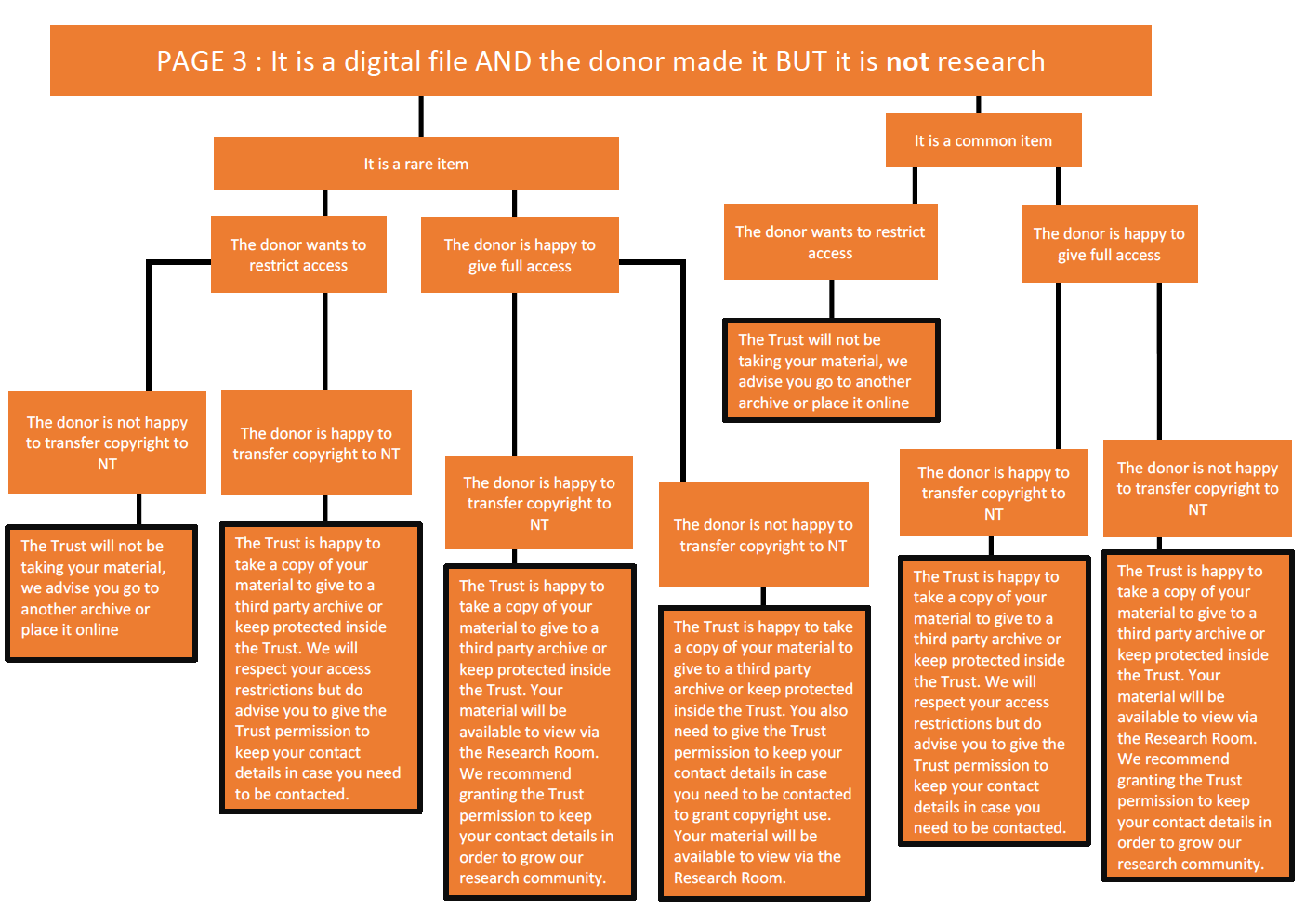
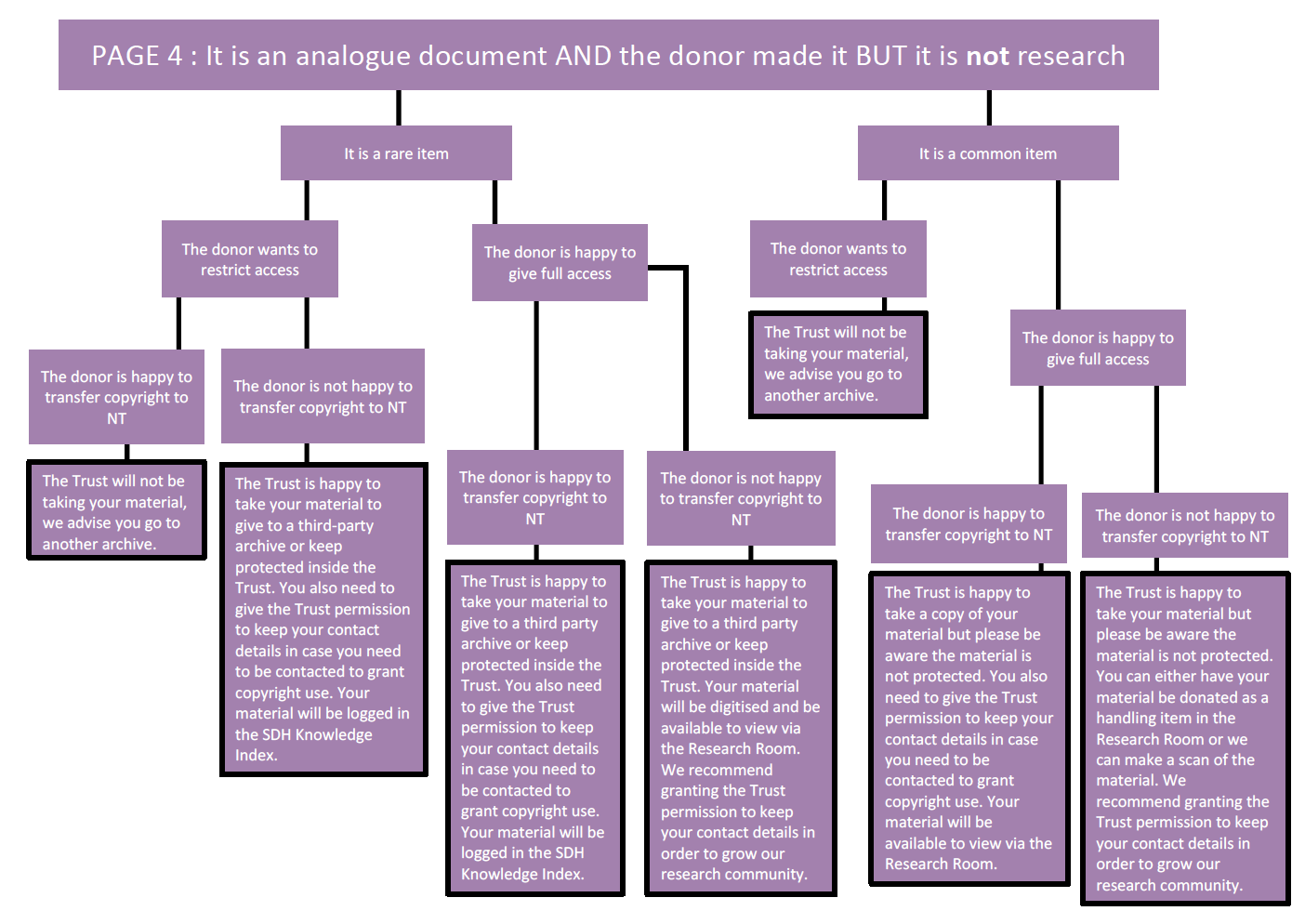
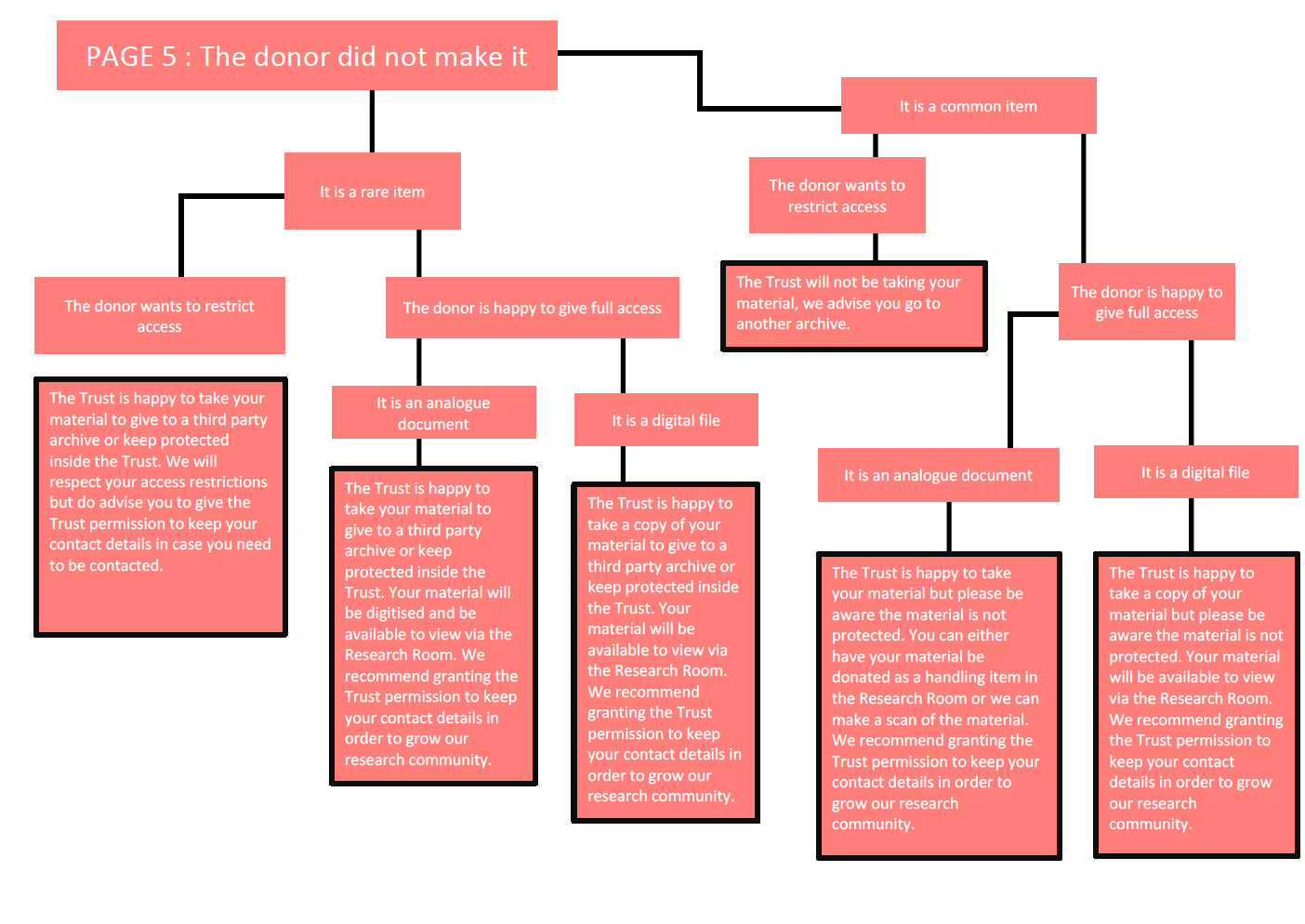
The final flowchart – OHD_DSN_0158
sdh. 011 From these flowcharts I was then able to create prototype forms for the staff and volunteers to use. This included donation agreements, copyright assignment, and researcher agreements.13 Once I had shared and received feedback on the drafts, I was able to finalise the forms with a design similar to the Trust’s existing acquisition forms.14
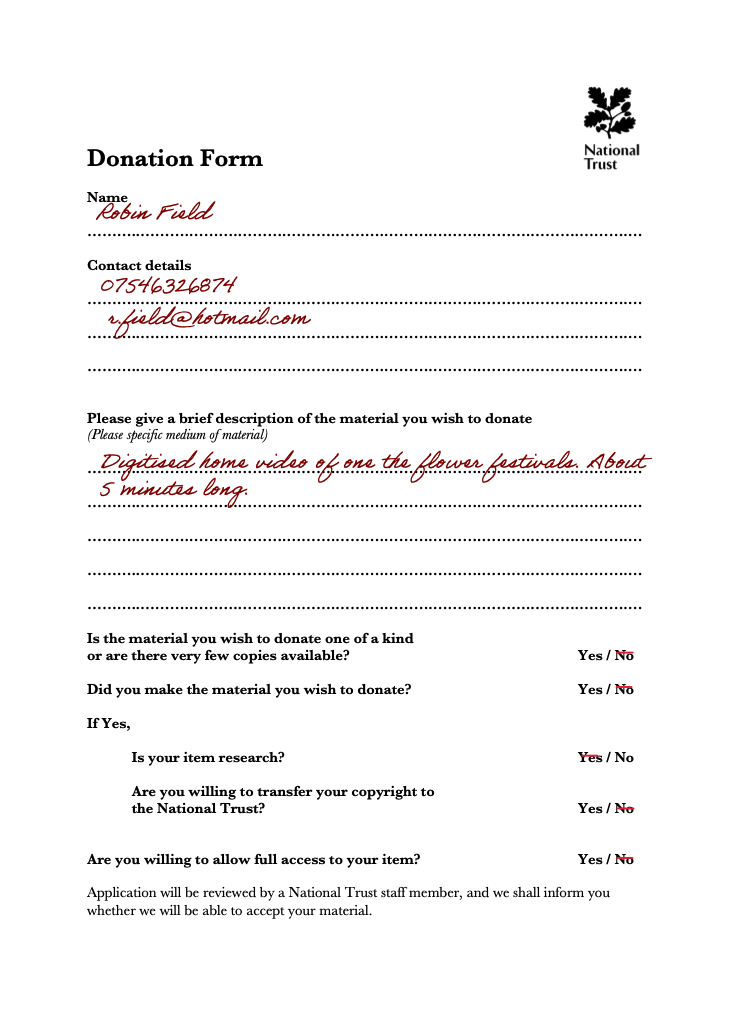
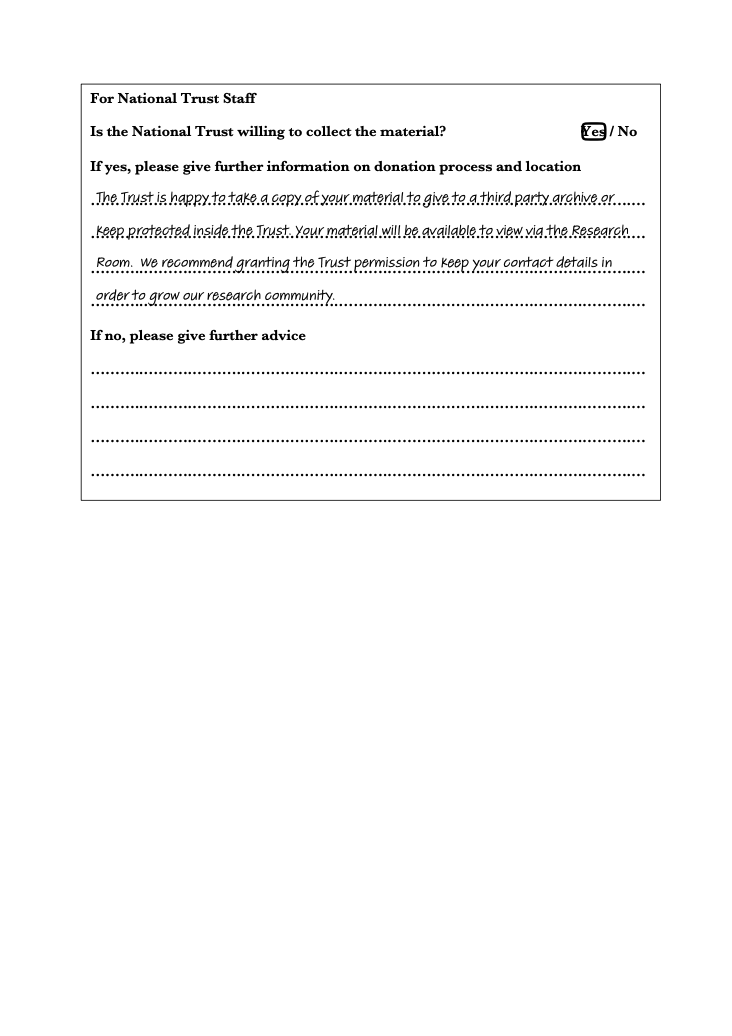

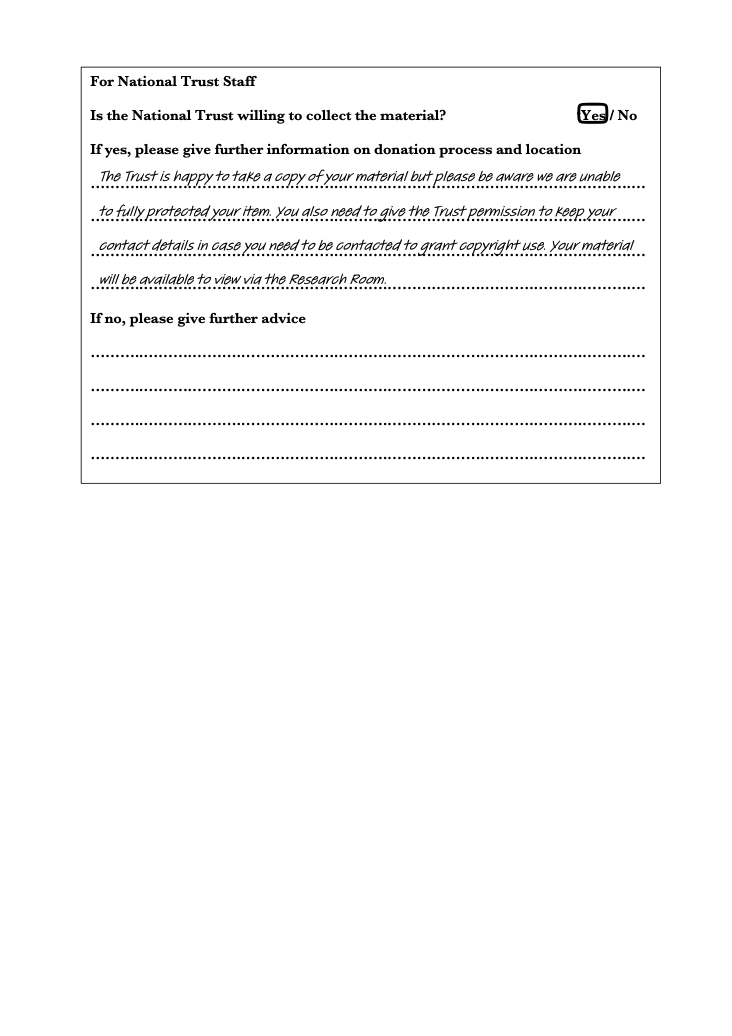
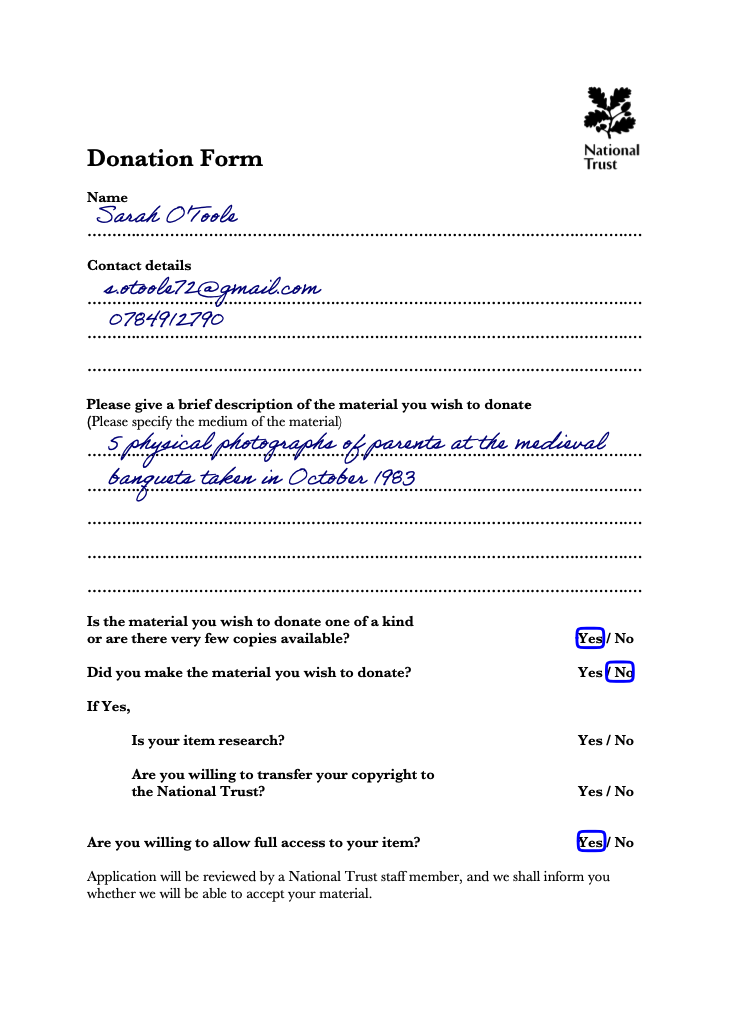
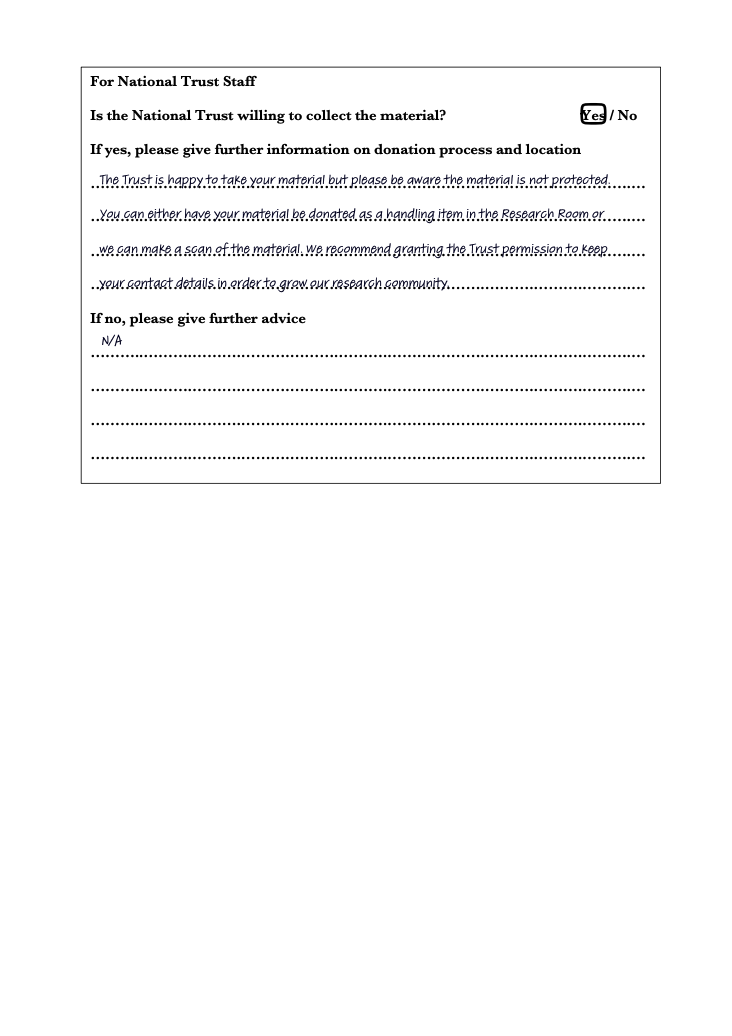
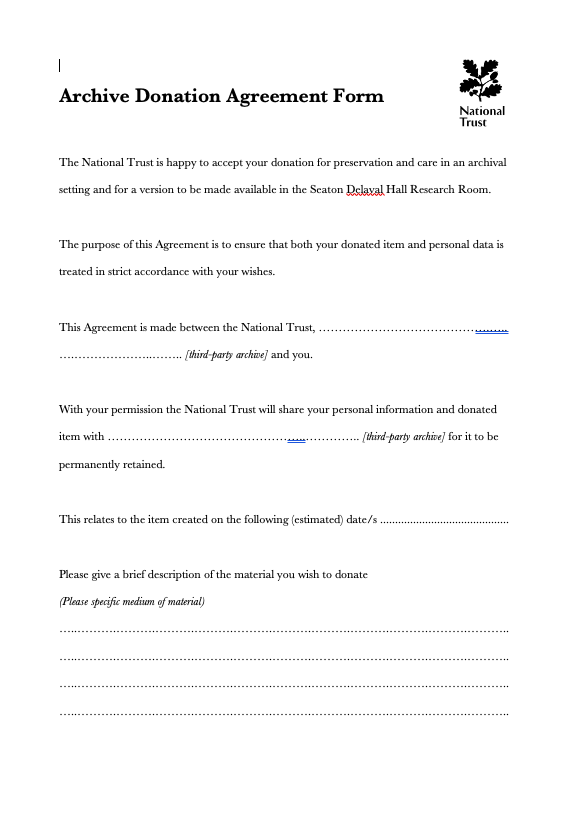
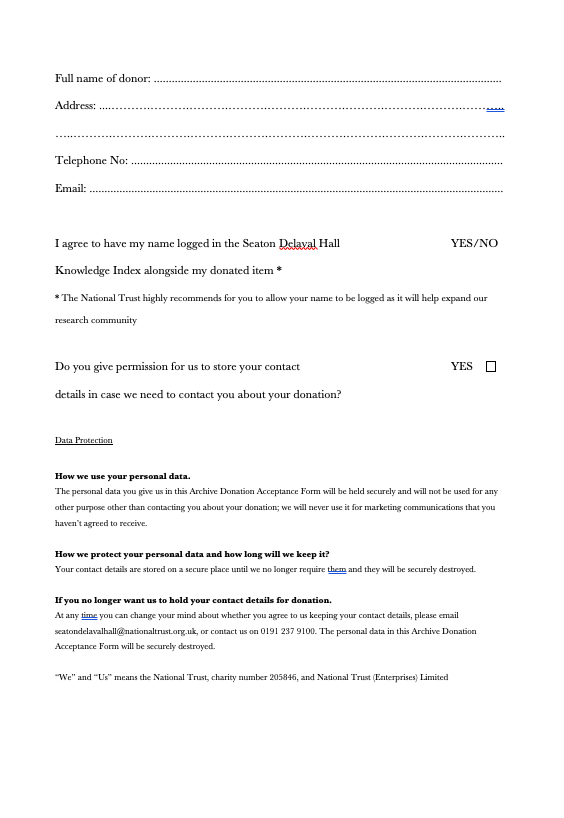
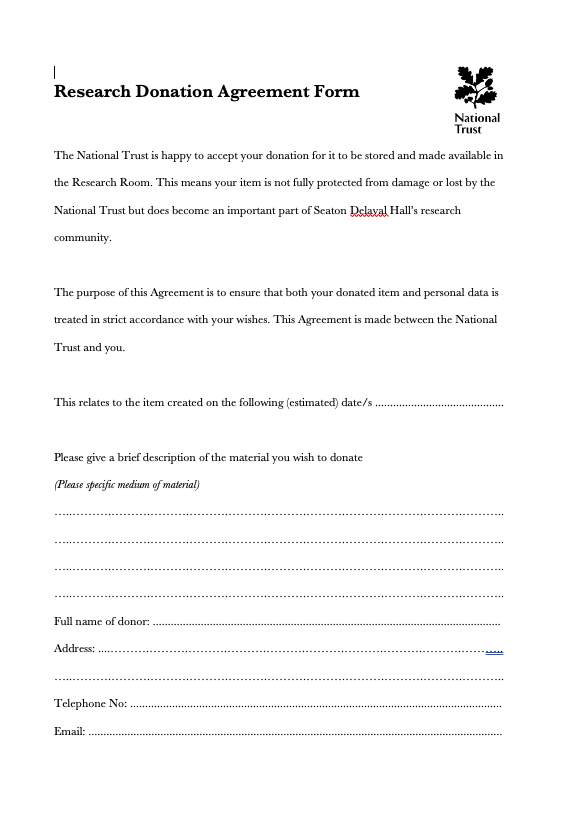

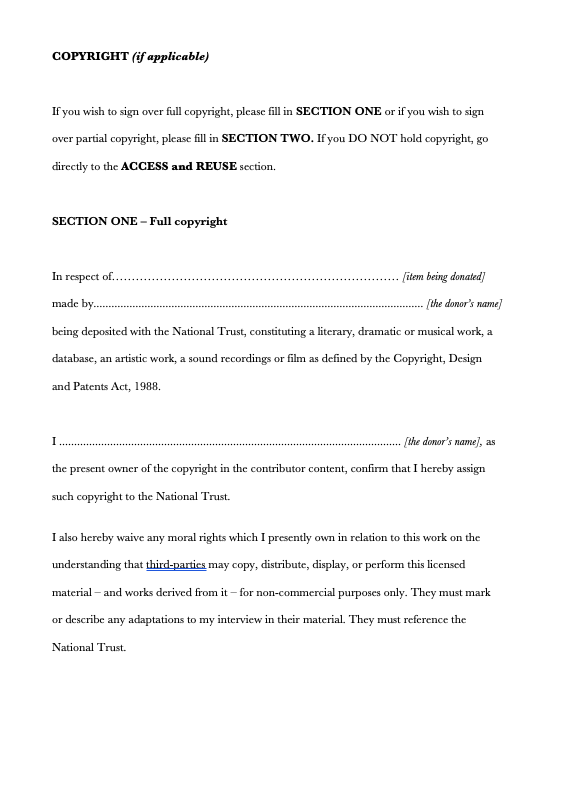
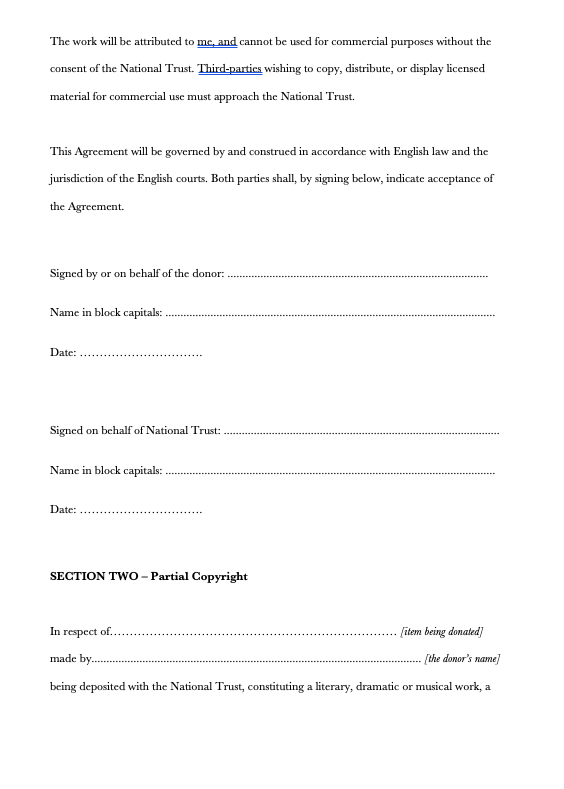
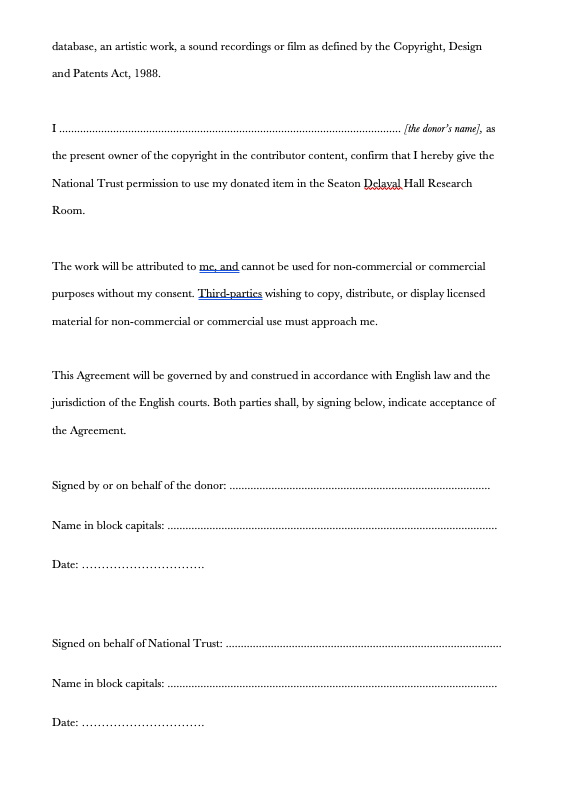
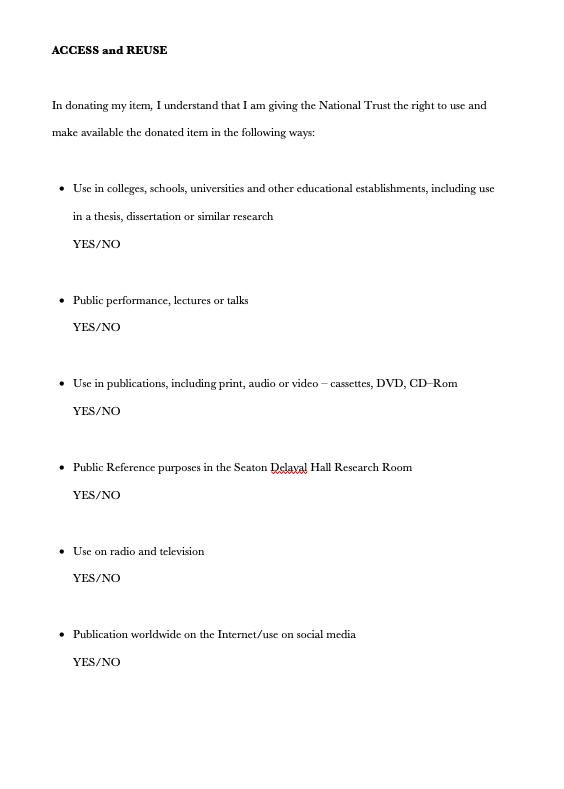

Prototype forms – OHD_FRM_0189, OHD_FRM_0190, OHD_FRM_0191
sdh. 012 Finally, I created a guide to the Research Room, leaving certain areas blank, as I felt I lacked the authority to decide what should or should not happen.15
Chat GPT Summary of OHD_RPT_0195: Guide to SDH Research Room
[generated 20 / 02 / 2025]
The document *OHD_RPT_0195.pdf* appears to be a *Research Room Guide* for Seaton Delaval Hall. It provides guidelines on managing, acquiring, indexing, and accessing research materials within the Research Room. Key topics include:
- **Storage & Organization:** Details on physical and digital storage (e.g., SharePoint, physical archives).
- **Acquisition Process:** Criteria for accepting new research materials and handling copyright agreements.
- **Indexing System:** Methods for cataloging items using digital spreadsheets and index cards.
- **Usage Policies:** Booking procedures, research agreements, and data protection considerations.
- **Volunteers & Staff Roles:** Responsibilities of volunteers in maintaining the Research Room and supporting research efforts.
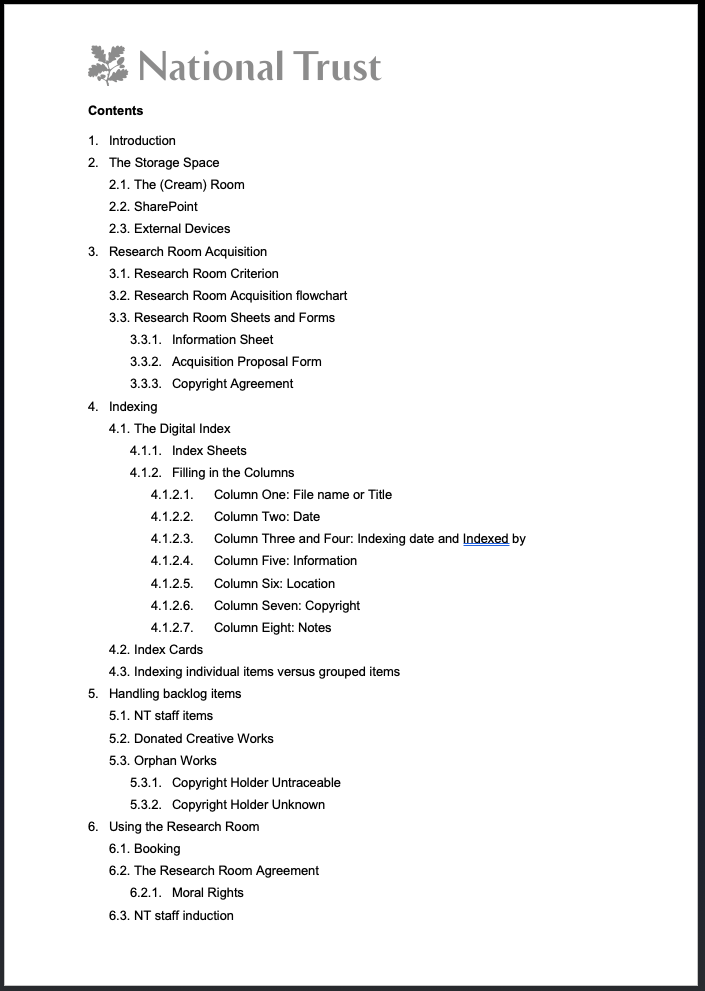
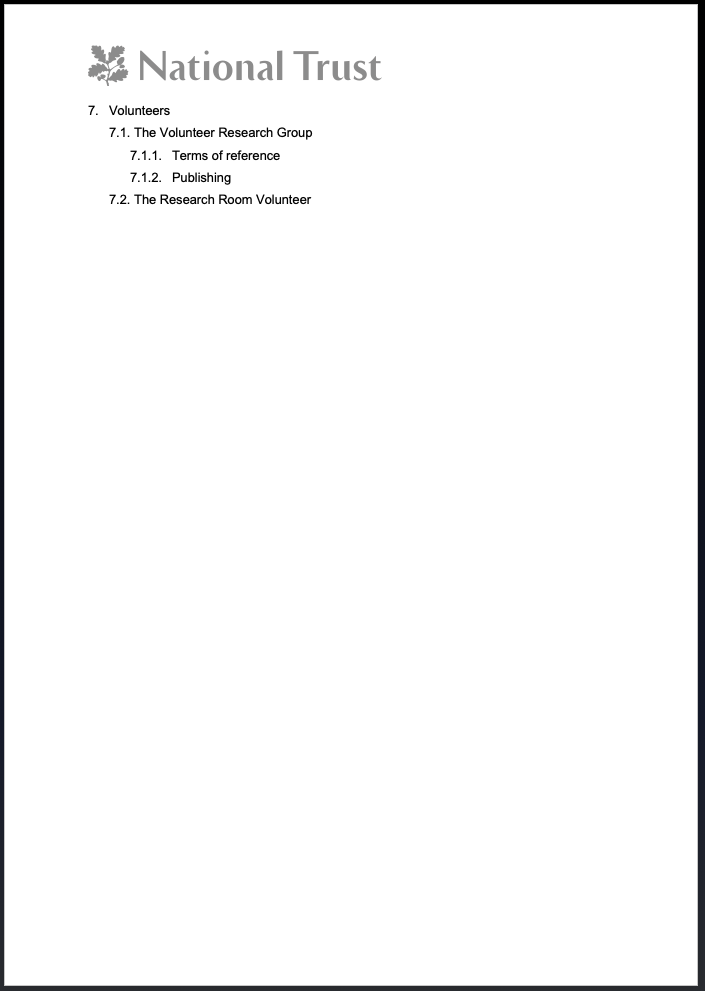
Contents page of OHD_RPT_0195
The Oral History Strategy
sdh. 013 Near the end of my project, I set up a final workshop with the staff at Seaton Delaval Hall. The aim of the workshop was to see how the staff would proceed with oral history once I had finished my PhD. I created a slideshow based on the various stages of oral history recording which I had identified over my studies. The attendees were asked during the workshop to fill in the blank spaces to create the foundations of a plan. As the workshop participants expressed in their feedback forms, certain sections of the slideshow were left blank because, much like my experience writing the guide to the Research Room, they either felt unable to fill in those specific sections or did not see the need to go into detail at that moment.16 However, the overall feeling after the workshop was that they felt confident in integrating oral history into their existing processes. I ultimately condensed the workshop insights into a final oral history strategy for the Hall.17
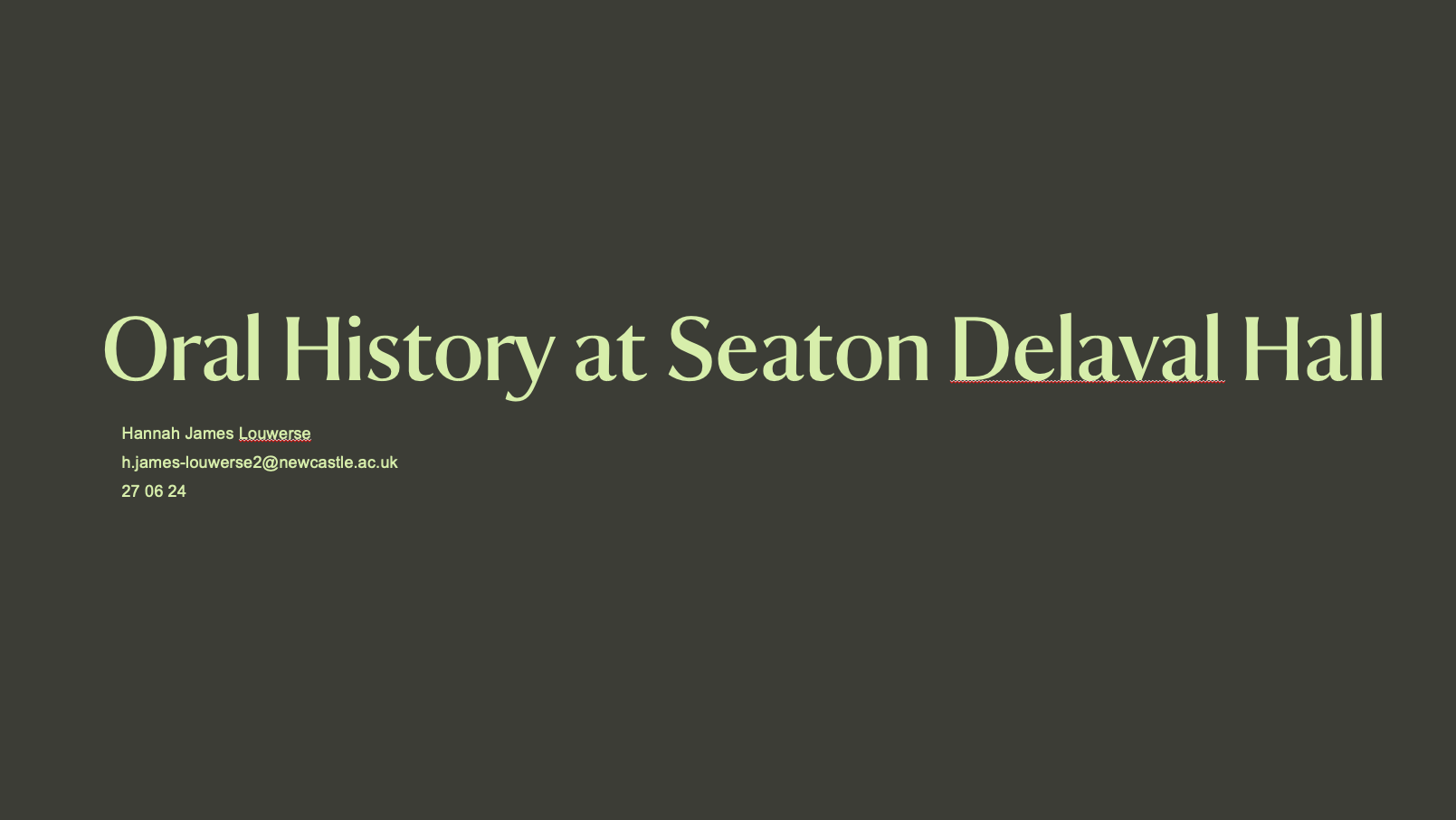
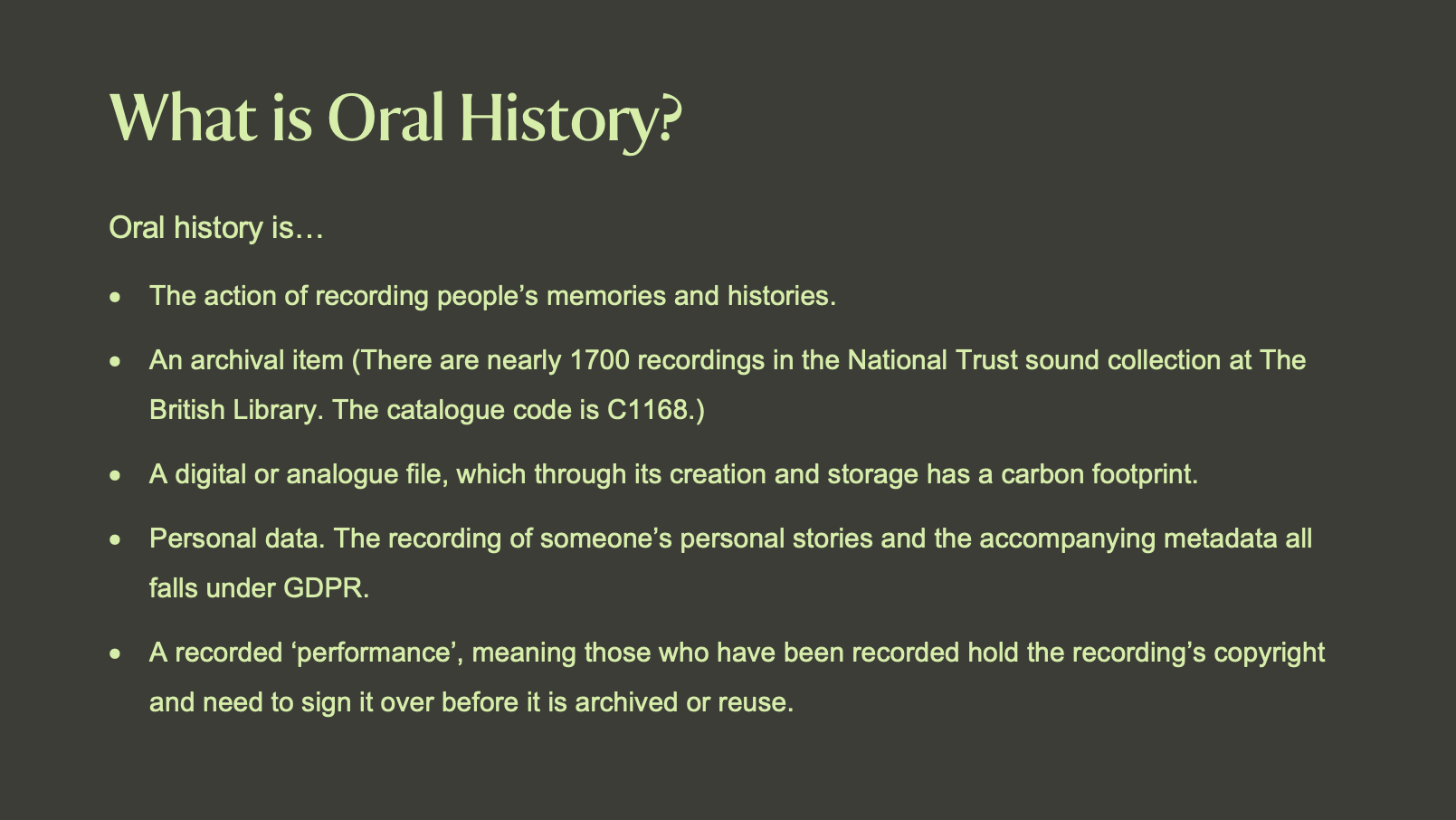
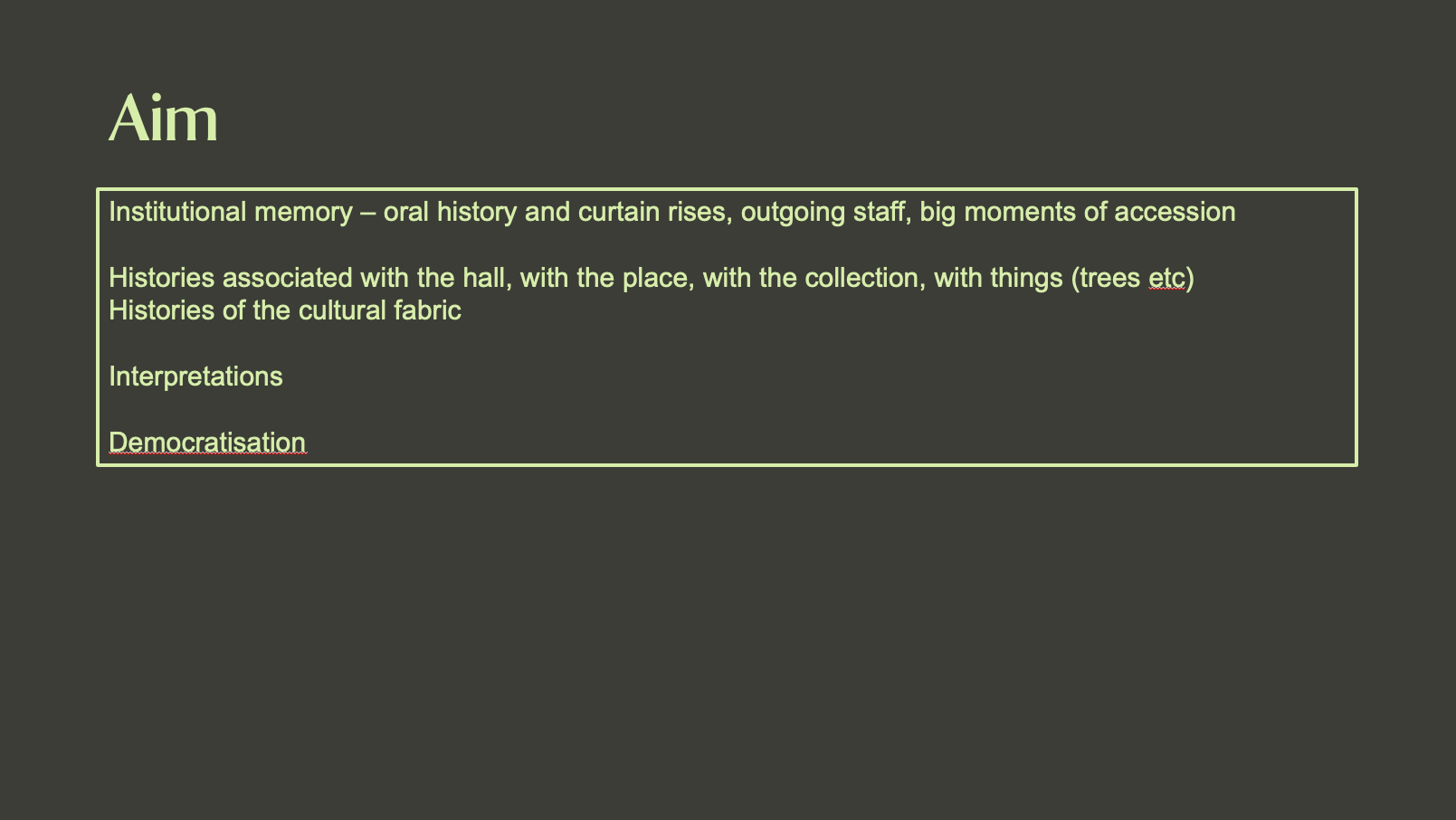

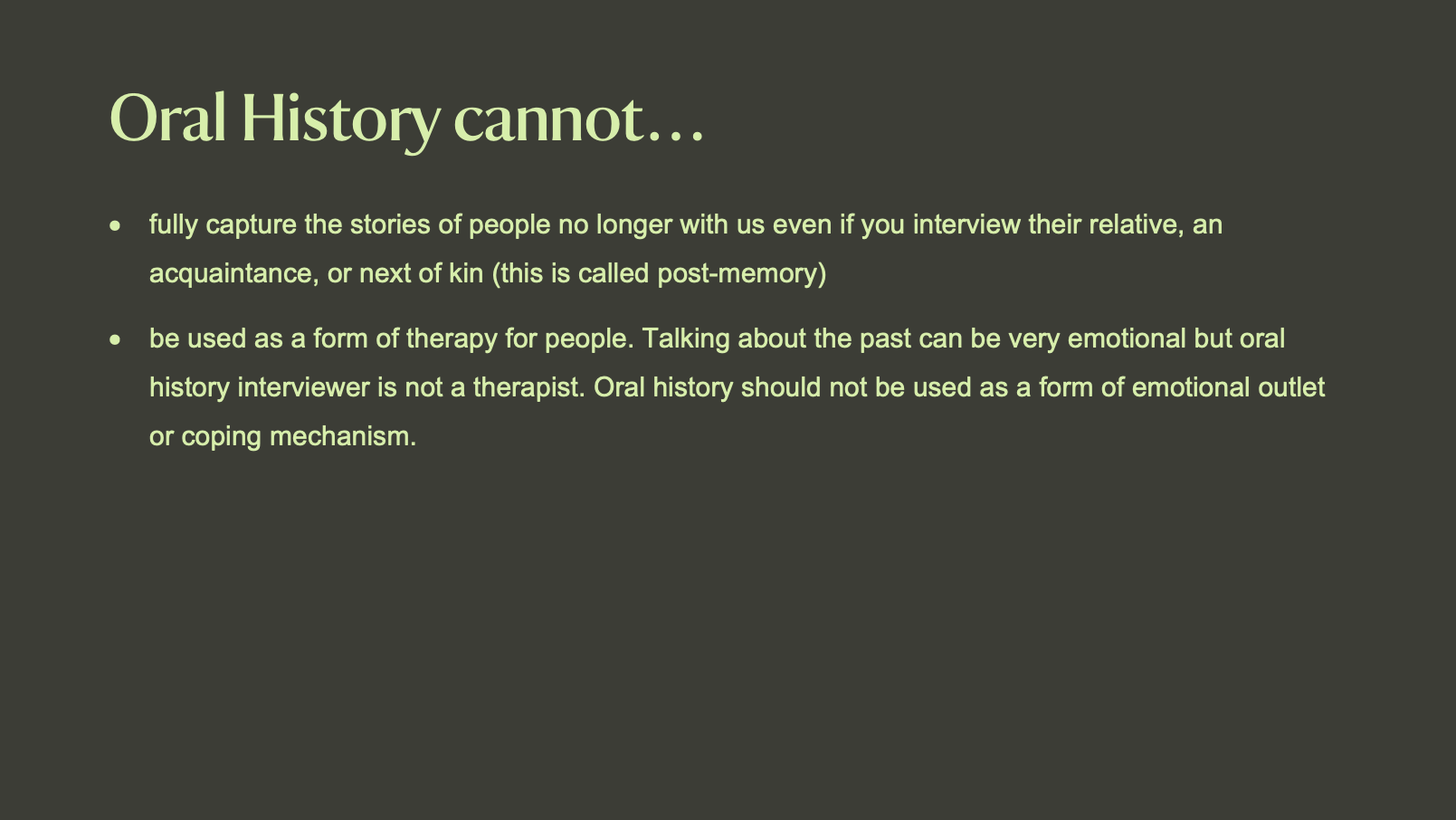
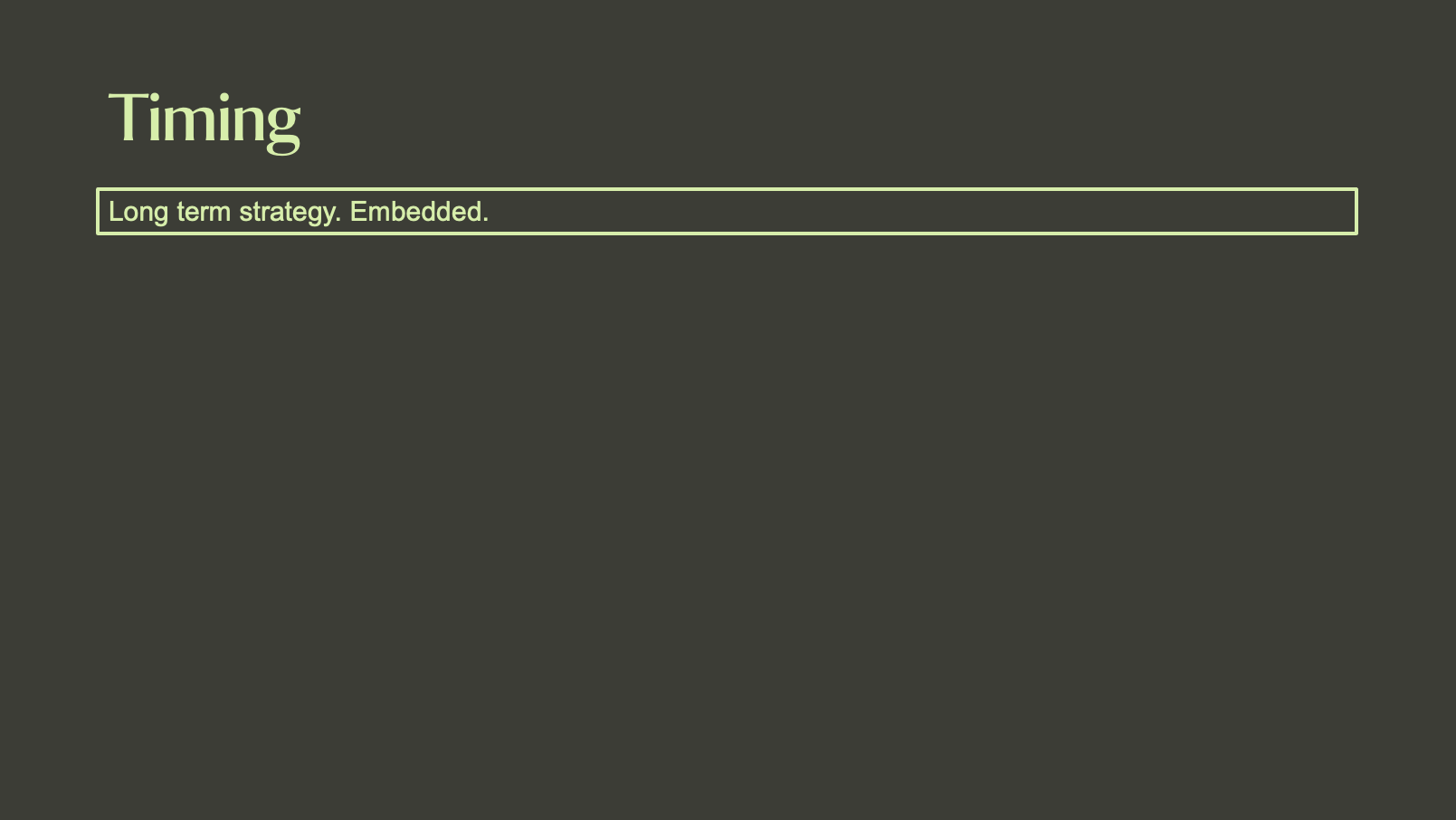

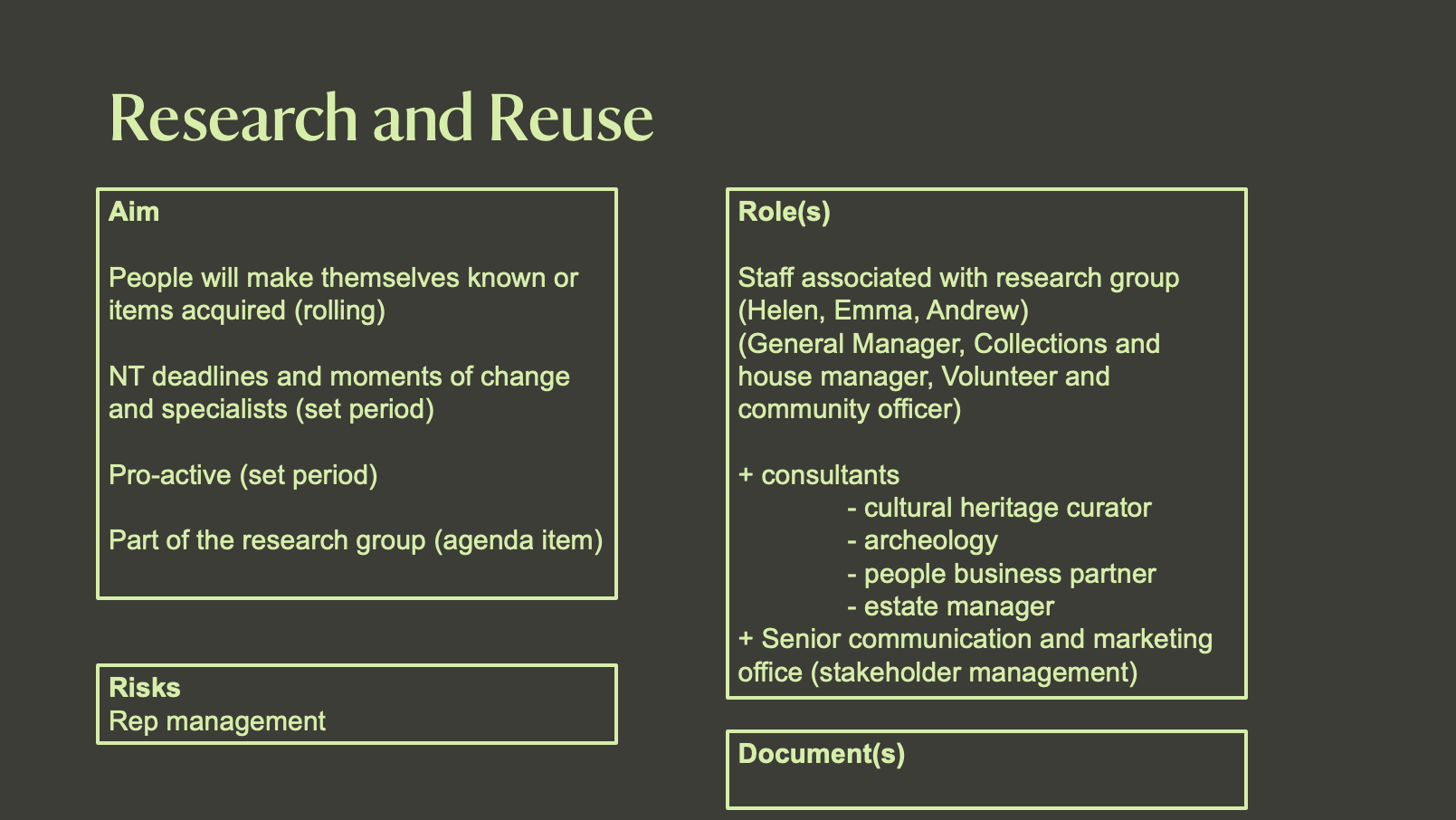
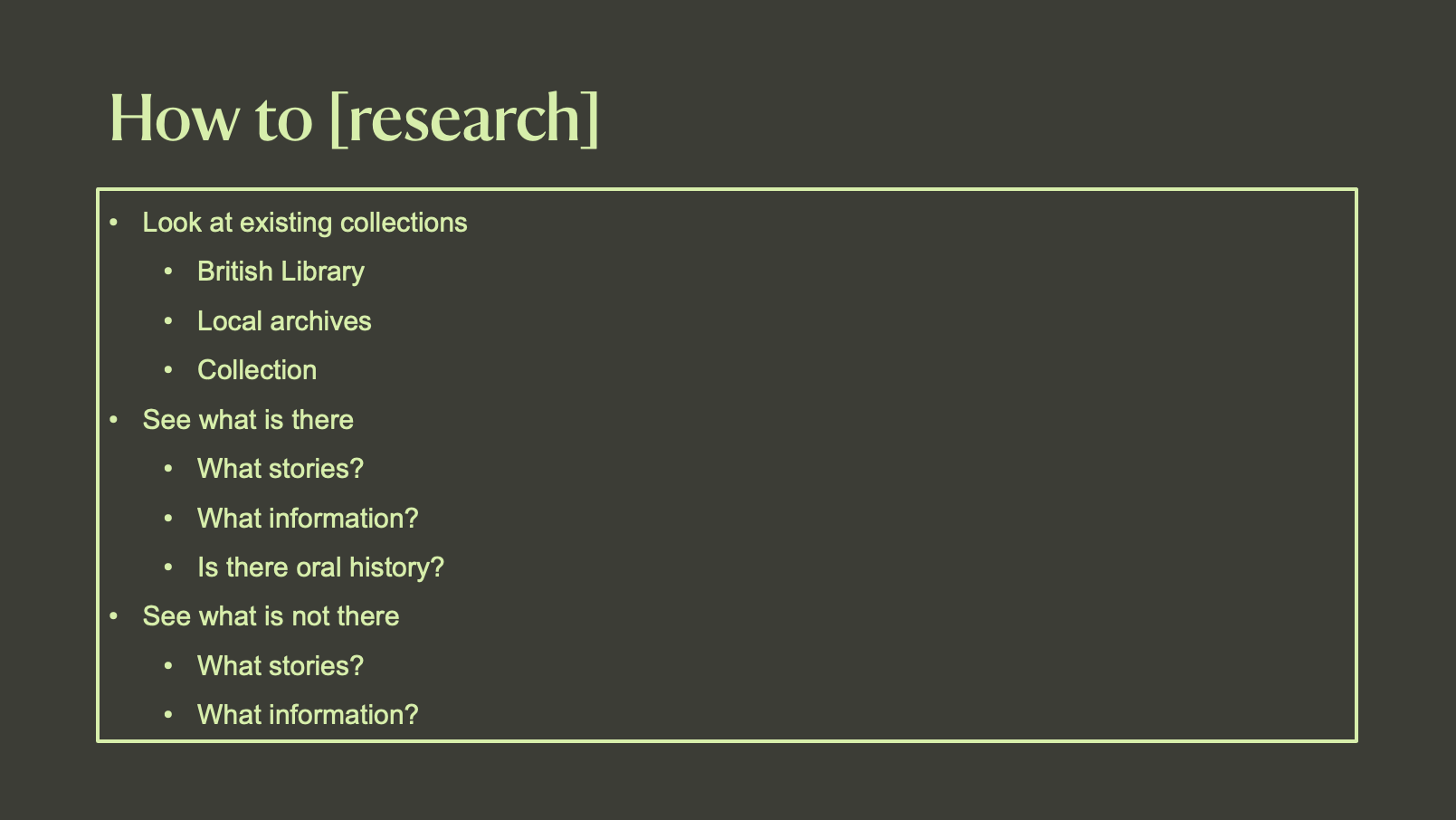
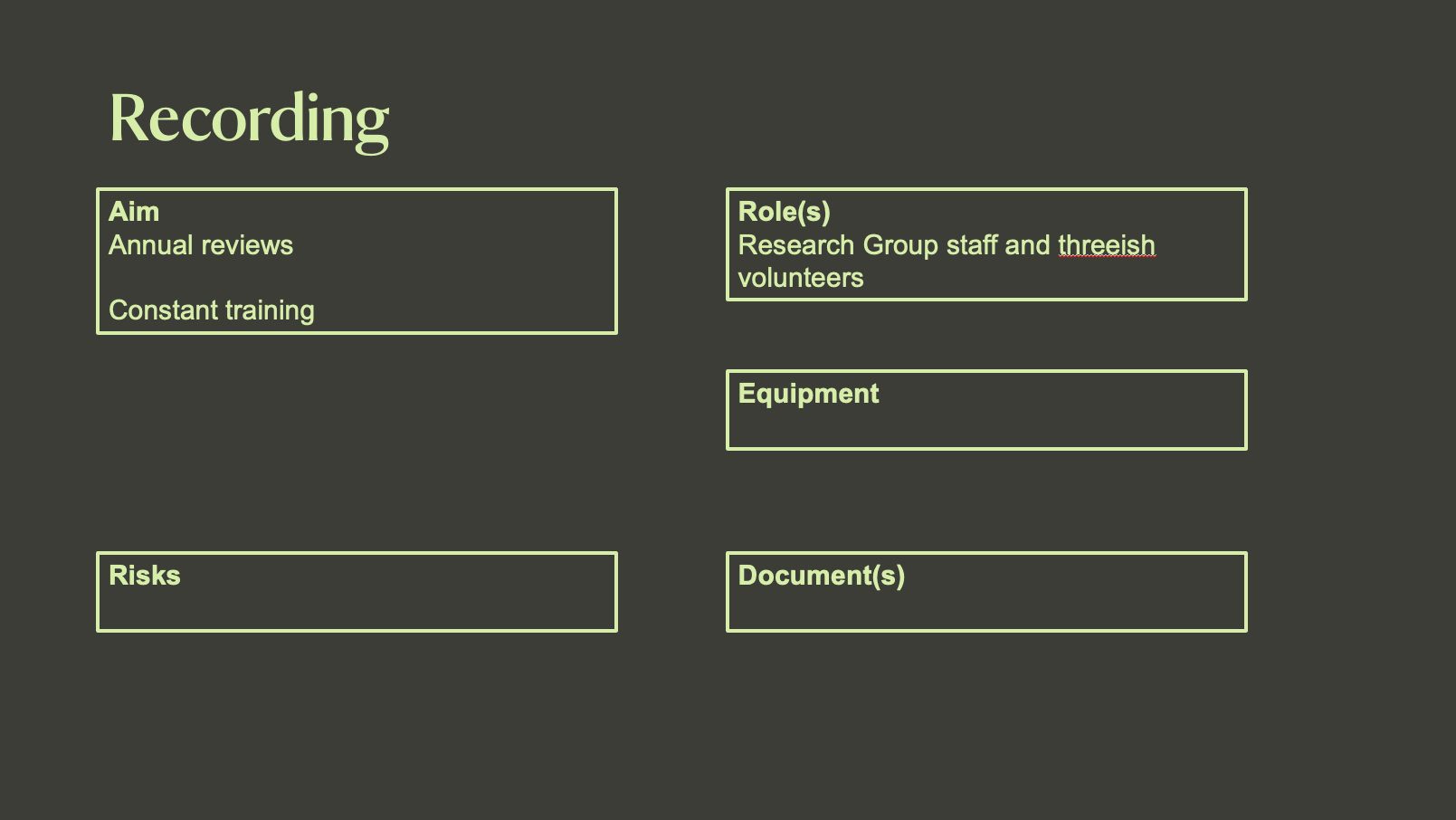
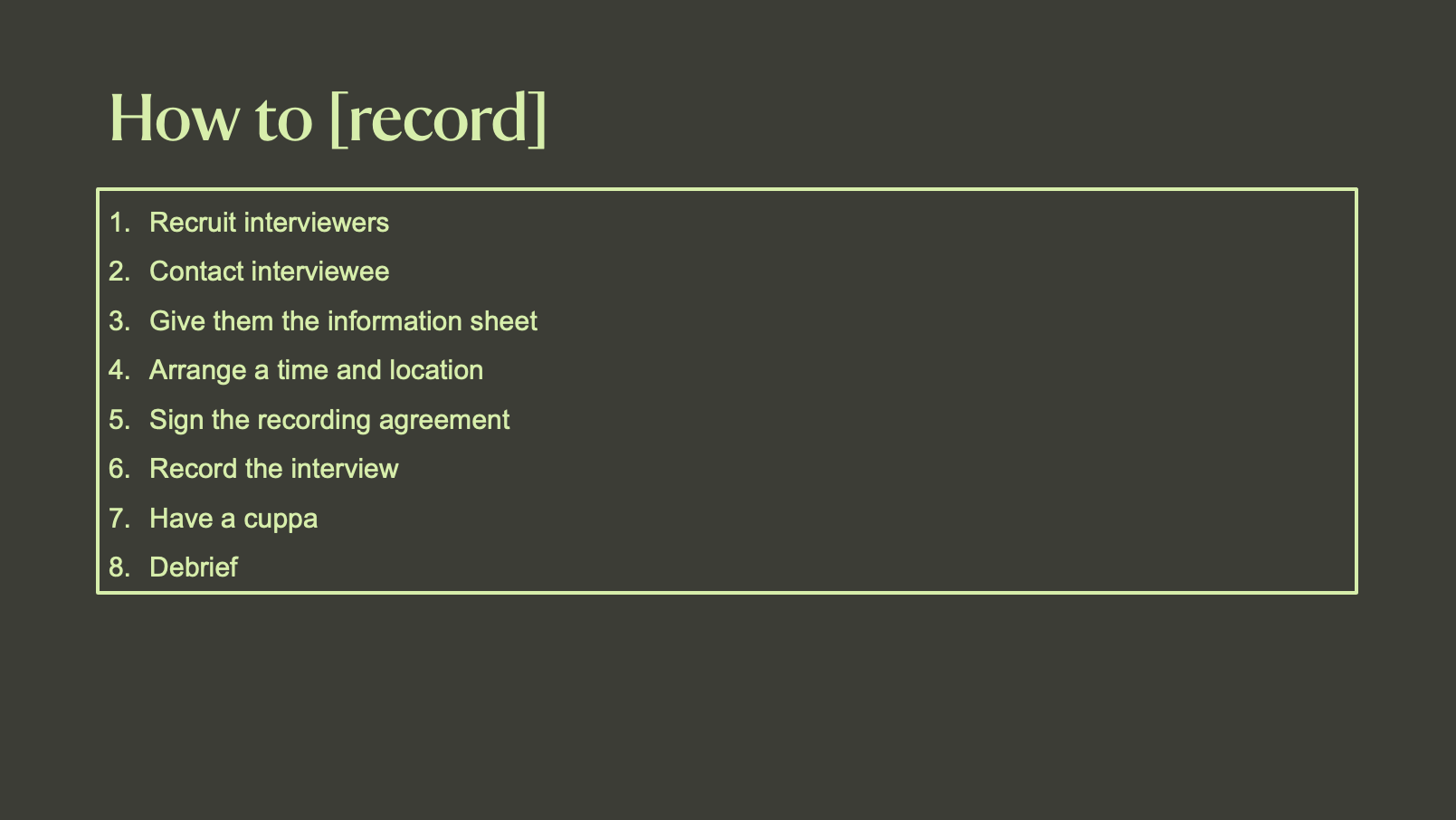
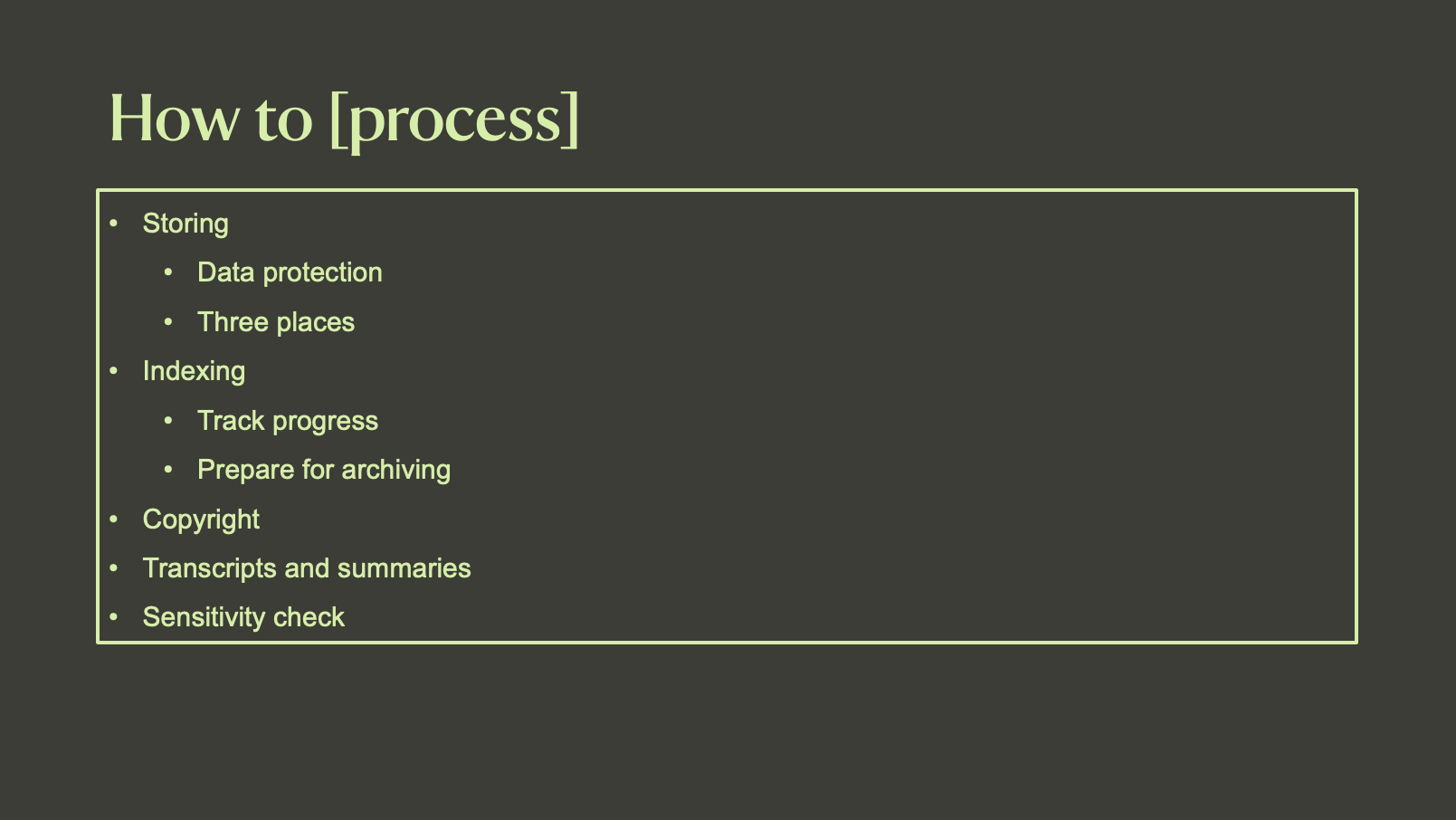
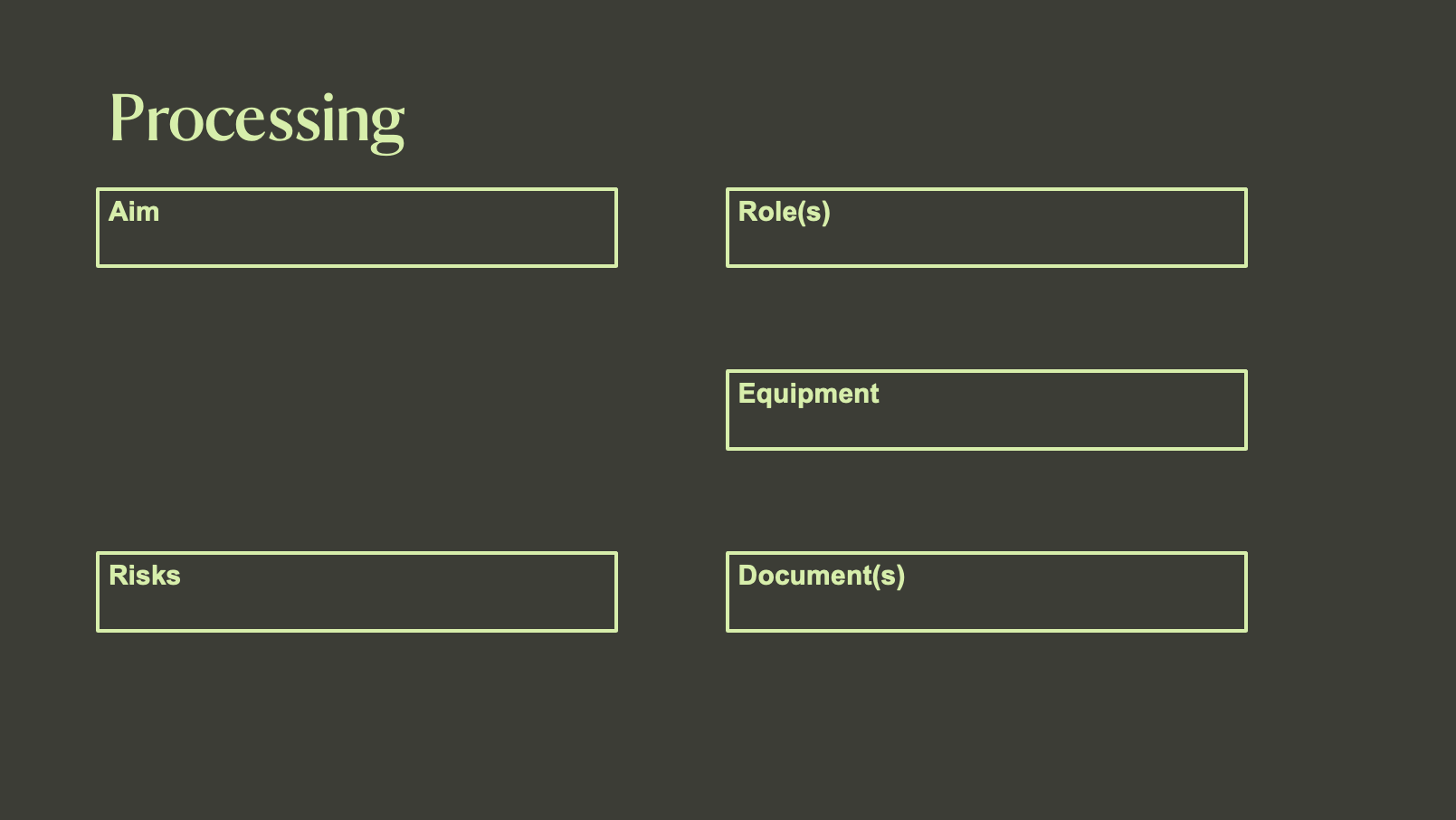

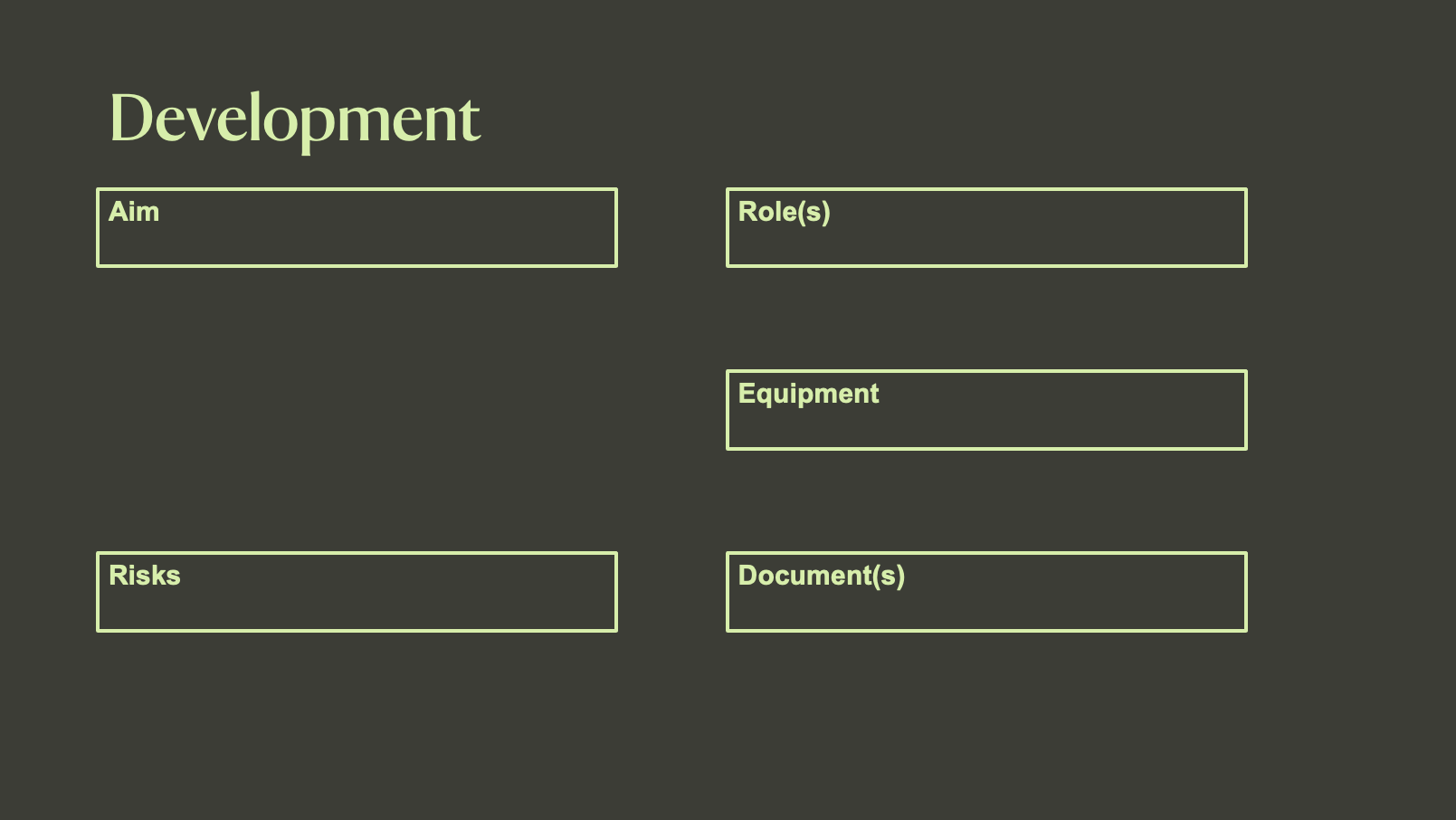
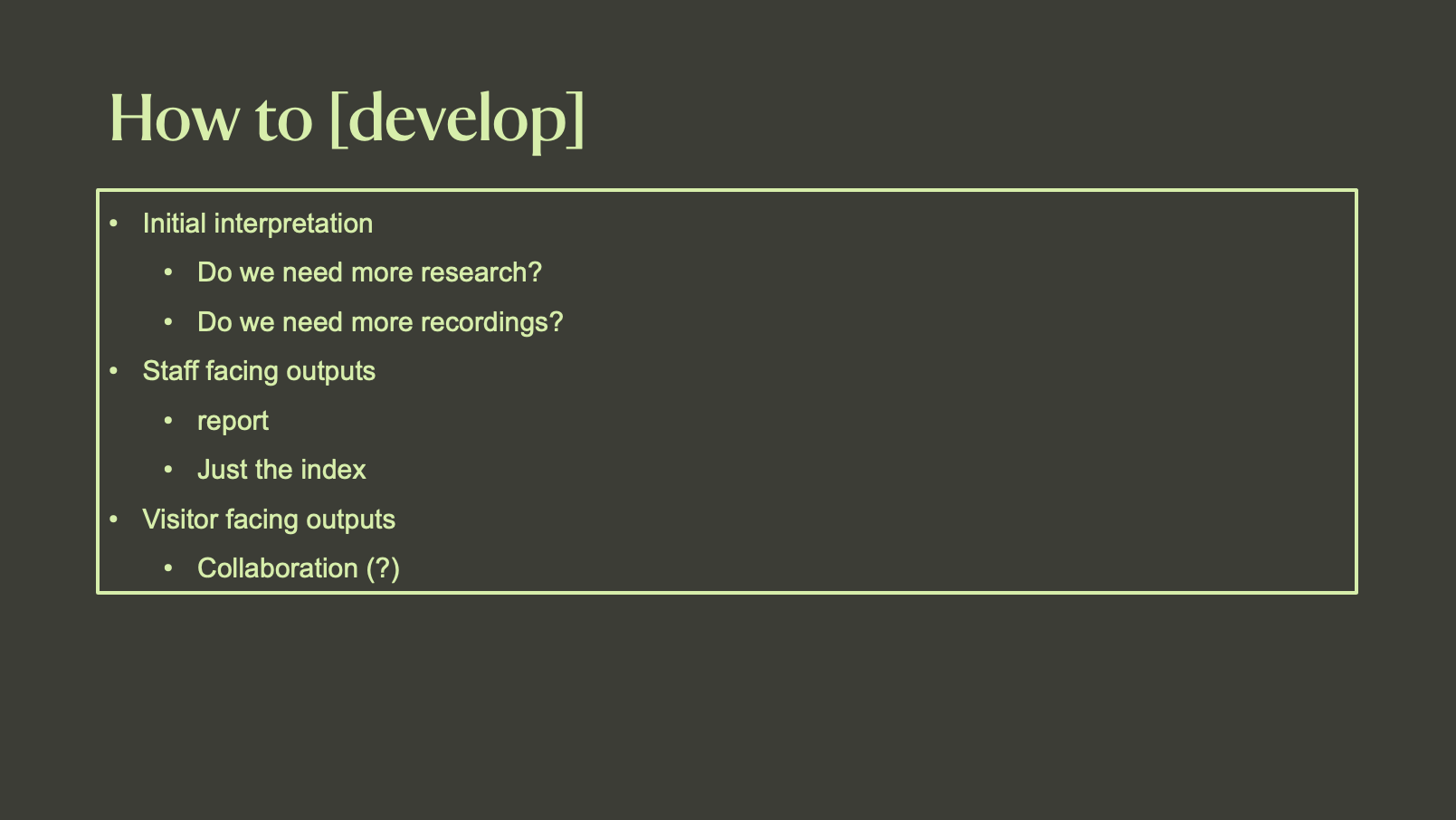
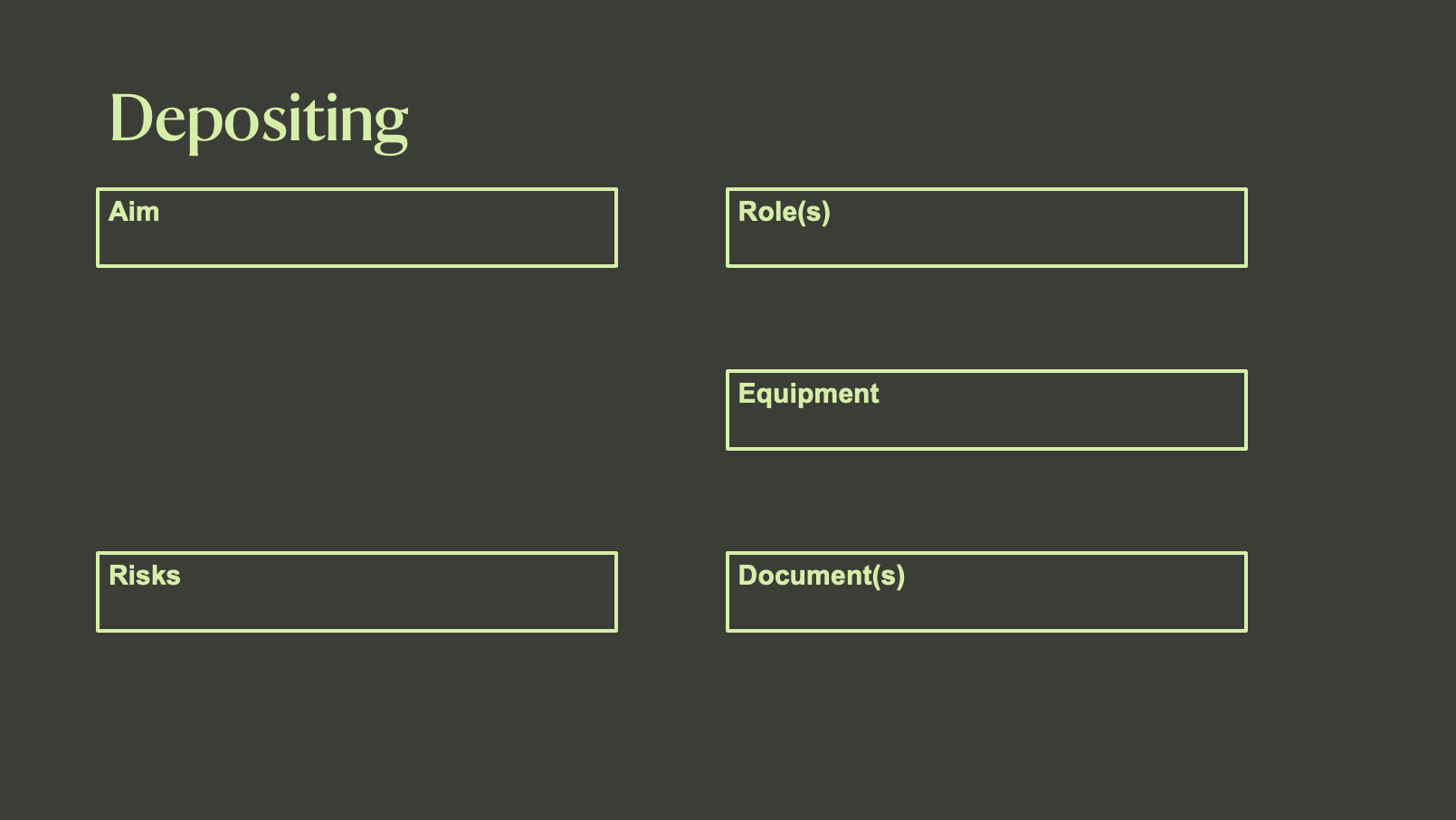
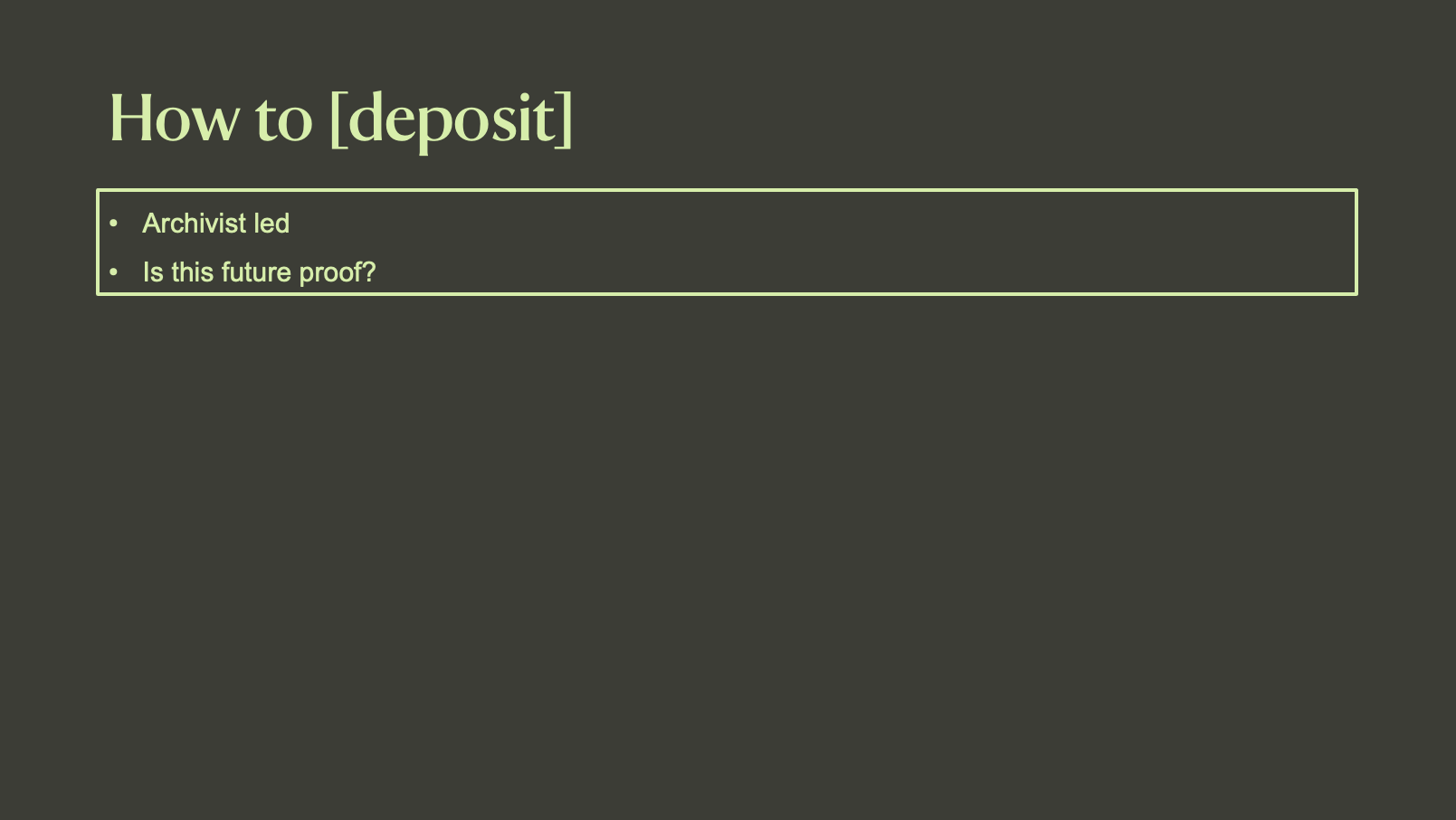
Slides from the SDH oral history strategy workshop – OHD_WKS_0297
Chat GPT Summary of OHD_RPT_0296: SDH oral history strategy
[generated 08 / 03 / 2025]
### **Summary of the Seaton Delaval Hall Oral History Strategy**
#### **Aim**
The strategy seeks to integrate oral history into Seaton Delaval Hall’s research activities, ensuring the ongoing collection, interpretation, and sharing of historical accounts.
#### **Key Components**
1. **Roles & Responsibilities**
- A **Core Oral History Team** (General Manager, Collections & House Manager, Volunteer & Community Officer) will oversee training, recording, volunteer recruitment, and content reviews.
- **Volunteers** will play a key role in conducting interviews, managing data, and transcribing recordings.
- **Site & Regional NT Staff** will assist in identifying interview candidates and ensuring ethical compliance.
2. **Collection Focus**
- **Institutional Memory**: Recording the restoration, management, and maintenance of the Hall.
- **Cultural History**: Documenting the Hall’s collections, gardens, and surrounding area.
- Oral history collection will be proactive, integrated into knowledge-gathering practices.
3. **Training & Processing**
- Staff and volunteers will receive training in interviewing, recording, and processing oral histories every three years.
- **Interim Storage**: Digital files will be stored securely in three locations, following data protection laws.
- **Ethics Compliance**: Interviews require a **Recording Permission Form** (signed before recording) and a **Copyright & Reuse Form** (signed after review).
- **Sensitivity Checks** will identify content that interviewees may want restricted and flag potentially upsetting material.
4. **Archiving & Access**
- Indexed recordings will be stored at Northumberland Archives (MP3 format) and potentially at the British Library (WAV format).
- Summaries and transcripts will be created to improve accessibility and searchability.
5. **Reusing Oral Histories**
- Oral histories will support exhibitions, staff training, and historical research, ensuring they are as accessible as other collection items.
#### **Conclusion**
The strategy embeds oral history into Seaton Delaval Hall’s operations, preserving knowledge and making it a valuable resource for heritage interpretation and future research.
- James Louwerse, H., Apr 24, 2024, Email about copyright. OHD_Archive. OHD_SSH_0309. ↩︎
- James Louwerse, H., Sep, 2022, Copyright and reuse forms. OHD_Archive. OHD_FRM_0226. ↩︎
- James Louwerse, H., Aug 7, 2024, Listening session audios. OHD_Archive. OHD_AUD_0295. ↩︎
- Joseph Plaster, ‘Safe for whom? And whose families? Narrative, urban neoliberalism, and queer oral history on San Francisco’s Polk Street,’ The Public Historian 42, no. 3 (2020): 86-113; Elspeth H. Brown, and Myrl Beam, ‘Toward an ethos of trans care in trans oral history,’ The Oral History Review 49, no. 1 (2022): 29-55; Amy Starecheski, ‘South Bronx soundwalks as embodied archiving practice,’ Oral History 48, no. 2 (2020): 102-112. ↩︎
- James Louwerse, H., Aug 7, 2024, Feedback from listening session. OHD_Archive. OHD_PST_0289. ↩︎
- James Louwerse, H., Nov 3, 2022, Prototype for the Seaton Delaval Hall Oral History Trail. OHD_Archive. OHD_PRT_0199; James Louwerse, H., Oct, 2022, The first draft design of the Seaton Delaval Hall sound walk. OHD_Archive. OHD_DSN_0225. ↩︎
- See the National Trust section for why there is non-collection material. ↩︎
- James Louwerse, H., Aug 20, 2022, Design Fiction Research Room. OHD_Archive. OHD_DSF_0182. ↩︎
- Bruce Sterling, Shaping Things, (The MIT Press, 2005). ↩︎
- Tony Fry, Writing design fiction: Relocating a city in crisis, (Bloomsbury Visual Arts, 2022), 2. ↩︎
- See The Practice section for more on this. ↩︎
- James Louwerse, H., Sep 8, 2022, Research Room Donation Flowchart. OHD_Archive. OHD_DSN_0158. ↩︎
- James Louwerse, H., Sep 16, 2022, Donation Form and examples. OHD_Archive. OHD_FRM_0189; James Louwerse, H., Oct 3, 2021, Archive Donation Acceptance Form. OHD_Archive. OHD_FRM_0190; James Louwerse, H., Sep 29, 2022, Research Room Donation Acceptance Form. OHD_Archive. OHD_FRM_0191. ↩︎
- James Louwerse, H., Oct 31, 2022, Research Room Acquisition Copyright form. OHD_Archive. OHD_FRM_0192; James Louwerse, H., Oct 25, 2022, Research Room Acquisition Proposal. OHD_Archive. OHD_FRM_0193; James Louwerse, H., Nov 1, 2022, Research Room Agreement. OHD_Archive. OHD_FRM_0194. ↩︎
- James Louwerse, H., Oct 31, 2022, Research Room Guide. OHD_Archive. OHD_RPT_0195. ↩︎
- James Louwerse, H., Jul 1, 2024, SDH OH questionnaire. OHD_Archive. OHD_FRM_0303. ↩︎
- James Louwerse, H., Aug 5, 2024, SDH oral history strategy. OHD_Archive. OHD_RPT_0296. ↩︎
